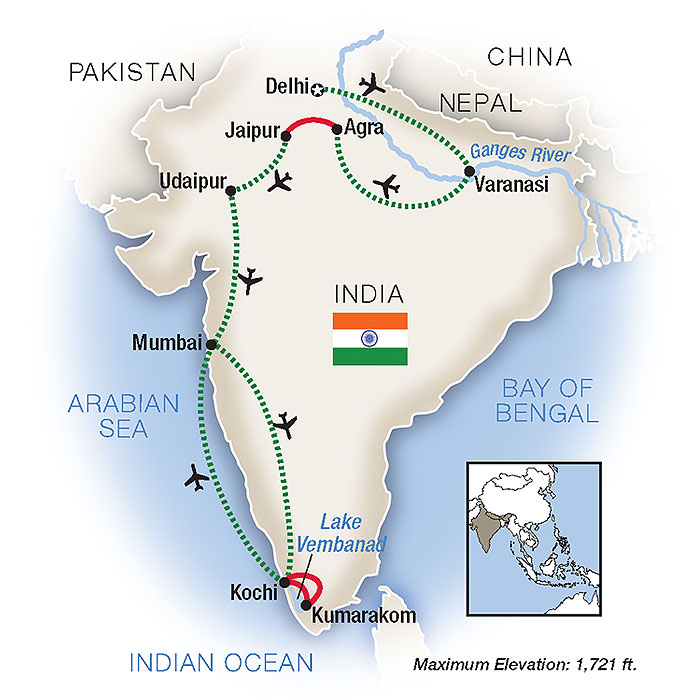
A Portrait of India
October 20 - November 6, 2024
Mike and Judy Henderson
People who have gone to India report that it is a fascinating place, and I've always wanted to see the Taj Mahal. On the Tauck travel forum, people who took this Tauck tour raved about the hotels and the sights they saw.
I don't know when it's the best time to go to India - it
seems that it's always hot. We discussed dates with our travel advisor,
Jennifer, and decided on late October and early November. Just by
happenstance we'll be in India for
Diwali (the
Indian festival of lights),
which is
from
Most people celebrate Diwali on the third day. Because of that you'll see Diwali listed as being on October 31st.
One suggestion before you go. The electrical adapter you need for India is the Type D adapter. We got three of them before we left and having the correct adapter was an advantage. Many of the outlets are worn, which makes the plug loose if you use a Type C plug, but if you use the Type D adapter it's much tighter. The UK adapter will also work for most outlets and is also tight.
Also, US citizens need a visa to go to India. It's easy to get the visa on their website, although they ask a lot of questions. I did the one year visa which is a bit more expensive than the 90 day tourist visa because I could do it further out from the trip.

++++++++++++++++++++++++++++++++++++++++++++++
10/16/2024 (Wednesday) We're all set. We packed yesterday, and Greg came over this morning to set up at our place. He will stay in our house and take care of the girls, our two Cavalier King Charles spaniels.

We're so fortunate that he can mostly work from home at our place, and he wants to help.
Just to show off our "kids," here are Annie and Lizzie. Lizzie is next to me and Annie is on the outside. They're litter mates and spoiled rotten, as all dogs should be.
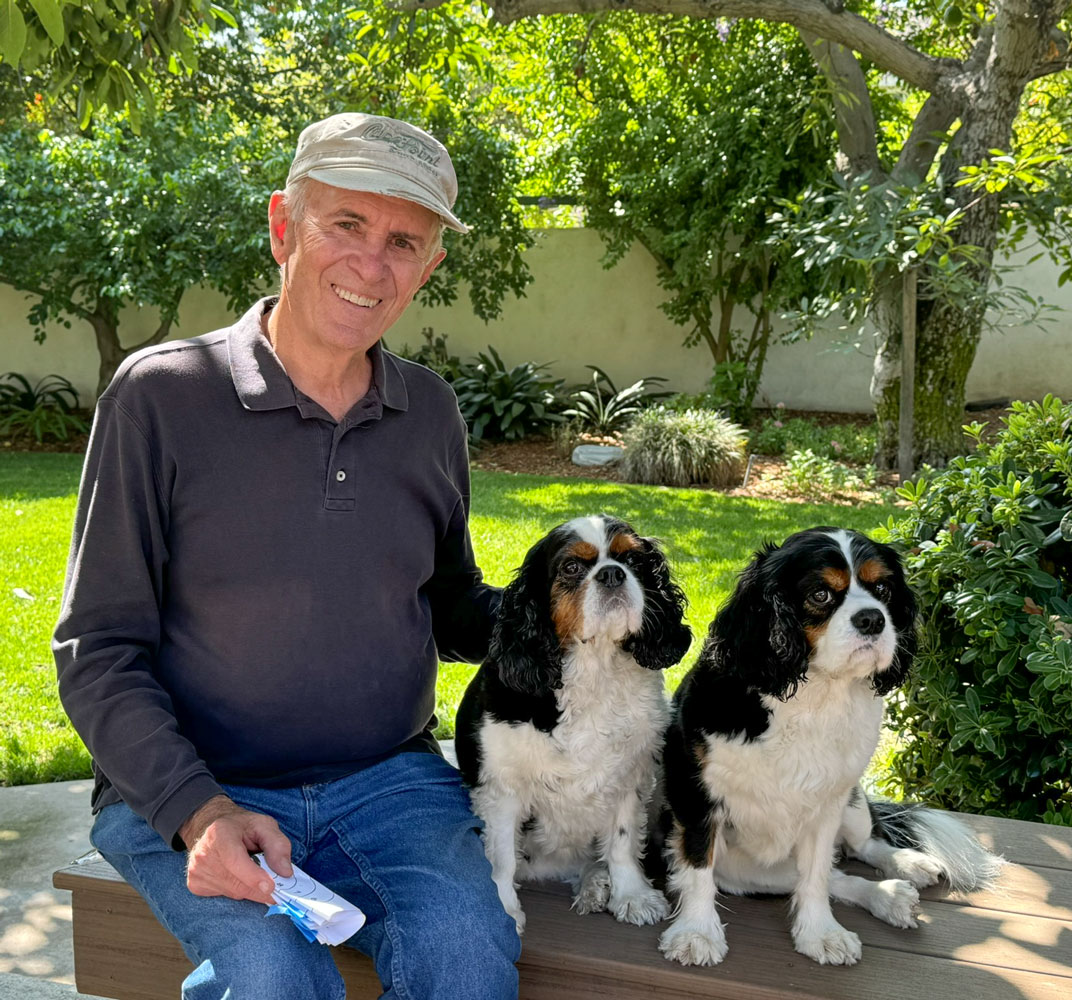
The limo driver arrived a bit early. Here we are with our traditional "pre-tour" photo.
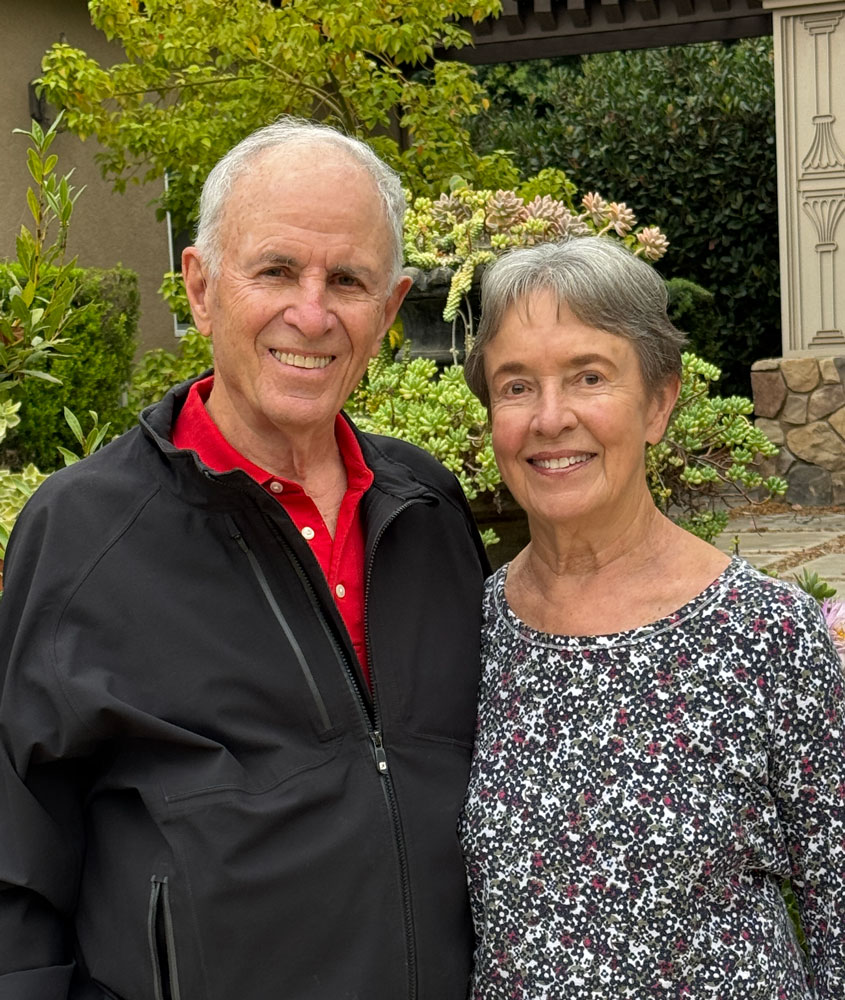
Loading the suitcases.
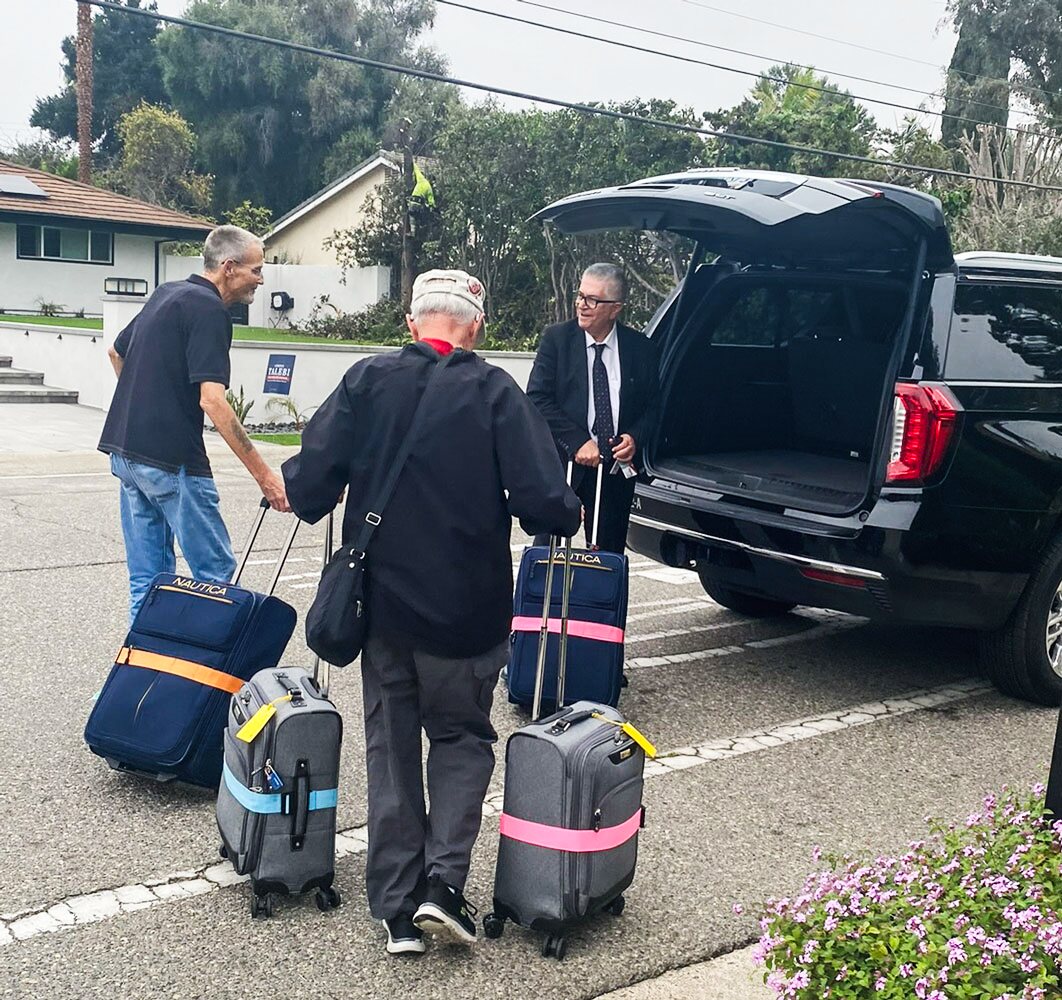
Greg and Lynn were there to see us off.

We weren't more than fifteen minutes away from the house when Lynn called to say that the gate on her driveway would not open - and she had an appointment to make. She could take my car - different driveway - but Greg got involved and was able to get the gate open. We all agreed that we'd leave the gate open until we got back.
We really appreciate Greg helping. He's actually working today but took the time to get the gate open.
Traffic was not bad and we got to LAX in less than an hour. Our driver was very chatty - too much so.
We checked in with Qatar. The seat layout on the plane was 1-2-1 in Business Class. We originally had two window seats, but that would not allow us to converse easily. The gate agent offered us two middle seats instead. The unusual thing is that the seats are rear-facing, but after we got settled on-board we never noticed that we were facing the rear. It made the take-off and landing sensations a little different though.
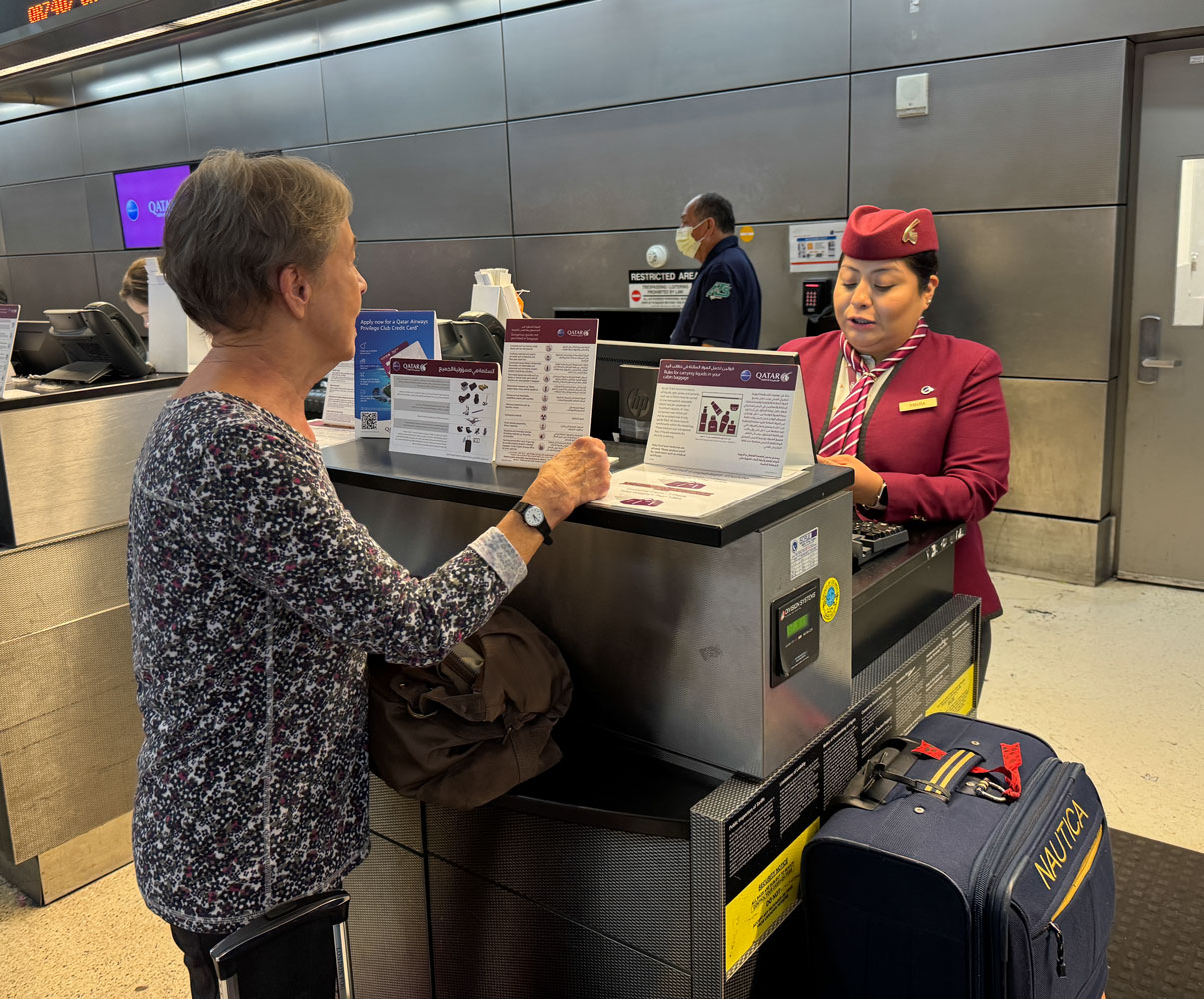
Then we went through security, and found the lounge. Our flight has been delayed until 5pm so we have some waiting.
About 4pm we went to the gate in the 200 section of the terminal. That's a newer satellite building off of the International Terminal. We walked through a subterranean walkway and then up to the 200 terminal. It's a bit of a walk.
Here's the aircraft, an Airbus A-350, which is a nice plane.
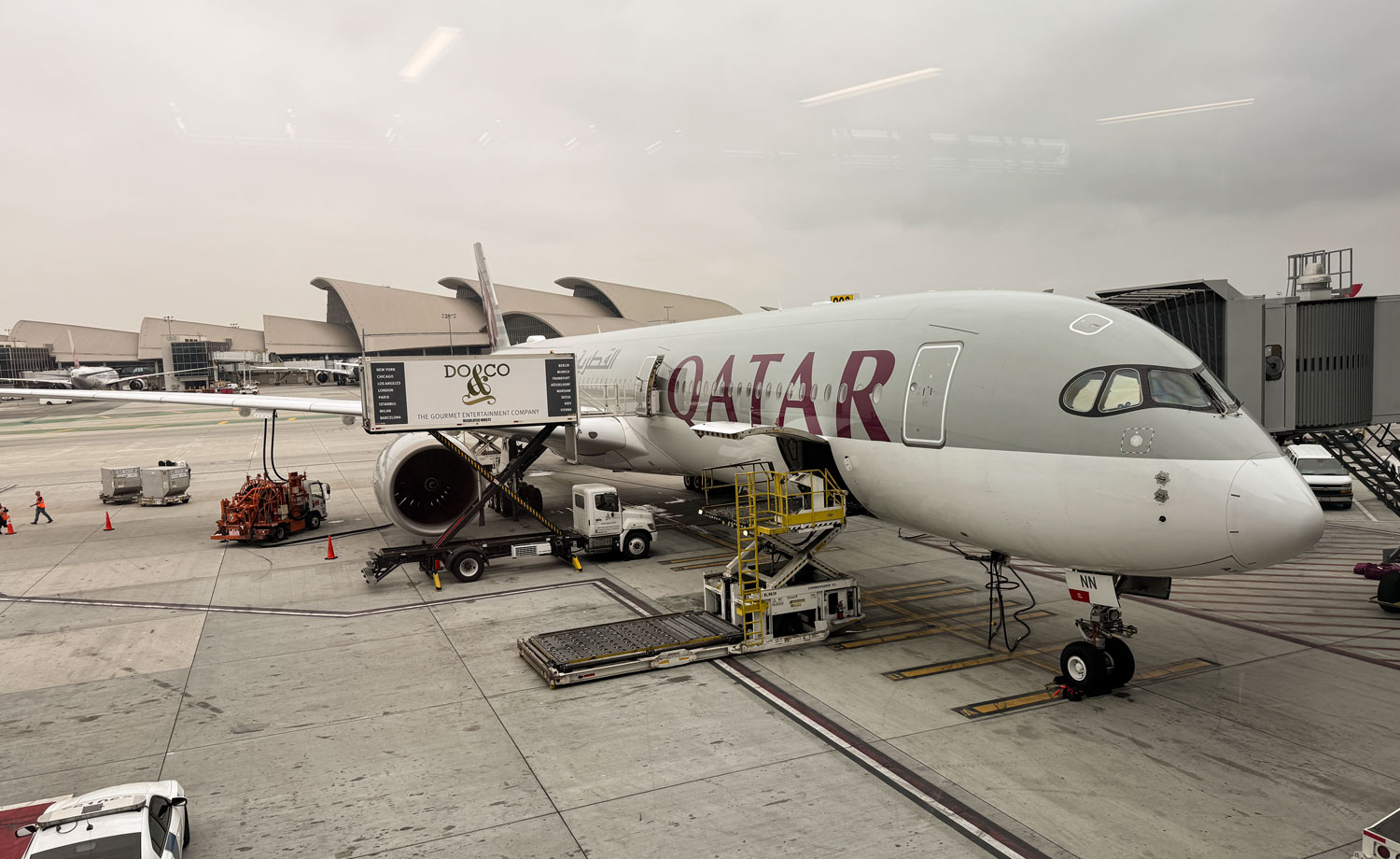
We chose Qatar for this trip because we had never traveled with them before and had heard very good things about the airline. Additionally, Qatar usually comes out at the top of airline ratings.
We found that Qatar does a very good job. The staff is excellent, friendly and attentive, and represents various nationalities.
The seating was a bit better than other Business Class seats we've experienced. In the lie-flat position there is more leg room (longer), and the foot area is a bit larger so you don't feel as constricted when sleeping, especially when you roll over.
The food was excellent and it was served well. This is an area where other airlines could copy Qatar. Qatar gets their meals from the LA area (for a flight originating there) so other airlines could get the same meals.
The movie selection was somewhat limited, and none of the movies had closed captions - which I use with my hearing loss. But even for people with normal hearing, closed captions help them "hear" the dialog in the noisy cabin environment. At home, all of the movie services - such as Netflix - offer closed captions.
However, I did get to watch "Dune, Part 2". I had seen Dune, Part 1 on a flight a year or so ago.
The flight was long, almost 16 hours to Doha, and we were able to get some sleep, but not a normal full night rest. A flight of that duration is tough enough in business class. It must be a real challenge in a middle seat in economy.
Here's a picture of the flight map as we were approaching Doha. The flight went over Europe, making sure not to overfly Ukraine, and then flew over the Egyptian Sinai, before turning left over Saudi Arabia to Doha. It seemed designed to avoid politically unstable areas.
Also, notice on the map that Israel is not shown. The area is labeled as "Palestinian Territories."

+++++++++++++++++++++++++++++++++++++++
10/17/2024 (Thursday) We arrived in Doha about 7:30pm, local time, a bit late because of our late departure from LAX. We have a long layover so a late arrival was not a problem for us.
The Doha airport is huge and modern. We were able to find the Qatar Business Class Lounge easily, and we settled in to wait for our flight to Delhi. The lounge is the largest lounge we've ever been in, but there were not many people in it when we arrived. It got much busier as the night wore on.
Here are a few pictures: That glassed-in area is a second floor where they have the food service.
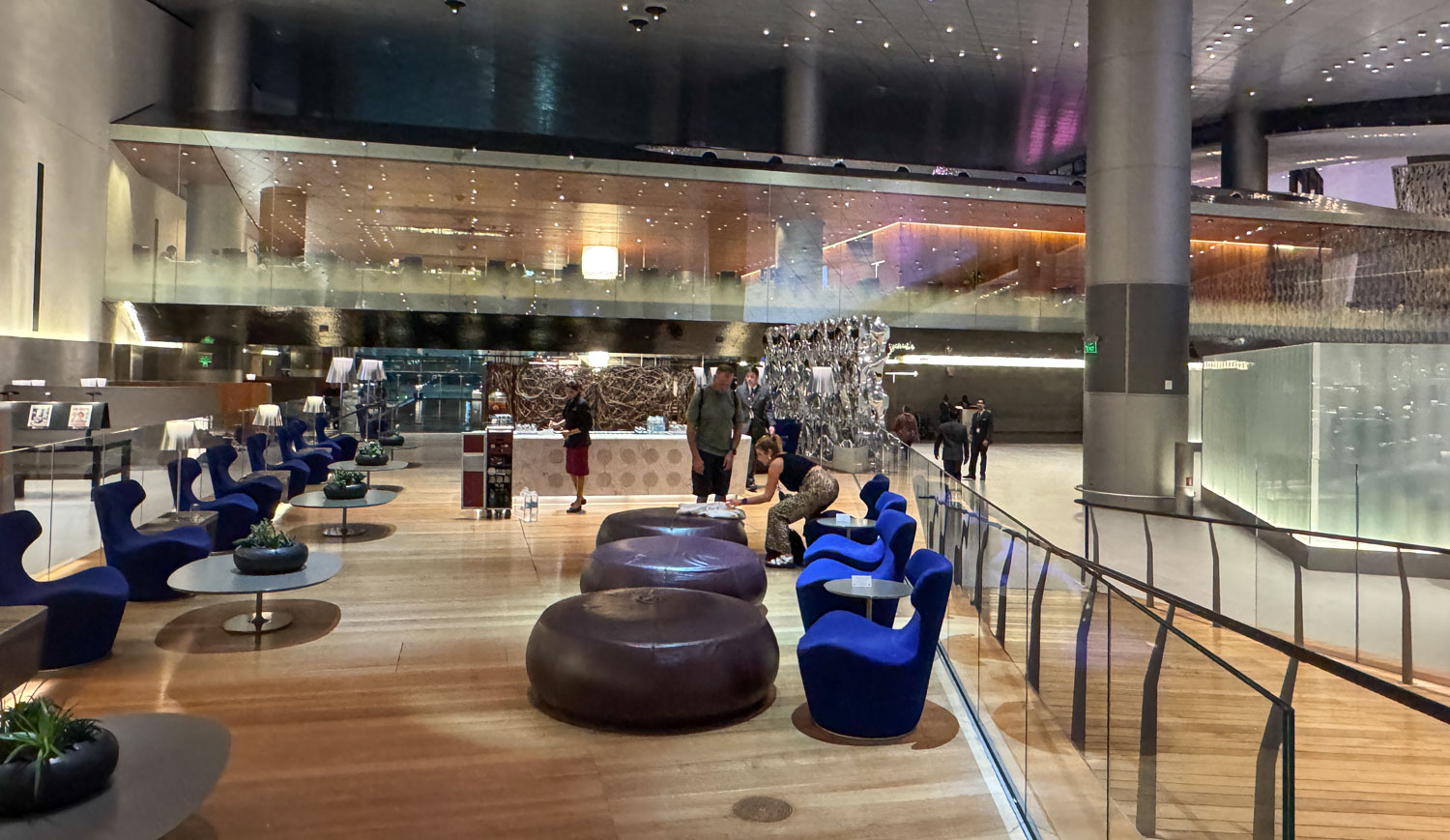
A view in the other direction shows perhaps half of the lounge. Not many people yet.
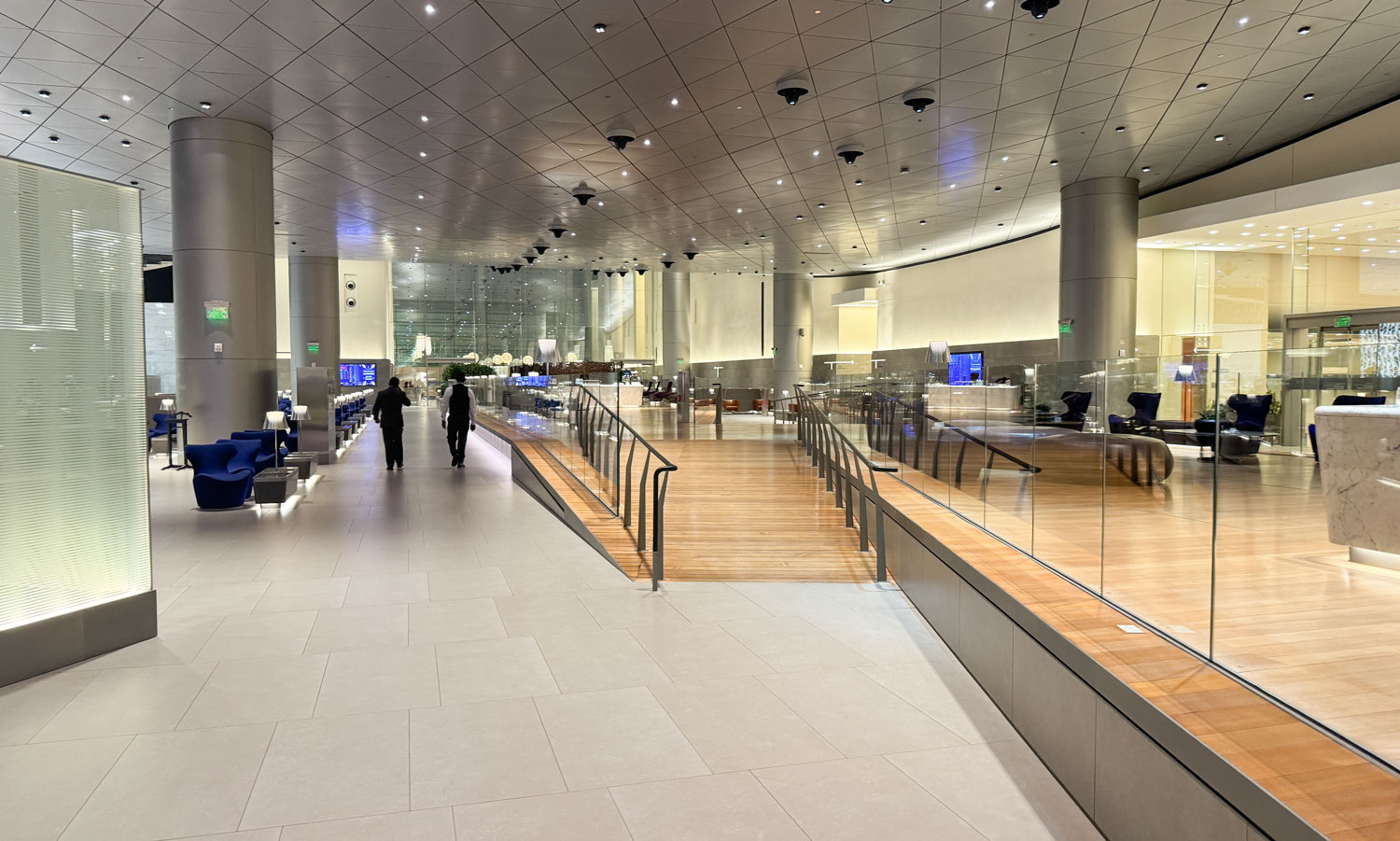
Looking back toward the restaurant area is the reflecting pool, which was at least 60-70 yards long. It's under the second floor restaurant. The stairs in the background of this picture lead to the restaurant. They also have an elevator.
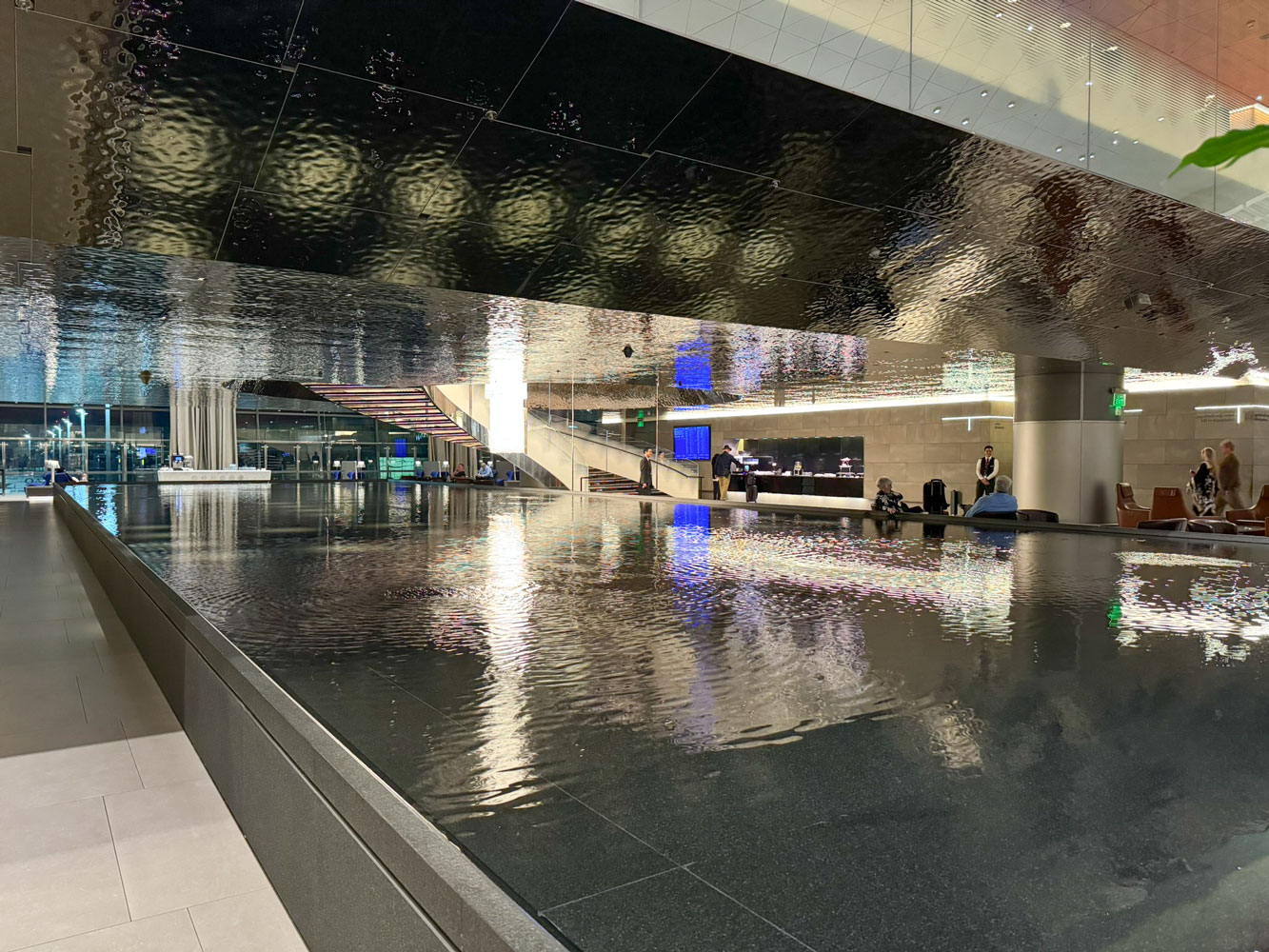
We went up to the second floor restaurant and I took a few pictures, but won't bore you with them. Suffice to say it's very nice with many food stations and a large bar.
We're in the Business Center right now where I'm working on this blog. While we were sitting in the Business Center, one of the Qatar staff came by and asked us about our connecting flight. Since we had several hours to go, she invited us to an area where we could lie down. She provided a blanket for each of us and told us to leave our boarding passes on the table and she would wake us when it was time to go to the gate.
Here's Judy in one of those cubicles. They were wonderful blankets, the same as we had on the plane.
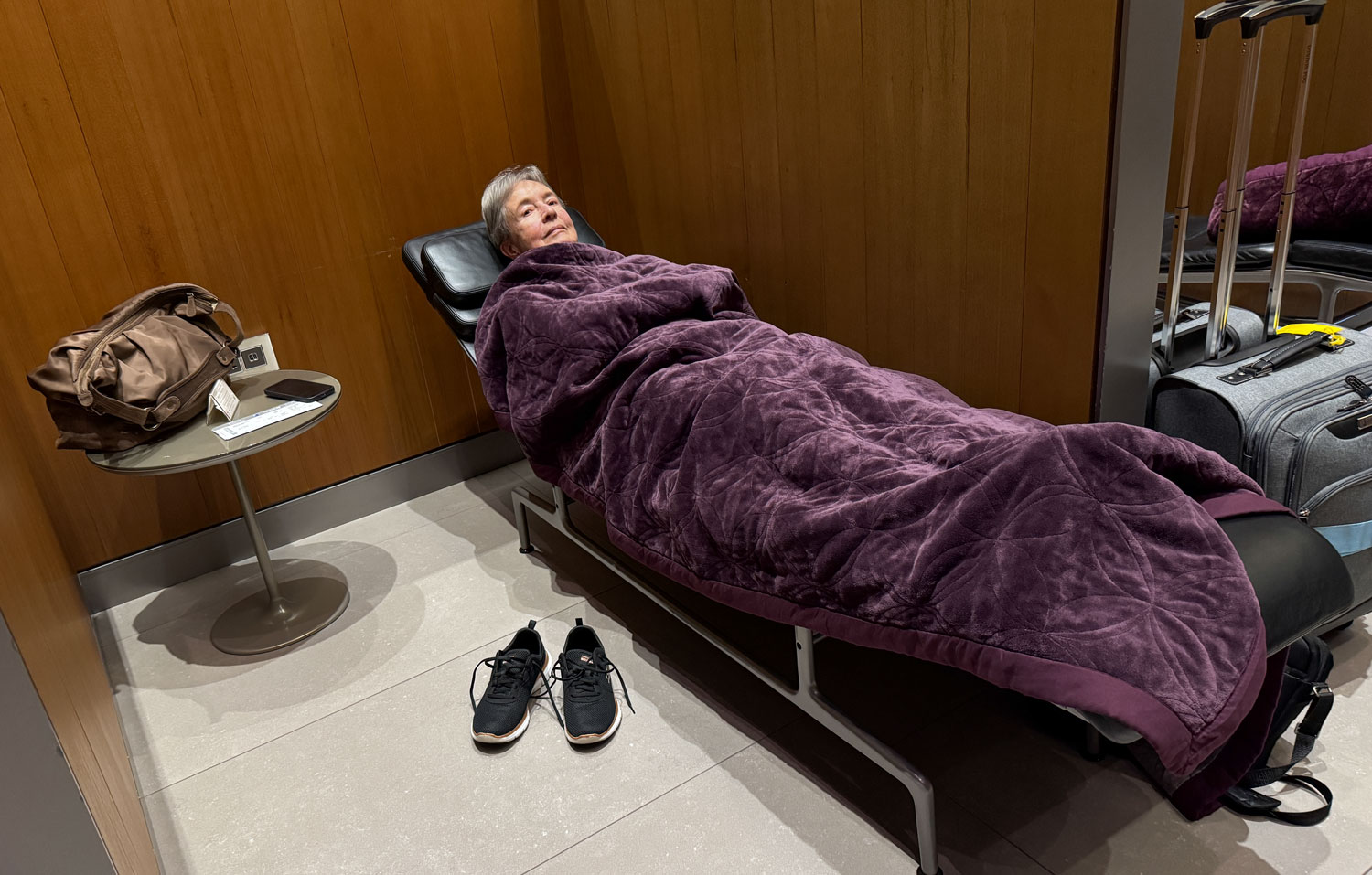
We didn't really sleep but it was nice to have a place to lie down.
Our flight to Delhi is scheduled to depart at 2:20am.
+++++++++++++++++++++++++++++++++++++++
10/18/2024 (Friday) The lounge got much more crowded by midnight. They had a line of people who wanted to go to the restaurant area but the staff was only allowing people in when someone else left and a seat became available.
It's obvious that a lot of flights leave Doha around midnight to arrive at their destinations early in the morning.
We left the lounge about 1am and walked to gate C83, which was quite a walk and confusing as to the direction.
When we got to the gate, we discovered that the gate was to a bus that would take us to the airplane.
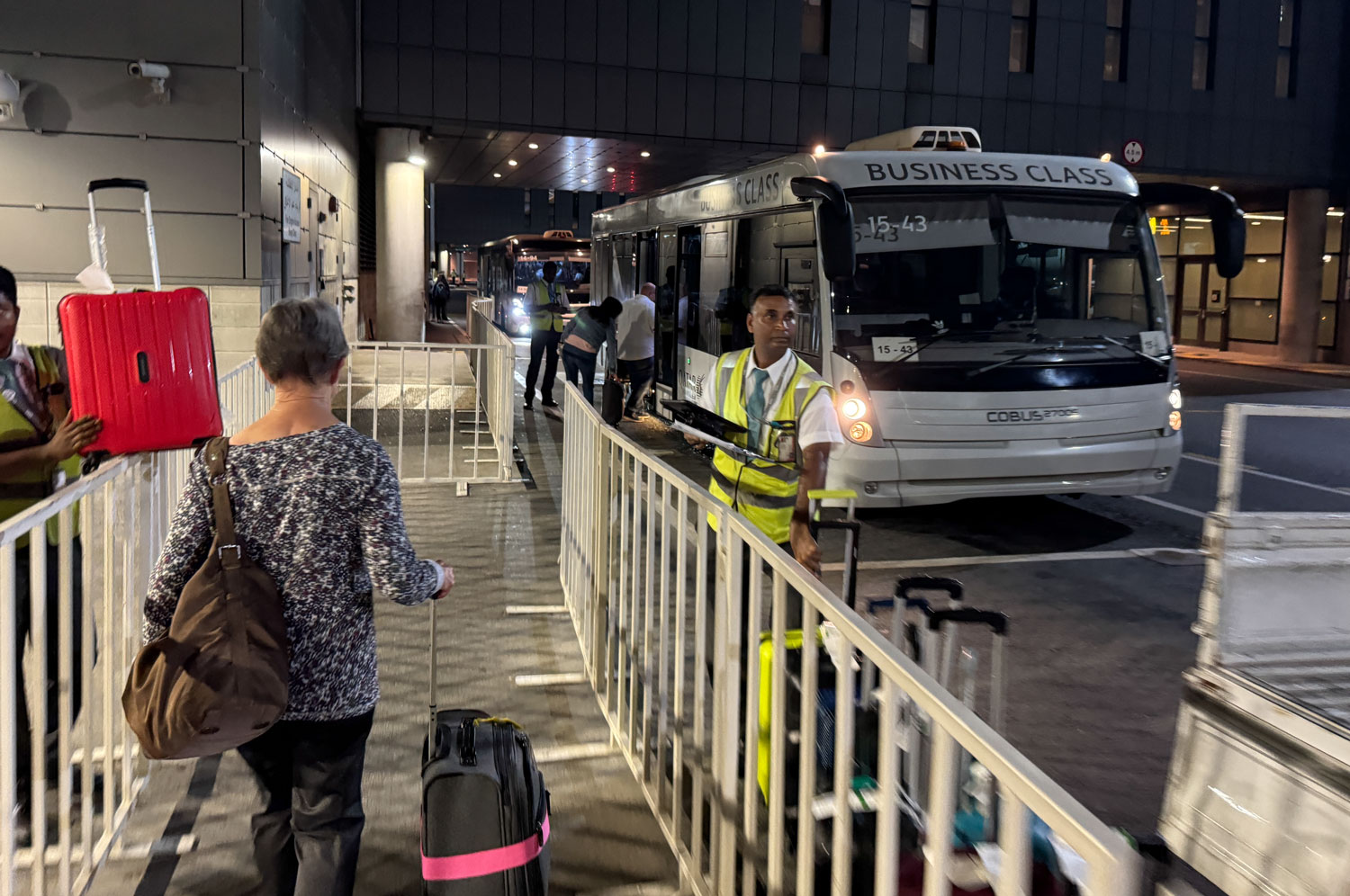
Once the bus got going, it drove a very long route - shades of Heathrow Airport. Then we got stuck somewhere on the airport, just waiting for maybe 15 to 20 minutes.
We finally got to the aircraft, a Boeing 787, but we had to walk up stairs carrying our "carry-on" luggage. I had heard so many positive things about Doha Airport, but this was really poor.
Once we got on the plane things improved. We took off about 2:35am and the cabin crew served us drinks and dinner. We arrived in Delhi at 8:10am. Note that India is on a half hour time zone compared the rest of the world. India spans two time zones so what India did was split the difference so that all of the country would be on the same time.
As we were walking towards passport control, we were directed to a kiosk that collected our biometric information, plus a scan of our passport. The biometric data collected were our fingerprints and a photo. I forgot to take a picture of the biometric kiosk but here's one from the web.
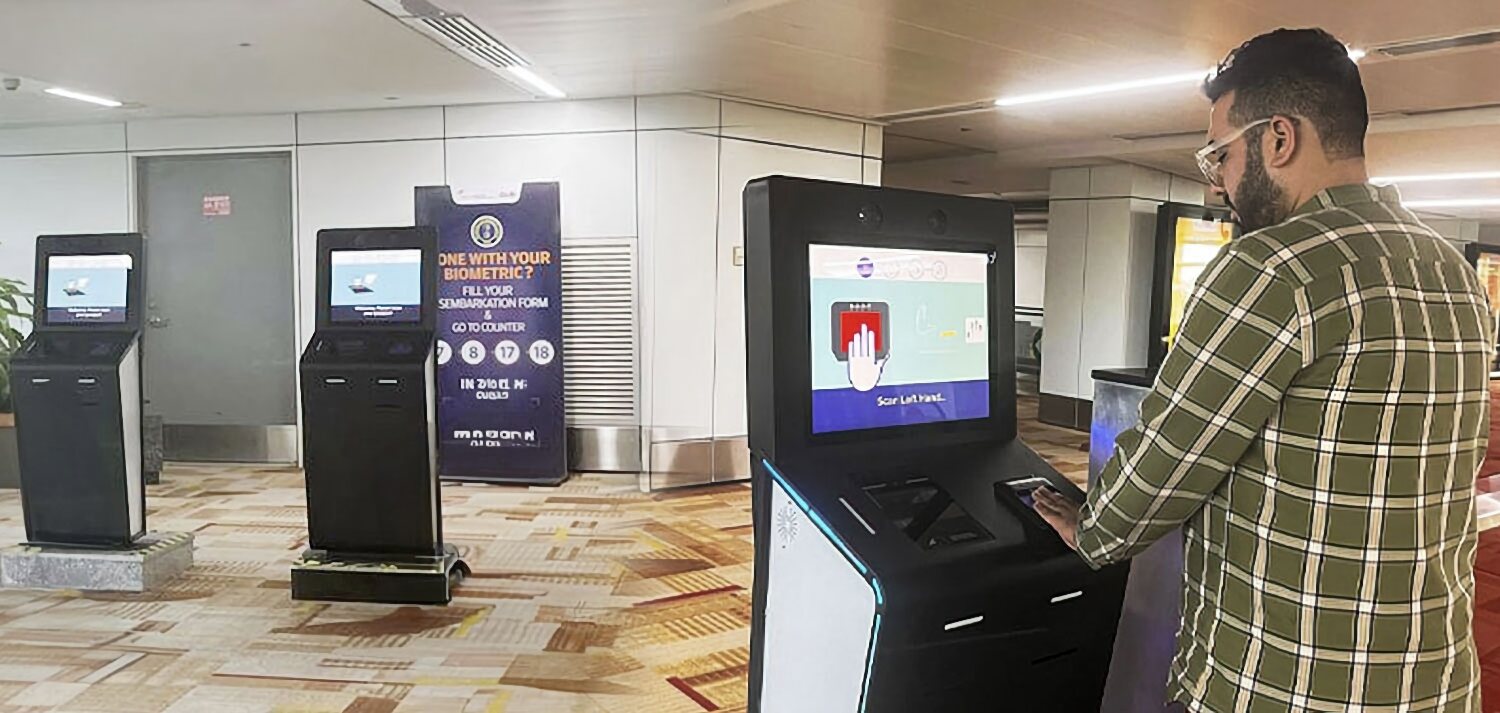
When we got to passport control there was a line for First and Business Class passengers which moved much faster than the regular lines, especially since we had done the biometric data at the kiosk.
Then it was to baggage claim. Our airTags told us that our bags had arrived,. It had taken some time to finish at the biometric kiosk and then get through Passport Control, so our luggage was already on the carousel. As we exited the baggage claim area the Tauck "greeter" was waiting for us. Note that there was another Tauck greeter there, so I suppose we were not the only early arrivers for the tour.
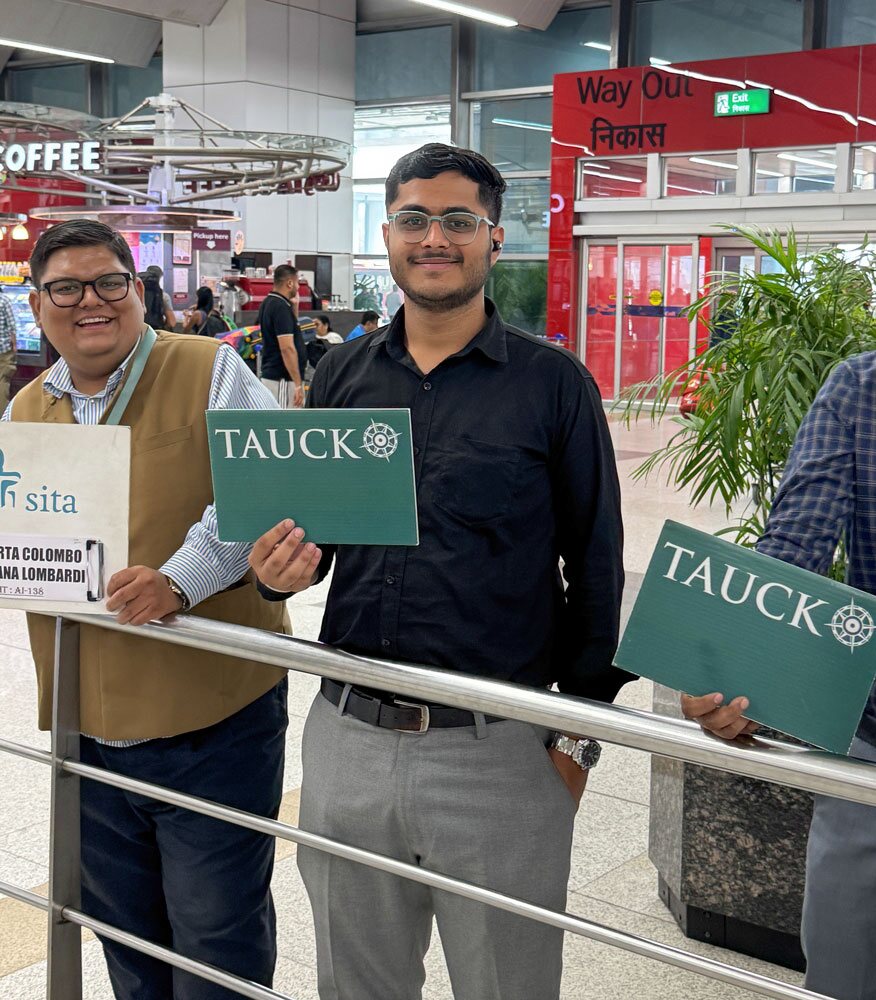
He had a car waiting for us, and gave us each a lei.
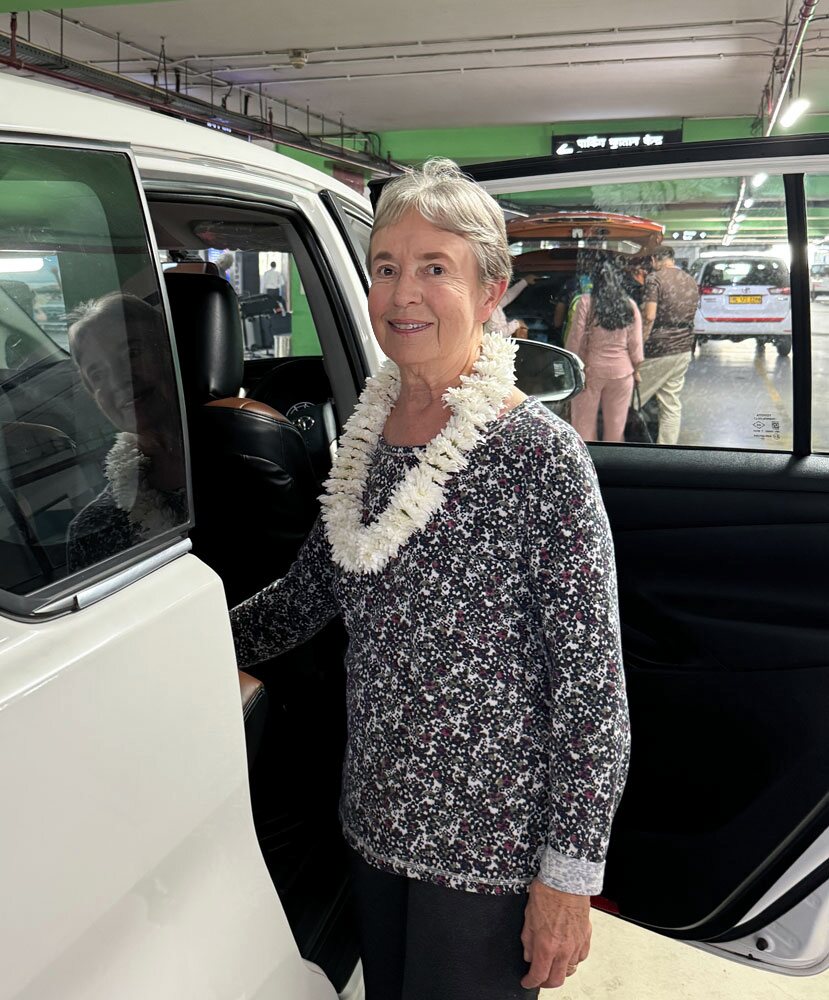
Then we headed out into the crazy Delhi traffic. It took about 30 minutes to get to the Leela Palace Hotel, but rooms were not ready. Here we are, two exhausted travelers, in the lobby of the Leela Palace. We had about three hours in LAX waiting for our flight, then 16 hours to Doha, a six hour layover in Doha, then a three hour flight to Delhi, about 28 hours of travel time. That's tough on old people like us. Judy looks great but I look like a truck hit me.
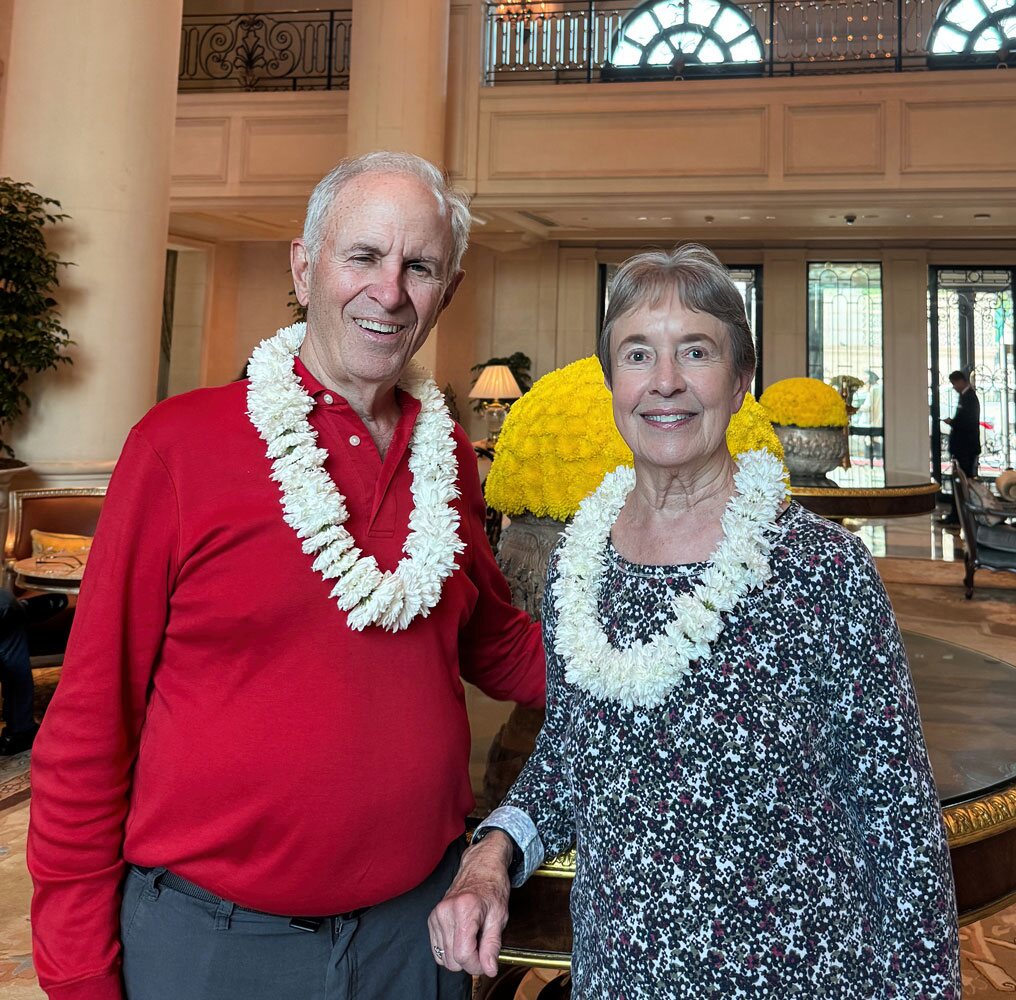
It was now about 10am, so we went to the restaurant for breakfast. About 11 we went back to the desk, and they had our room ready.
It's a nice room, of reasonable size and appointed well. It won my heart because it has a large walk-in shower, instead of a tub shower - and good Internet access.
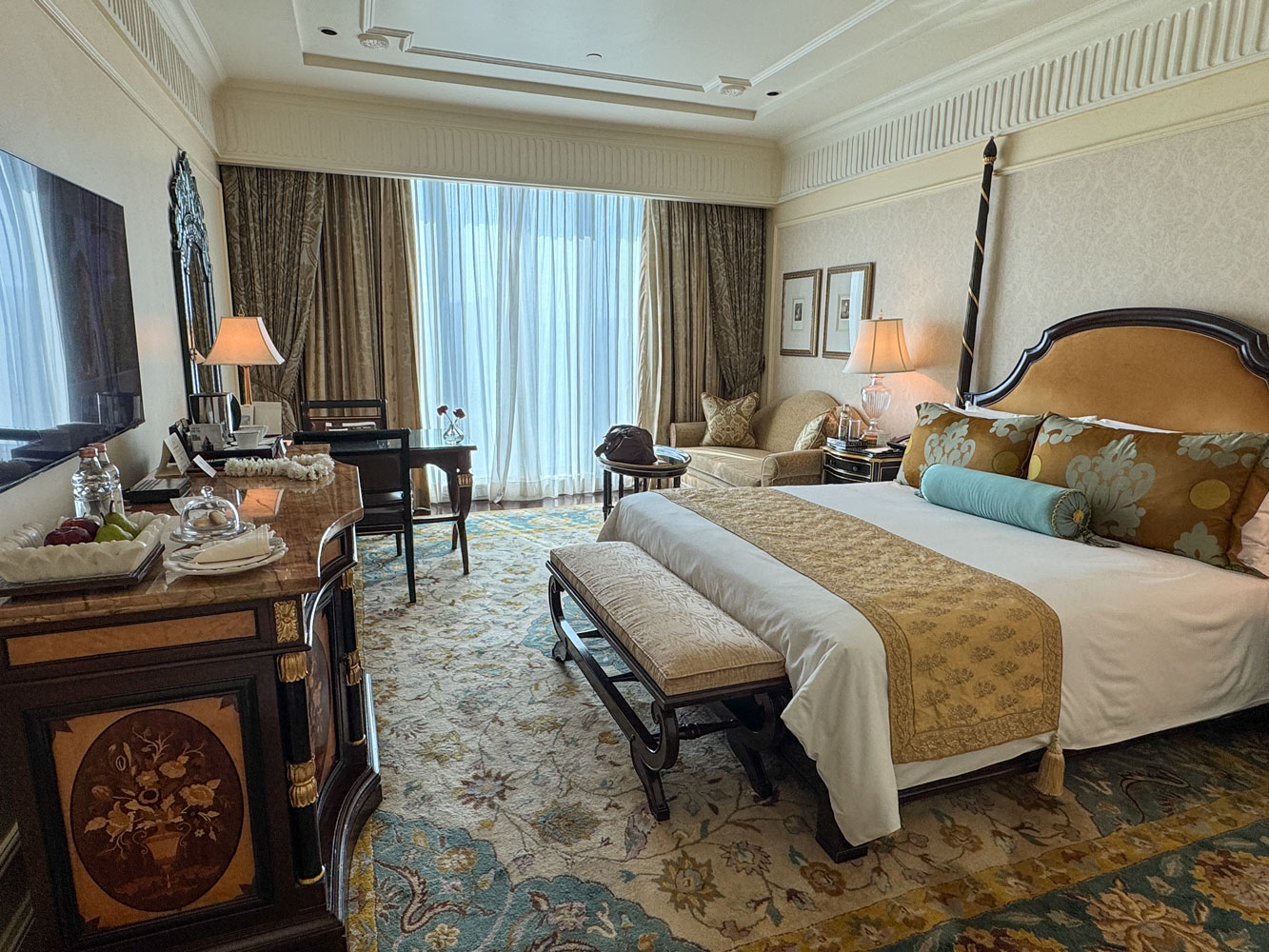
We were both very tired, so as soon as they brought the luggage we took a nap and didn't wake up until 5pm. Of course, we won't be able to sleep tonight:-)
The tour starts on October 20th. We received the Tauck "Gift of Time" which provided us with an extra night's stay prior to the tour, and would have allowed us to arrive on October 19th. However, the flight arrangements we preferred meant we had to come even one day earlier, so we arrived on October 18th.
As tired as we are, I can't imagine someone arriving on the morning of October 20th and being ready to attend the "meet and greet/orientation" meeting at 2pm that same day.
+++++++++++++++++++++++++++++++++++++++
10/19/2024 (Saturday, Delhi) As expected, we woke up about 3am, but we're feeling rested. Our early arrival gives us a free day today, so I arranged with the concierge for a tour of old Delhi (I did this months ago). The hotel provides a car, and arranges for a tour guide. We meet the tour guide at 9am in the lobby.
In the wee hours of the morning I went down to the concierge to change money. He had an employee lead me to the hotel ATM, way down in the basement, and I withdrew ₹9,000 (that's the rupee symbol). There was a $10 charge on this amount at the ATM - but the exchange rate was fair. That's about $100, and I thought that would be enough for the day. Turned out, it was just enough.
The restaurant opened at 6:30am and we went down for breakfast shortly after that.
At 9am we met our tour guide, Jitendra. I didn't take a picture of him at that time, but here's one from later in the day.
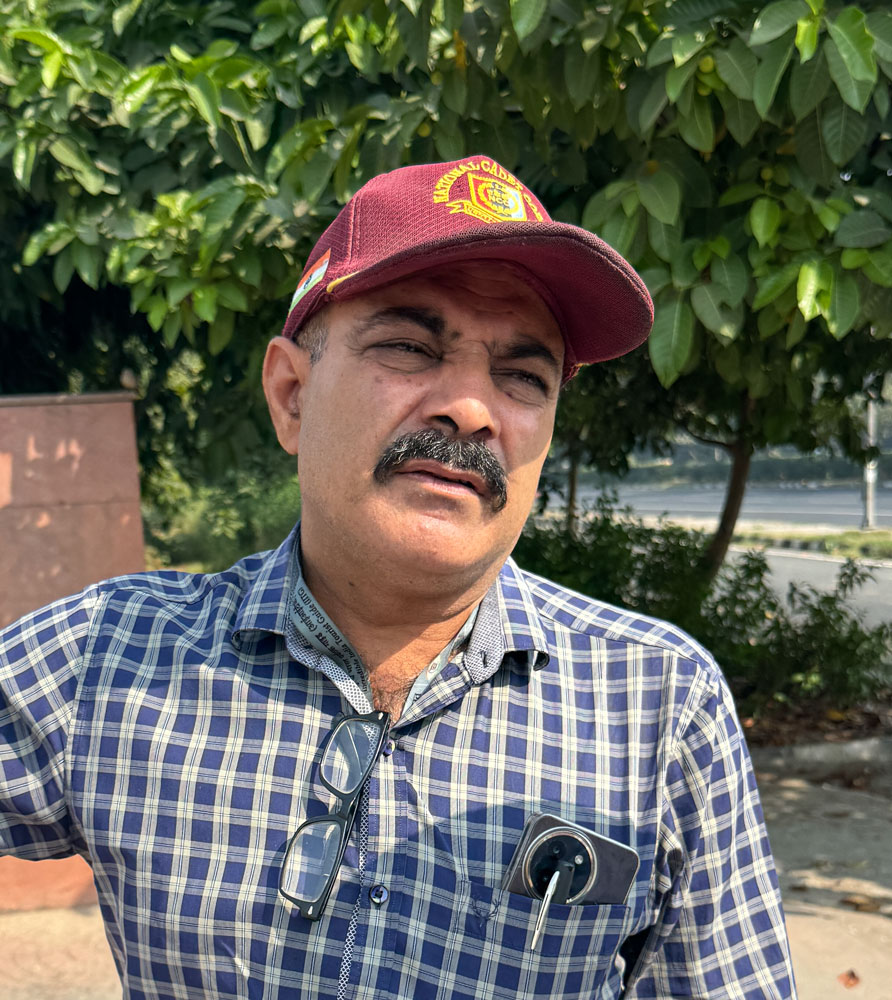
Unfortunately, he had a fairly strong accent and spoke very fast, and with my hearing problems, I could understand almost nothing of what he said. Luckily Judy was better able to understand him and would relay important things to me. It was challenging to follow it all.
I had sent information to the concierge about what the Tauck tour included, and asked them to forward it to the tour guide, but they hadn't. So it took some time in the lobby for us to work with Jitendra to come up with an itinerary for the day - that didn't duplicate what we would be doing with Tauck. He was flexible and willing to change his normal routing plans.
Then we went to meet our driver for the day, Pardeep. The Leela Palace offered a couple of choices for a car and I chose the BMW 7 series for up to 8 hours. It turned out to be a very nice car.
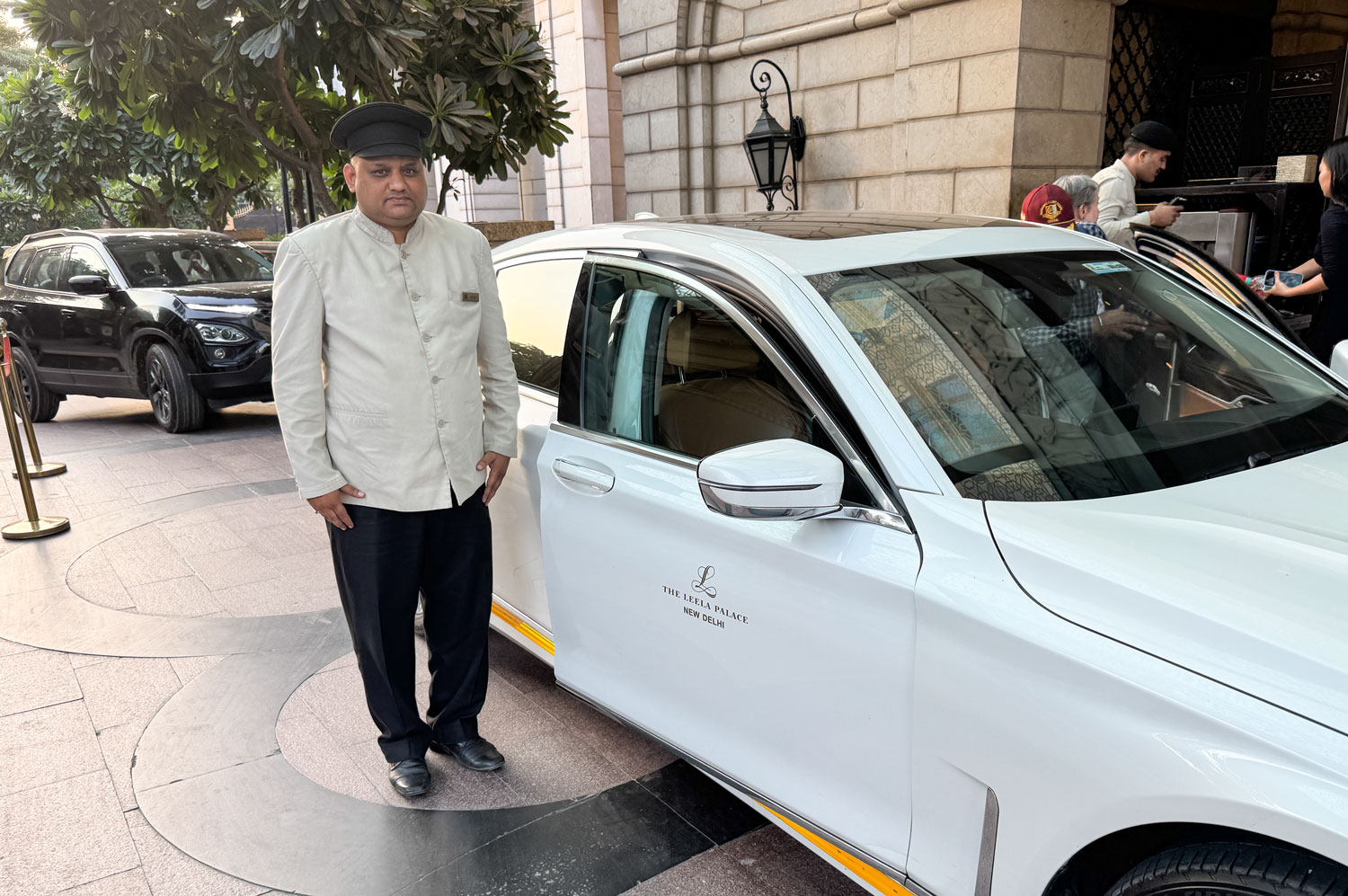
He was a very good driver in the Delhi traffic. The rules of the road are different in Delhi than in the US. Traffic is generally slow, but drivers of all types of vehicles will attempt to slip into any available space between vehicles. Constant horn blowing seems to help a lot. It's hard to describe but interesting to observe. Pardeep was really a master of dealing with that traffic. I'm sure if he had a crunch with another vehicle, he'd probably lose his job. He was careful but aggressive.
A lot of his job was waiting. He would take us somewhere and then find a place where he could park until we were ready to go again.
When we left the hotel, we drove along the Ring Road to the area of the Red Fort, and stopped at the Dilli Chalo Park. The park is really in development mode and isn't much to look at now.
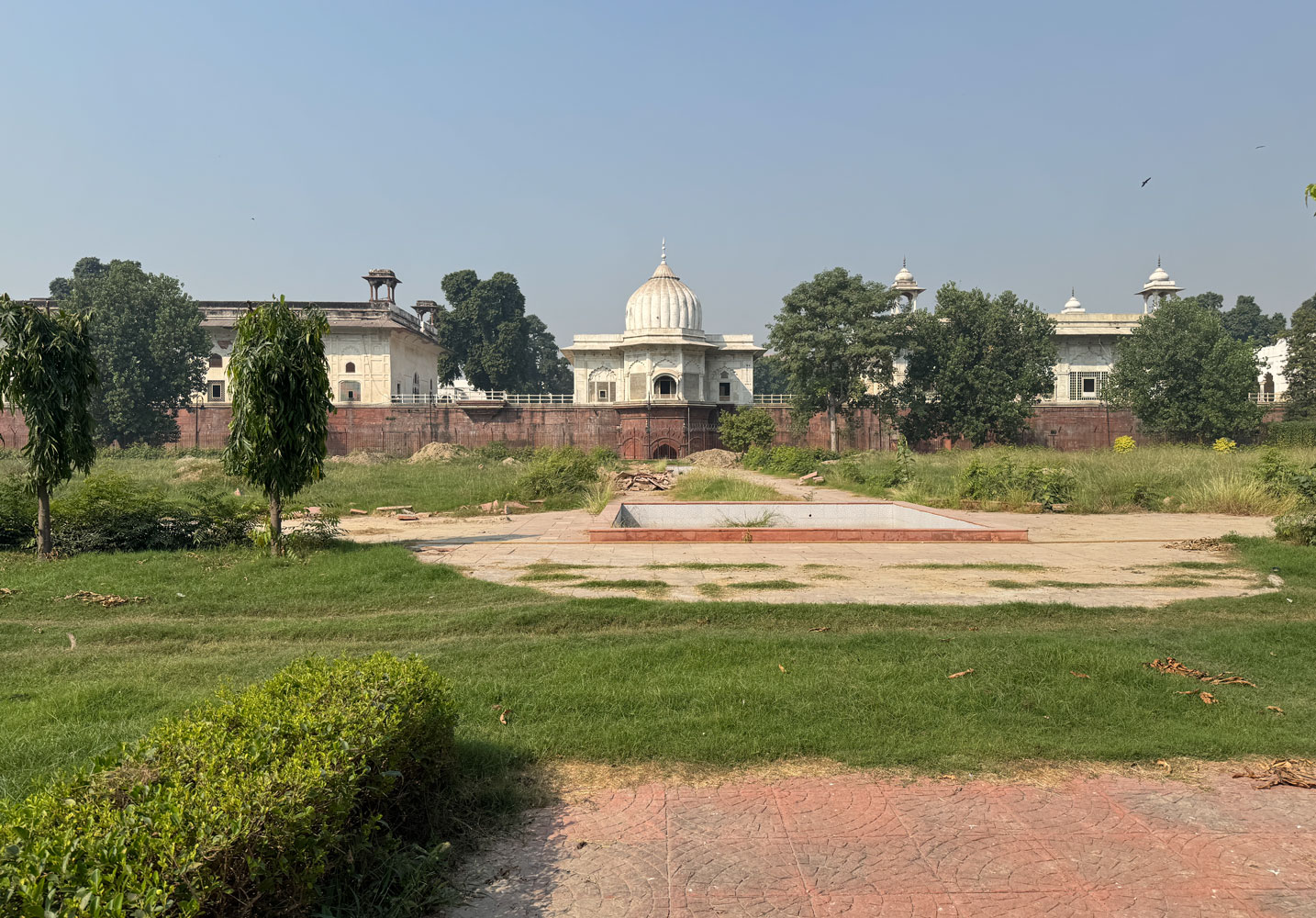
I was really wondering why we stopped here and was concerned that the rest of the day would be like this. But it did improve.
While we were on the Ring Road, I took this picture of a tuk-tuk, also called an Auto-Rickshaw. There were hundreds of these on the road, most in better condition than this one.
[Update: I checked and the official estimate is that there are about 92,000 of these in the Delhi area. An investor will own one or more and lease them individually to a driver for a monthly fee. It's unclear who is responsible for maintenance issues. The source I found said that a driver makes between ₹7,000 ($83) and ₹9,000 ($107) a month, I assume that's after paying the lease fee and fuel costs.]
They bobbed and weaved their way through traffic, squeezing into any opening they could find.

Here's one in better condition, along with two of a slightly different design. Almost all the Tuk-tuks we saw were similar to the green one here. Most have a 4-cycle 250cc engine.
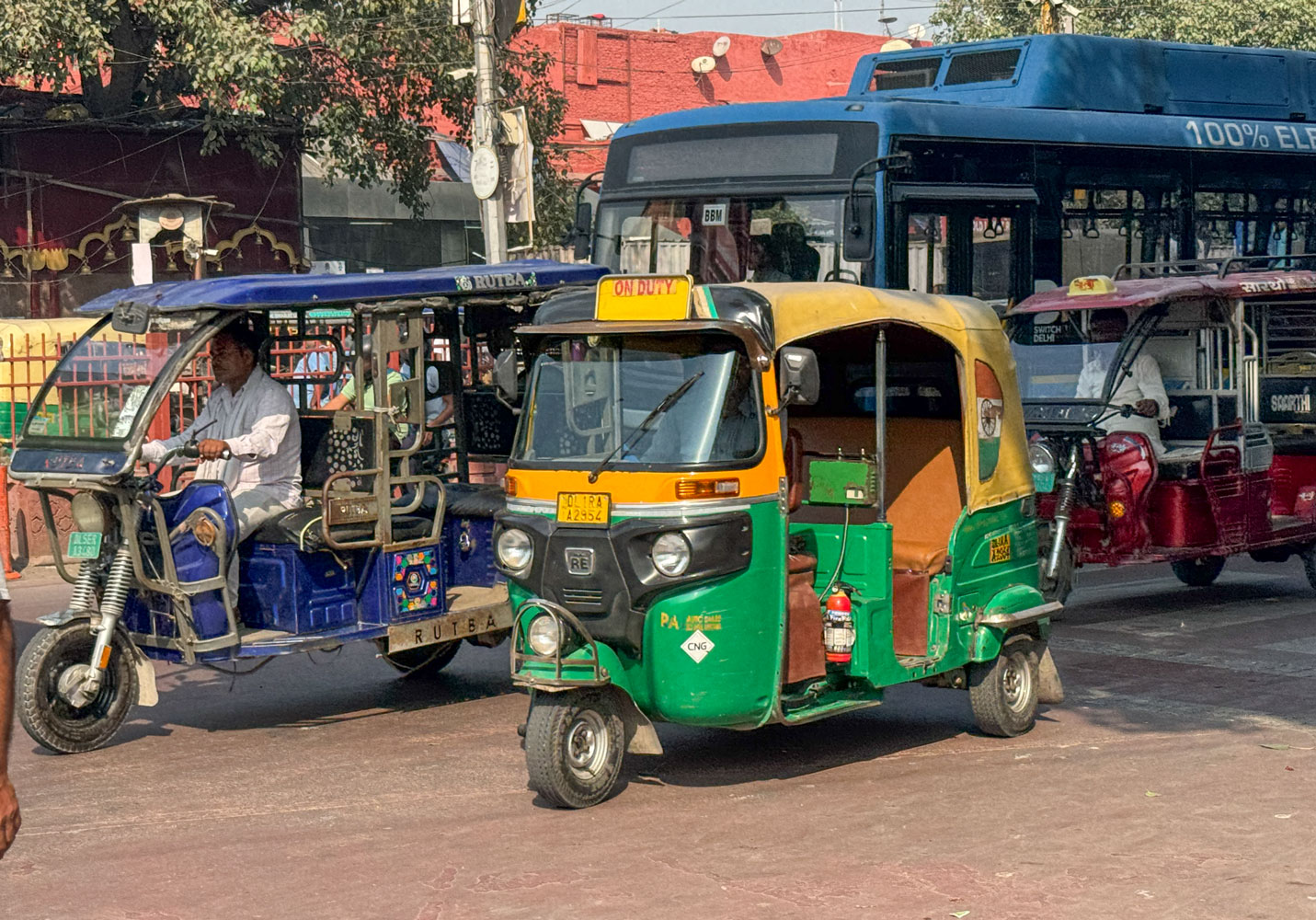
We entered Old Delhi and went to the other side of the Red Fort, the Lahore Gate, but didn't go in.
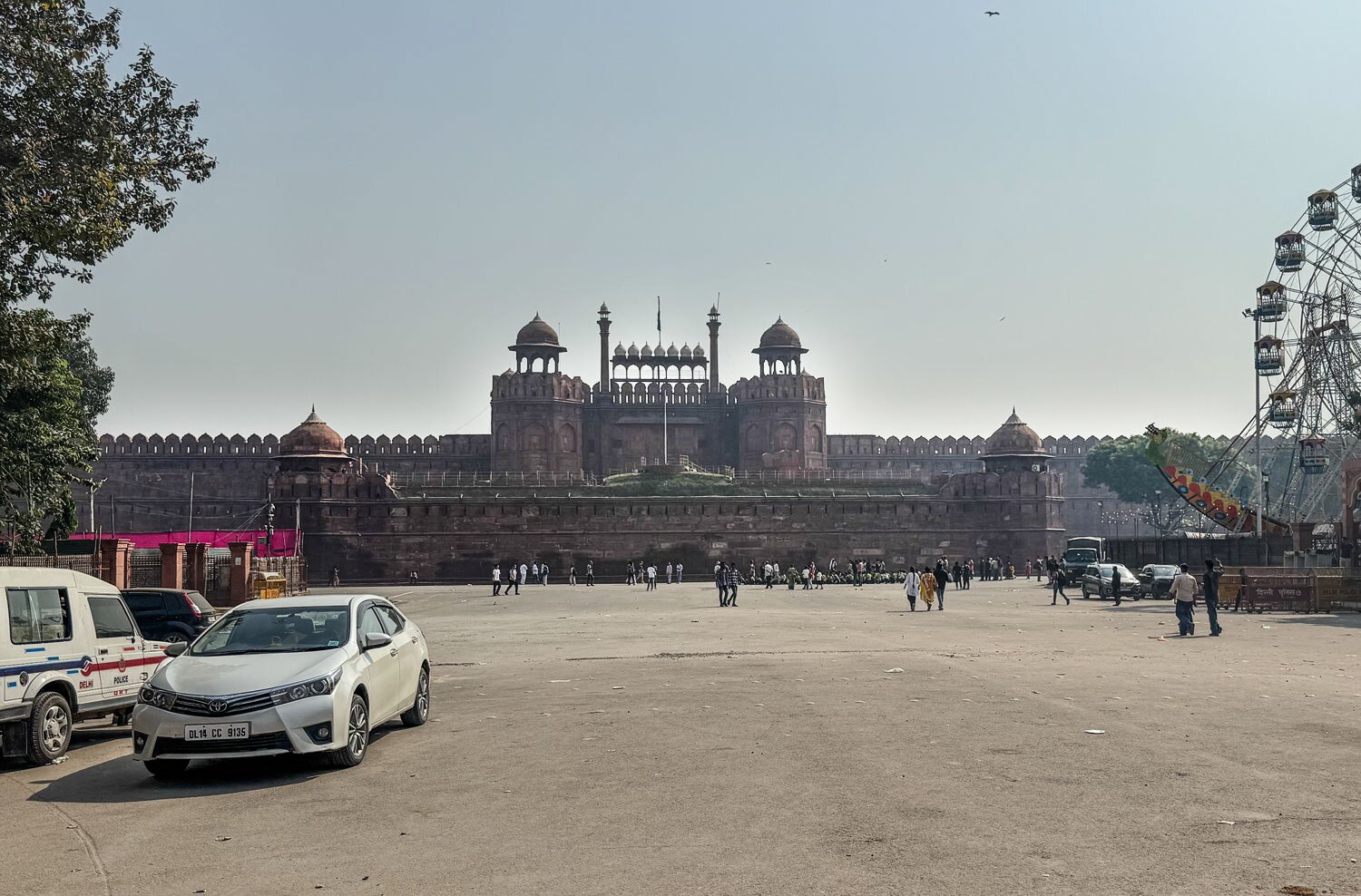
We crossed the road, walking through an underground walkway. There was a fence between the two lanes of the road to prevent people from crossing through traffic. Crossing a road through traffic appears to be a high art in Delhi.
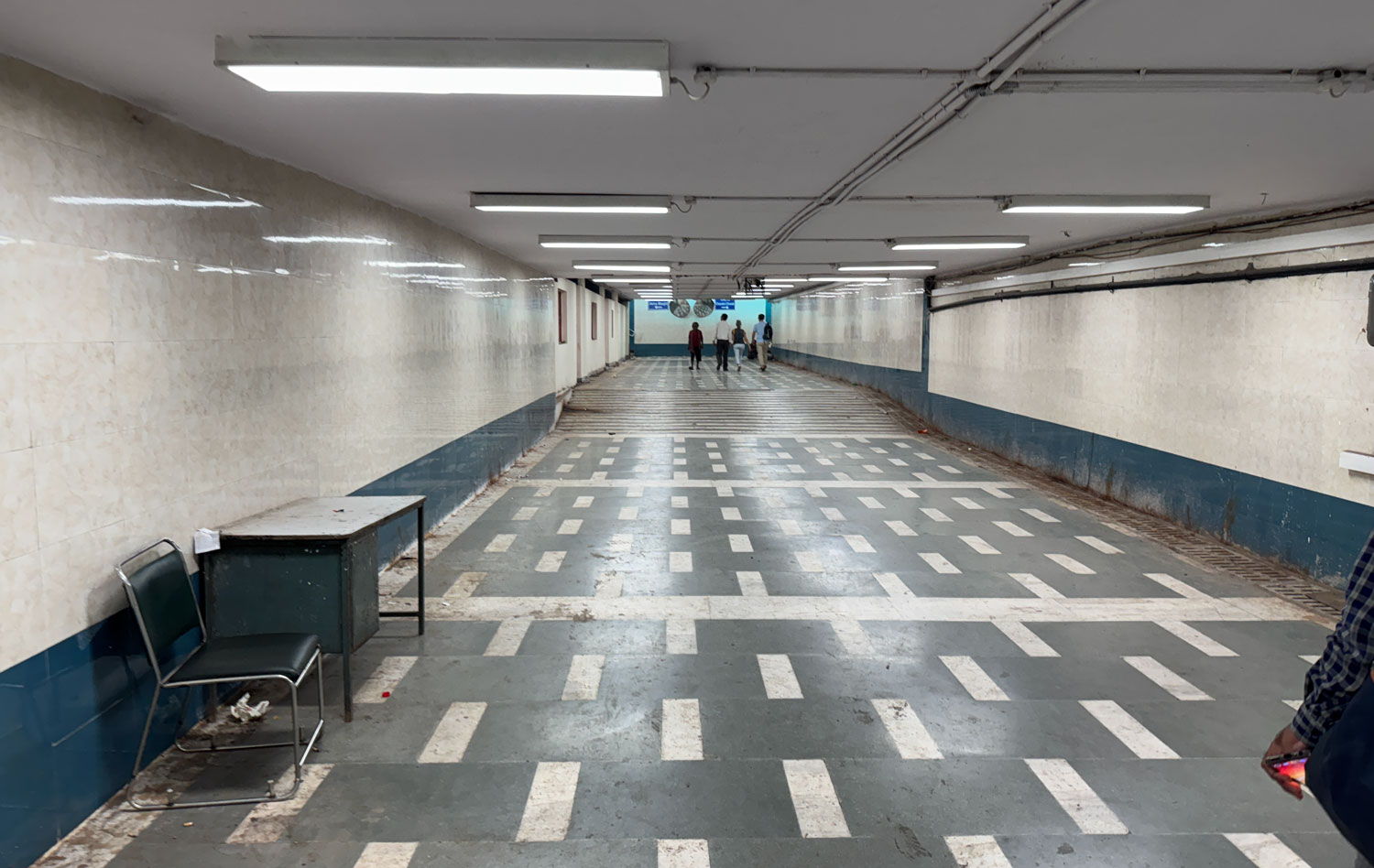
On the other side of the road was a Jain temple, the Sri Digambar Lal Mandir. Jitendra said that the Jains were highly represented among the wealthy. Research supports Jitendra's comment. Over 70% of Jains are in the top quintile of wealth. They own a significant portion of the country's property, contribute 25% of India's GDP and own 20% of the textile industry.

Alongside the Jain temple was the Chandni Chowk Road with an endless line of pedal rickshaws and their "drivers" (who are also the engines:-).
Jitendra engaged two rickshaws, at slightly more than $3. I thought we should have paid more - the guys stayed with us for several hours and took us to three or four places. The poor guy peddling our rickshaw weighed no more than 100 pounds and he had two fair-sized Americans in his rickshaw. At the end, I gave Jitendra two $5 bills to pass to the drivers. Jitendra said they could not convert USD but he would give them the equivalent in rupees. I didn't see him do that and am not convinced he did.
[Update: Apparently, the driver leases the rickshaw from an investor for a monthly fee. The official estimate is that there are perhaps 700,000 of these pedal rickshaws in Delhi. The operator is estimated to make about ₹1,200 ($14) to ₹4,500 ($53) a month. That's real poverty.]
This is typical of the endless line of rickshaws.
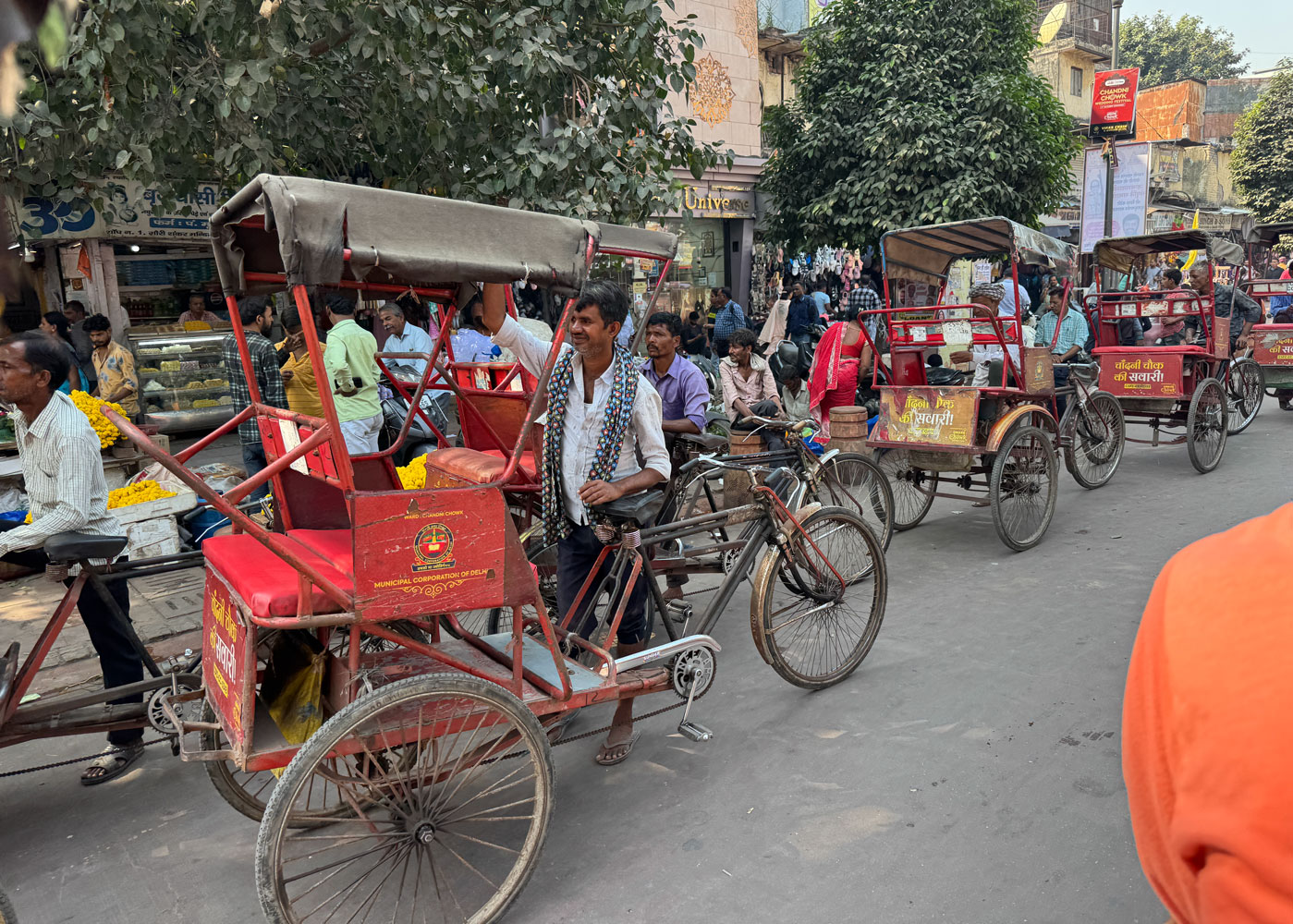
I didn't take a picture of our driver - I don't know why - but here's a picture of him as we were sitting in the rickshaw and he was peddling. You can see he's not a big guy.
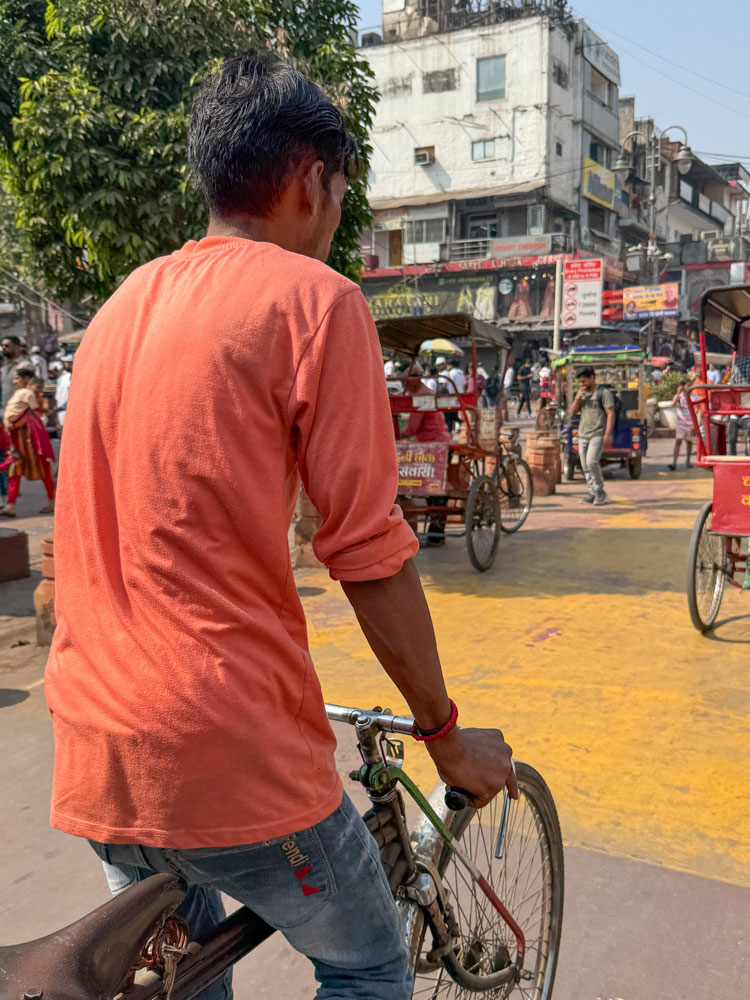
The first place we went was to a Sikh temple, the Gurudwara Sis Ganj Sahib Temple.
[Update: I saw Sikhs with turbans of all different colors. I asked two different Sikhs whether the color of the turban meant anything. Both said the same thing - they just chose a color to go with the rest of their outfit, or how they feel that day. The color has no meaning in the Sikh religion.]
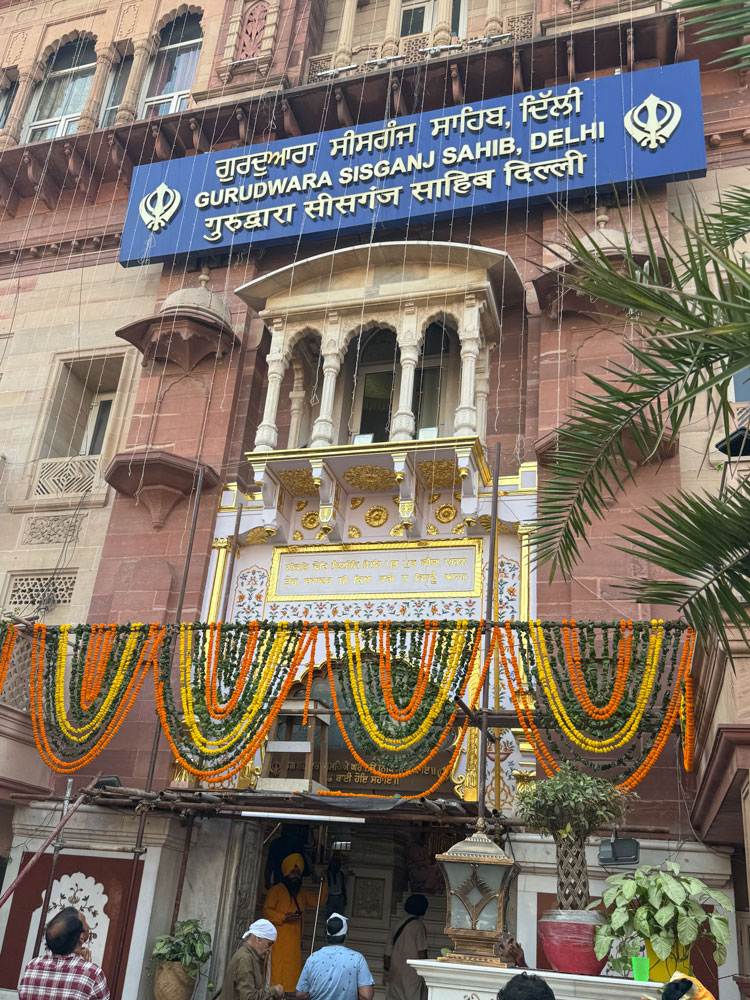
To enter the temple you must remove your shoes. There's a room for that, and for checking your shoes with an attendant.
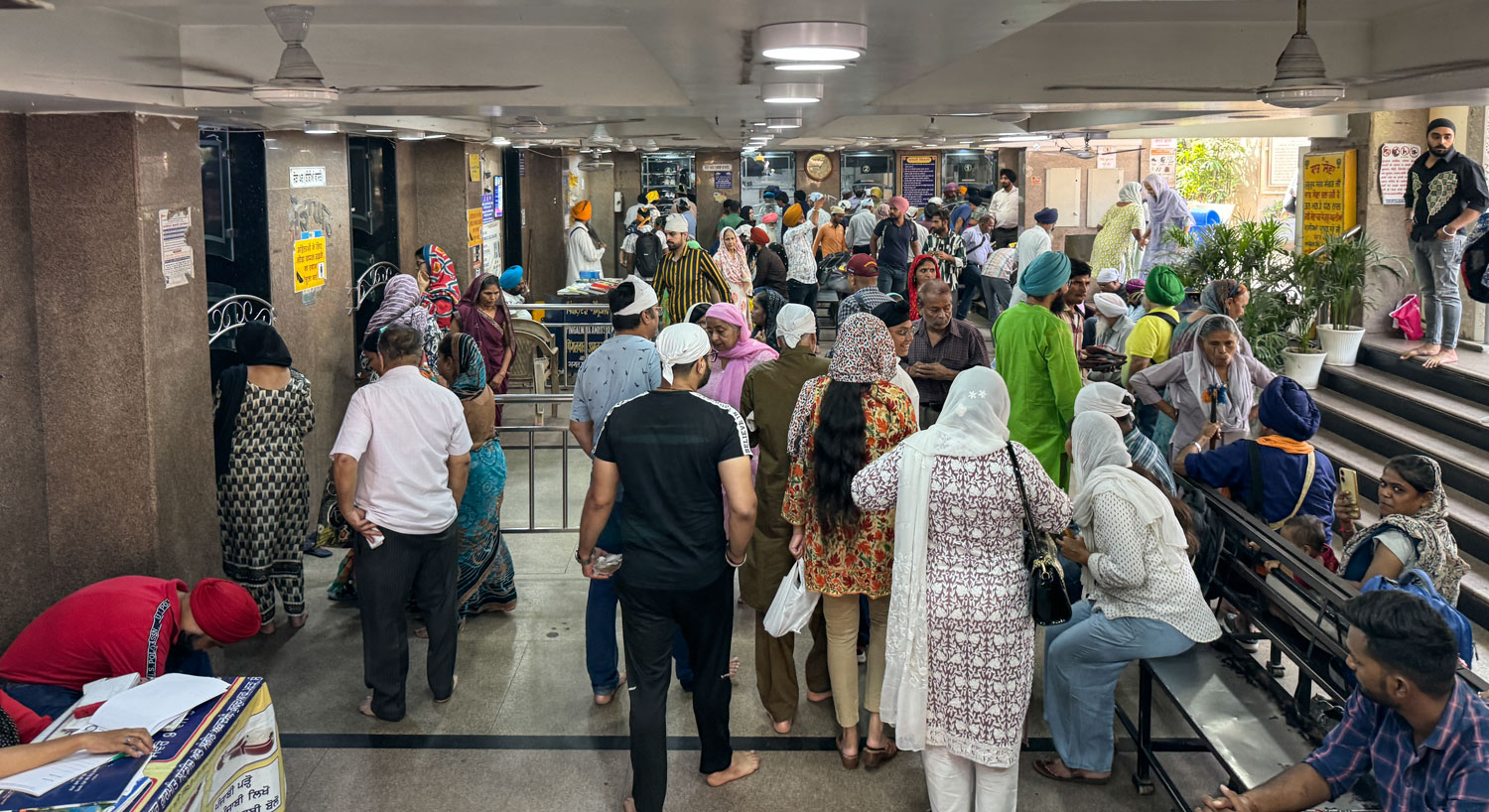
We also had to cover our heads - both men and women. Here's Jitendra helping Judy with her head covering.
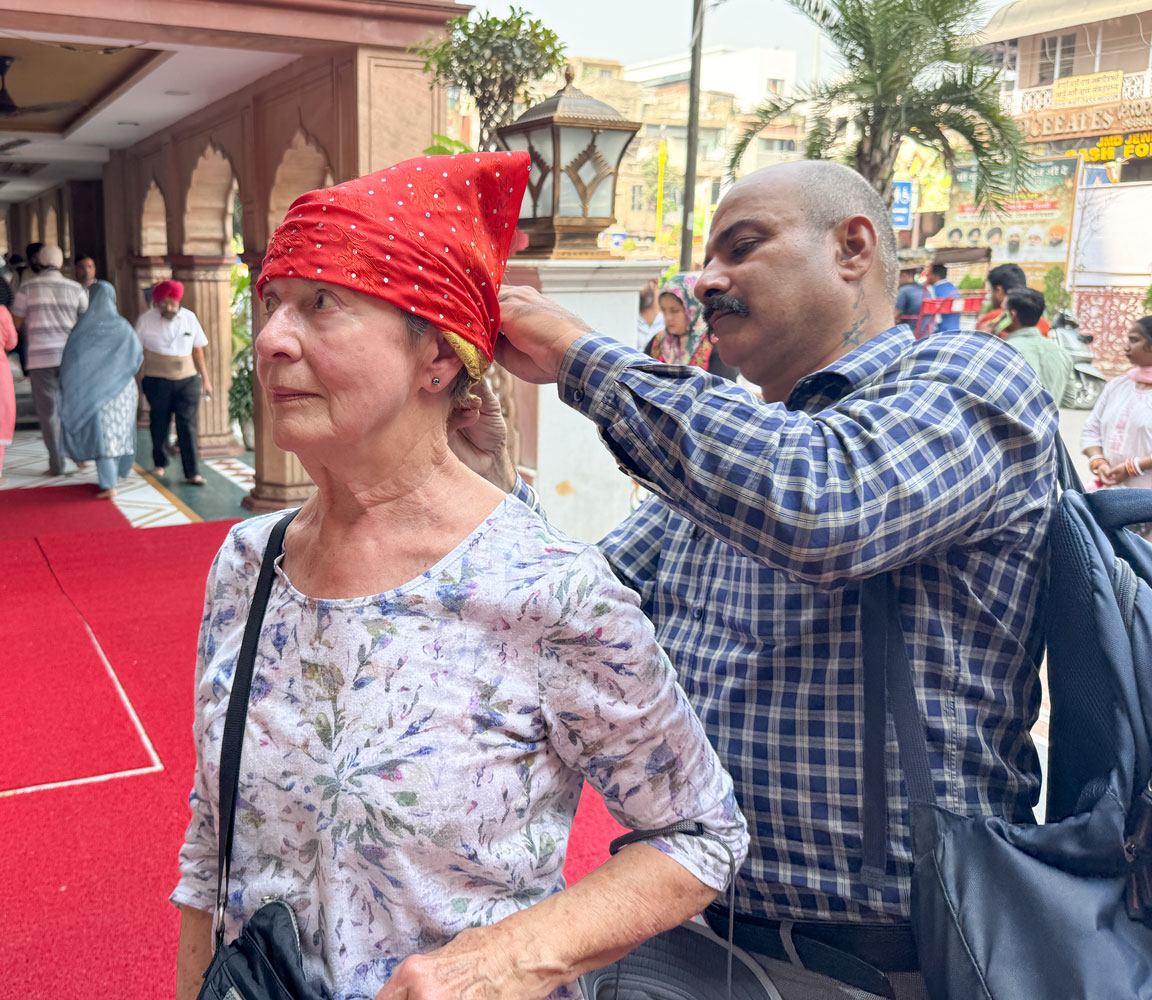
A view from the back of the temple toward the altar area.
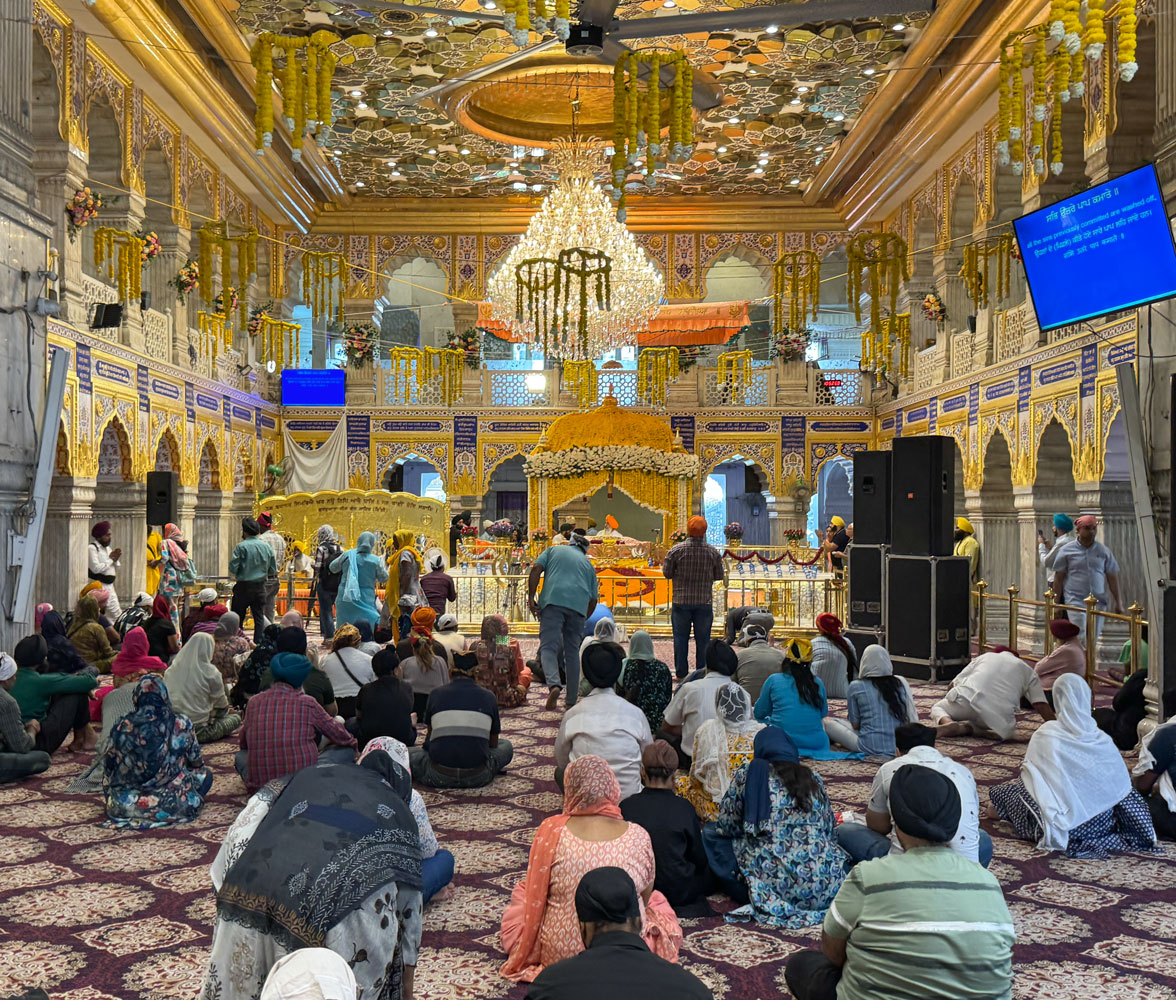
There were three older Sikhs seated in the altar area, playing musical instruments and singing religious chants. The video screen you see in the image above had the chants in English as well as their native language.
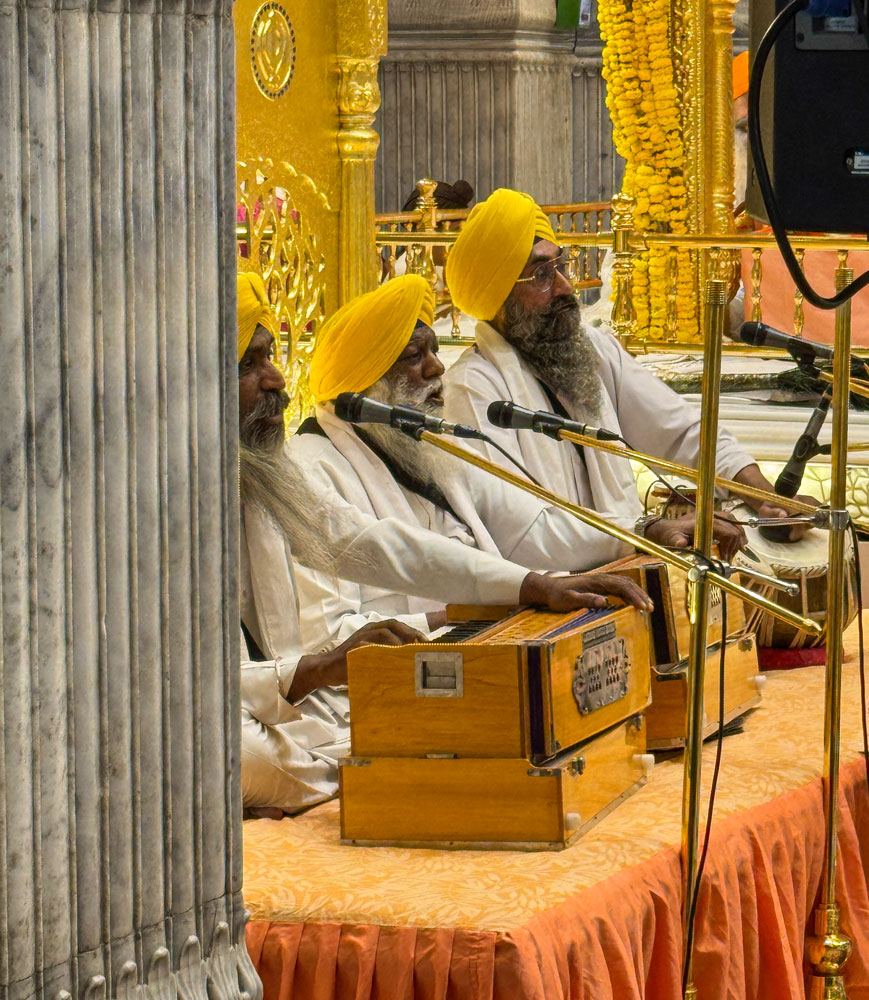
An older Sikh man with a high turban outside the temple.
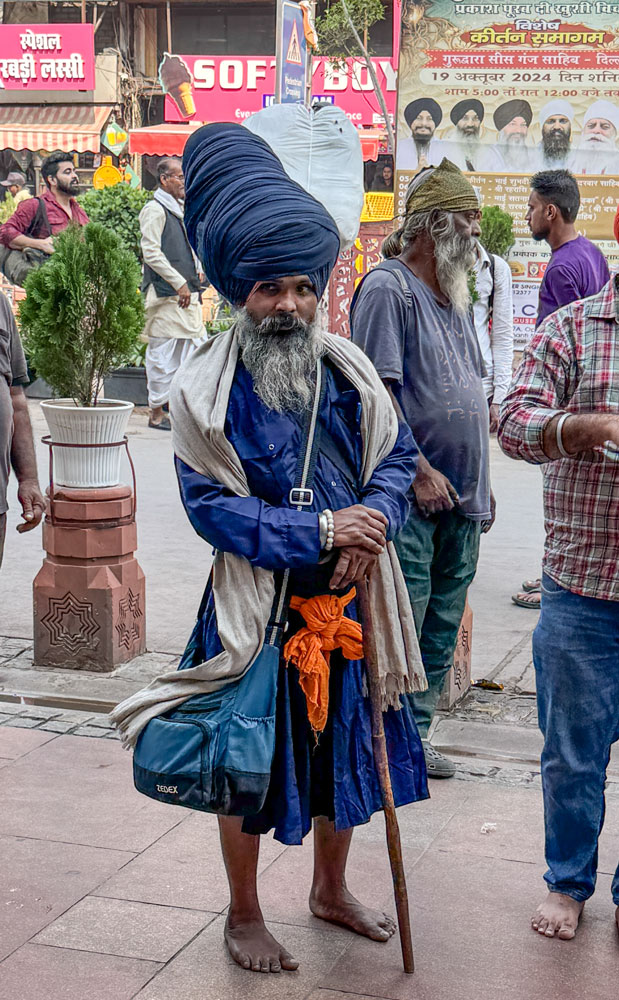
We went back to the shoe room, retrieved our shoes and put them on. Then we met the rickshaw drivers and continued down Chandni Chowk Road to the spice market.
As we were going along the road, another rickshaw passed us and I took a picture of the driver. I thought he had a very interesting face.
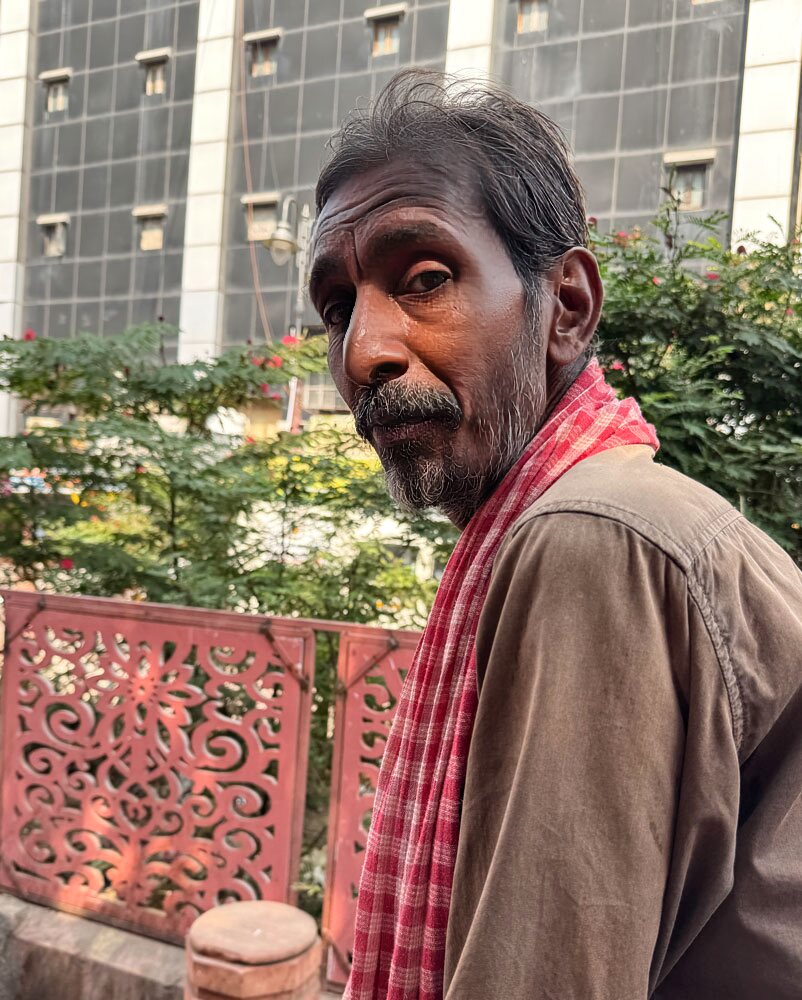
There were many people who had interesting faces, but I couldn't go sticking my camera into them.
We eventually reached the end of Chandni Chowk Road where it connects to Galli Kandle Kasan Road. There were many, many rickshaws there.
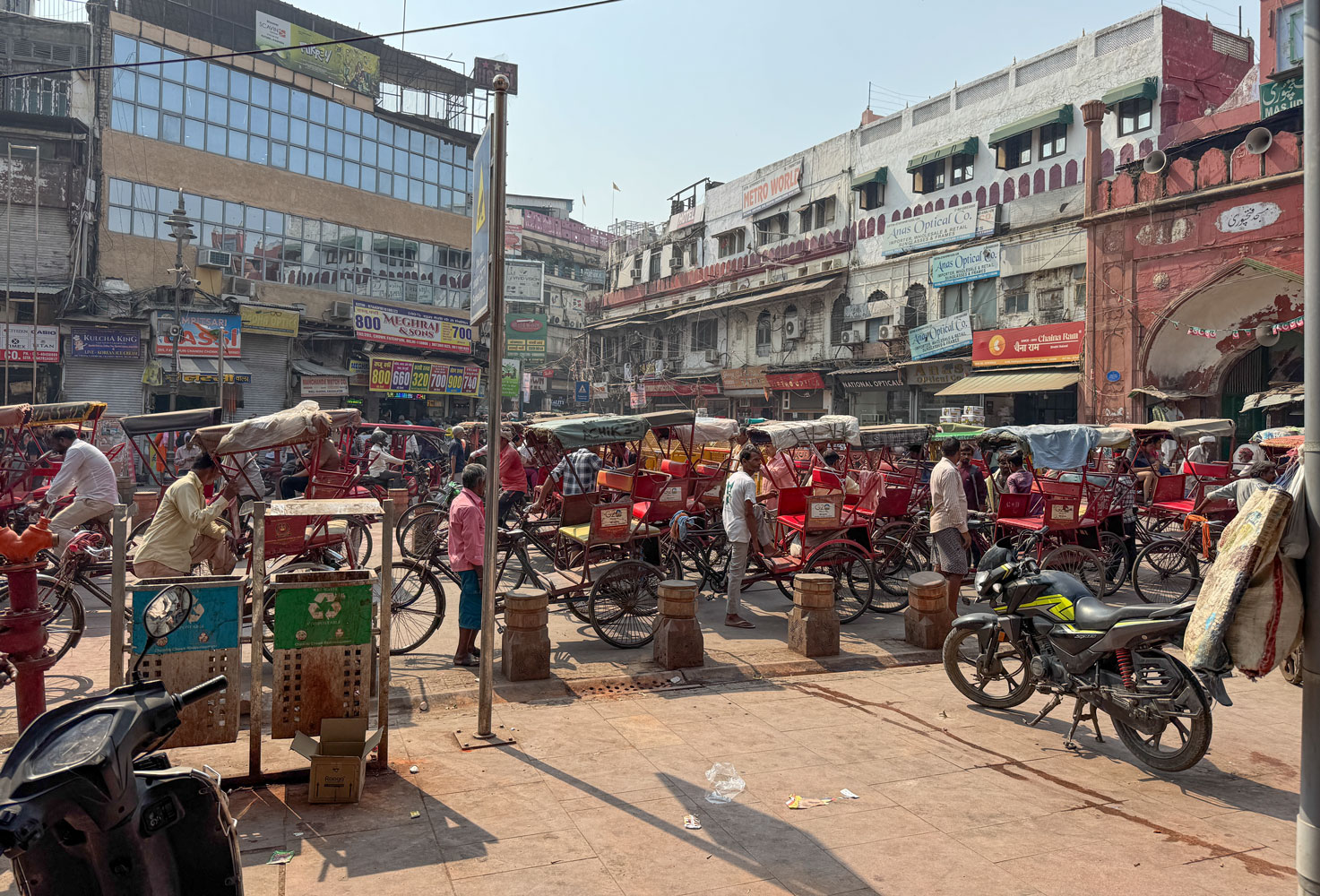
Jitendra bought us a lime-soda, made with fresh squeezed lime and bottled carbonated water (soda). You might think this is dangerous (Delhi-belly) but we watched him open a bottle and pour the soda into the cups.
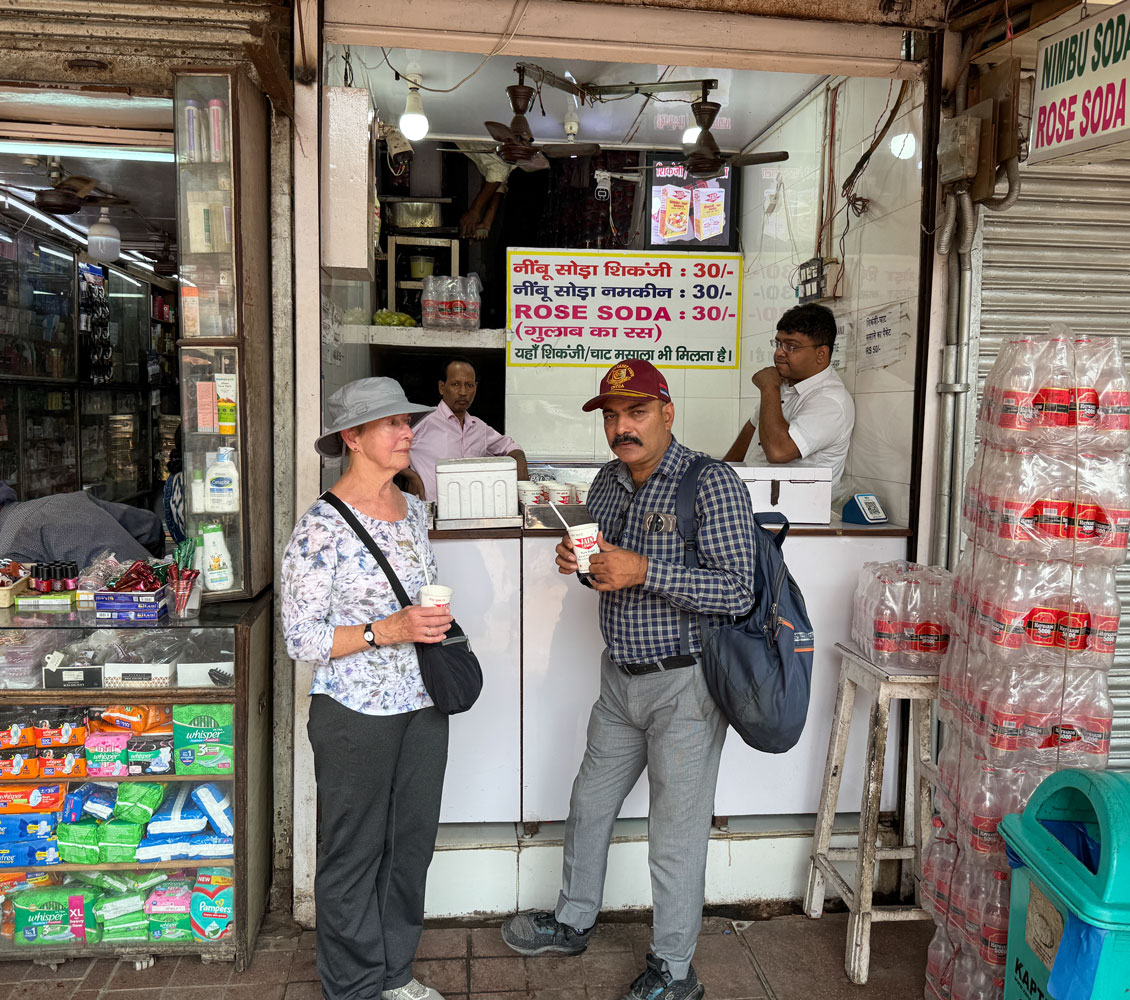
Diwalii is coming, and merchants were selling products associated with the celebration.
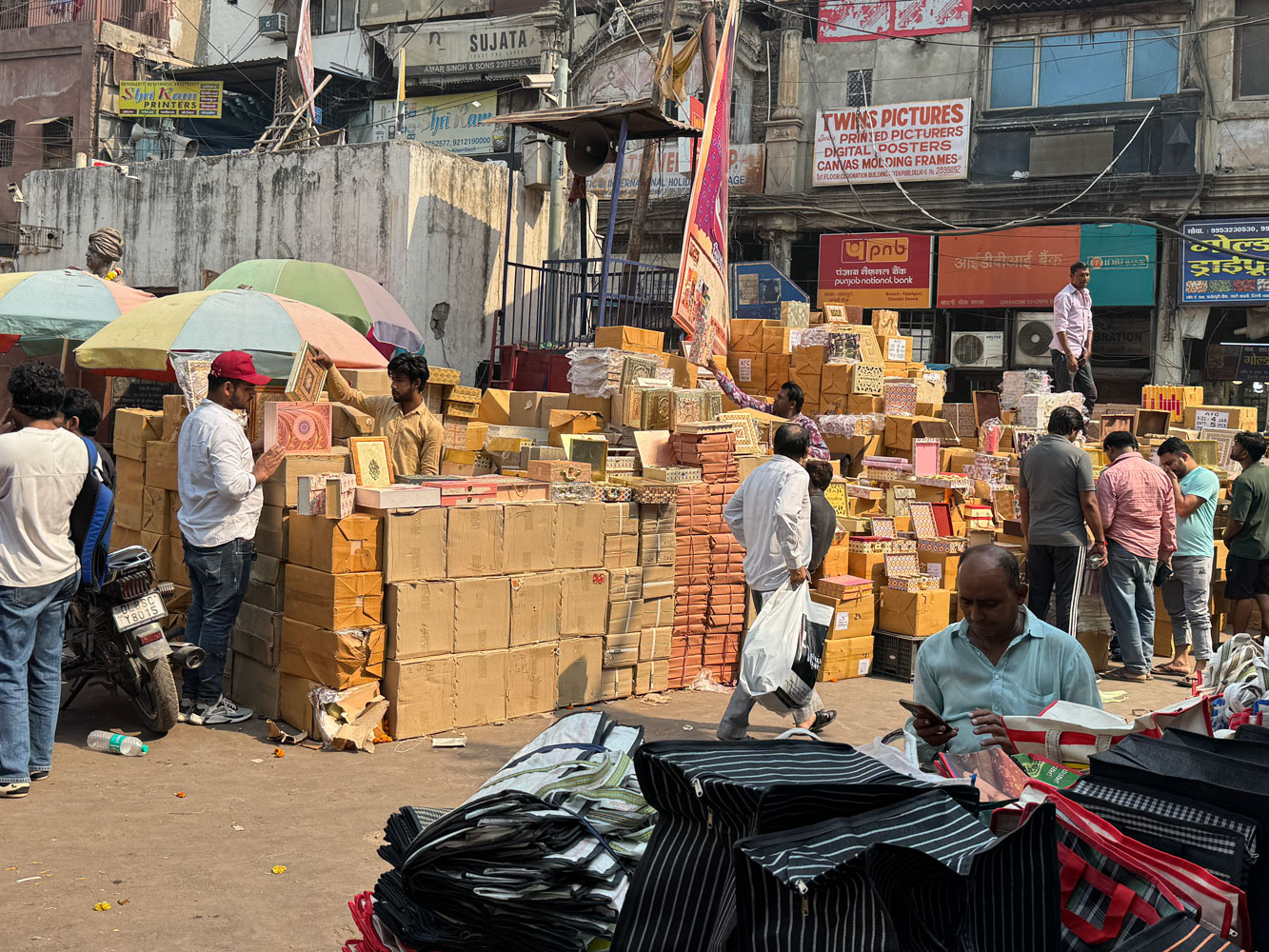
Some of the spices for sale.
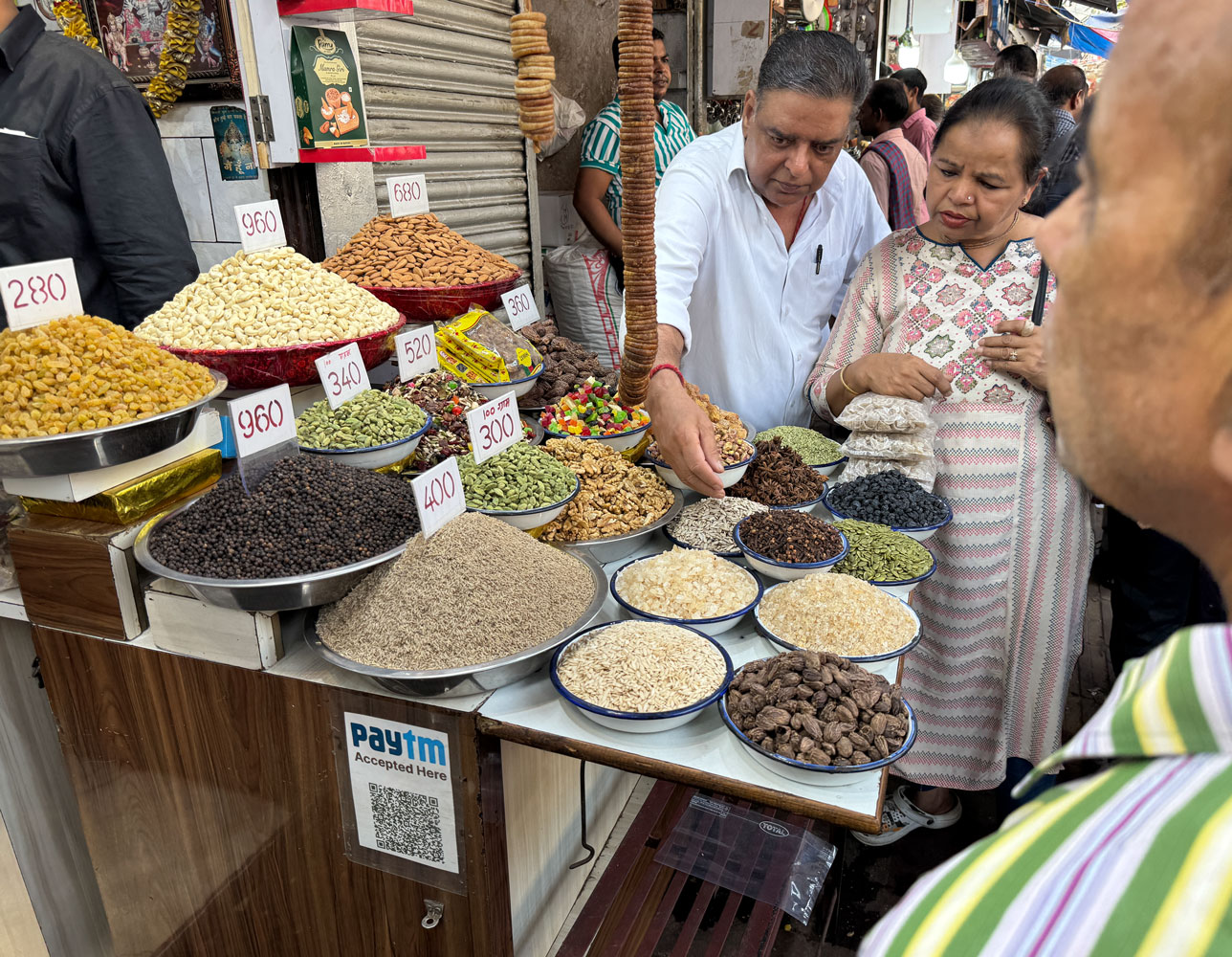
We walked through the area and looked at what the small shops had for sale. Then returned to the rickshaws and headed to Jama Masjid Mosque.
On the way, I took a couple of pictures of people along the road. Here's a Sikh man.
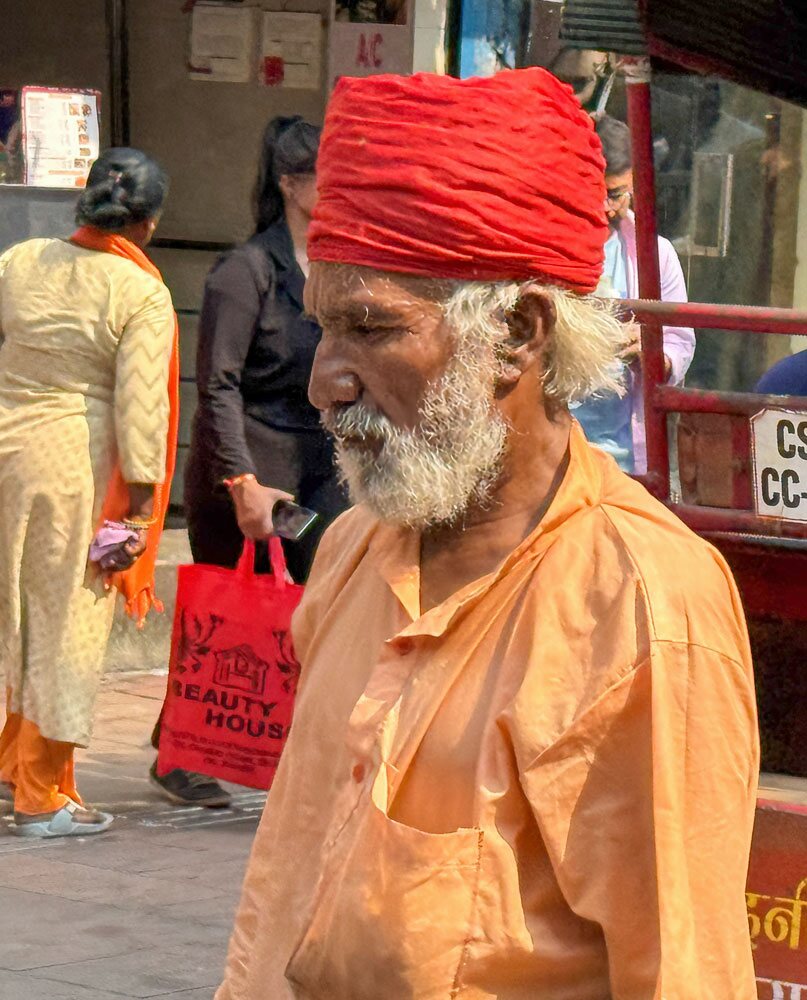
A rickshaw driver. I think his rickshaw was powered. That may be me reflecting in the glass behind him.
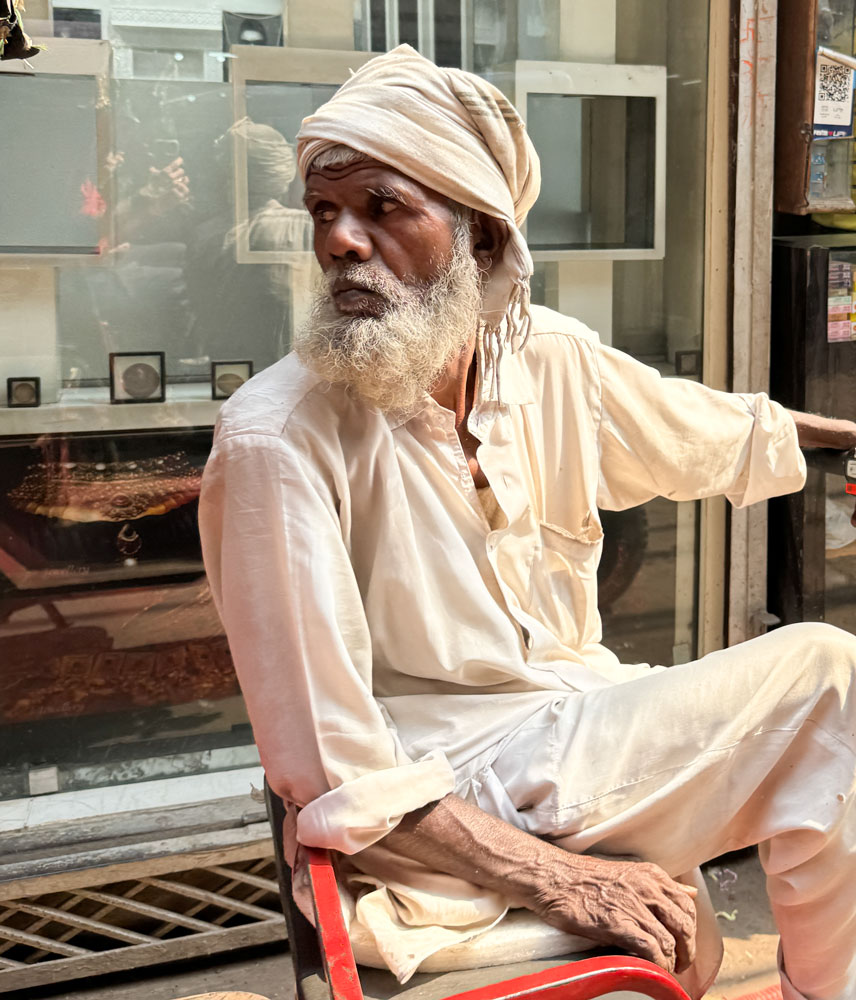
We arrived at the east gate of the Jama Masjid Mosque. The mosque was built in 1656.
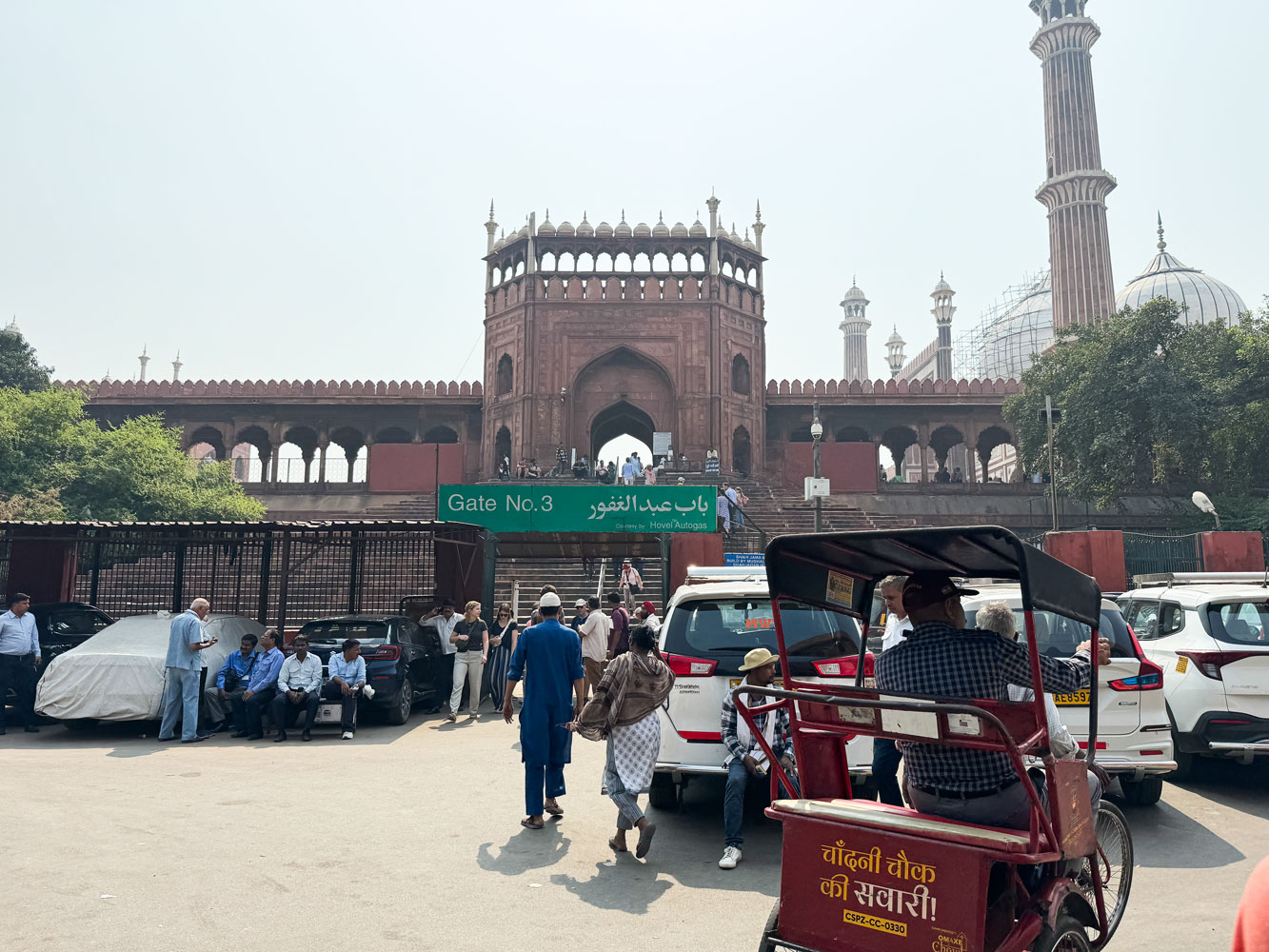
The mosque is elevated and there are a lot of steps to reach the platform.
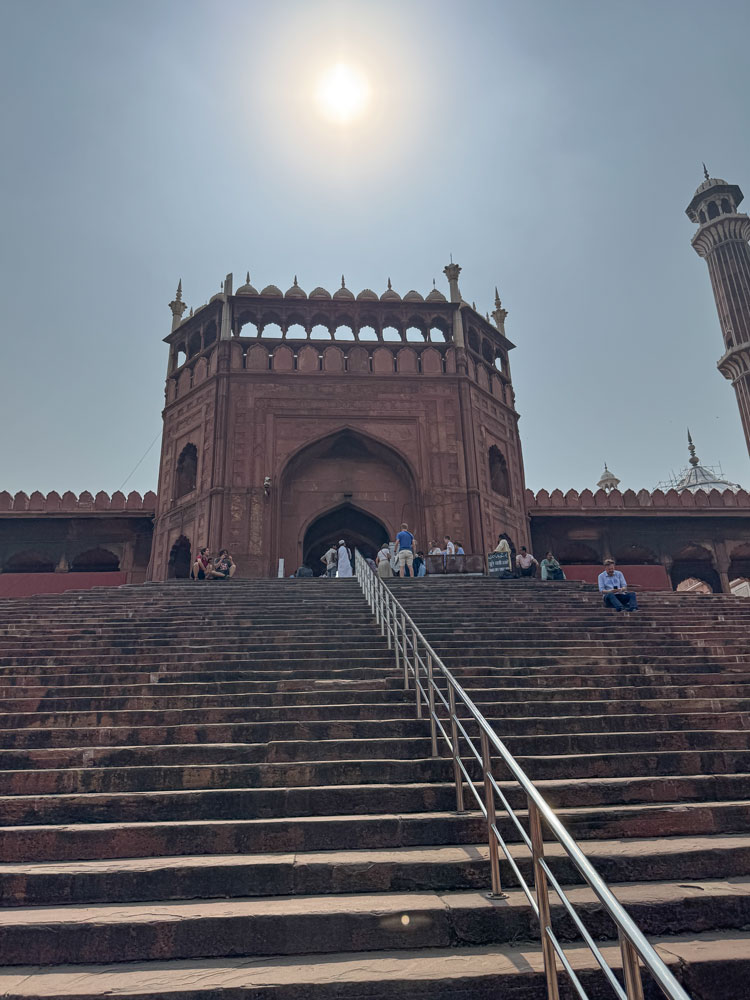
Steps are not Judy's favorite, and she said she'd wait at the bottom while Jitendra and I visited the mosque. But he went down and convinced her to come up, and escorted her up the steps. He already had his shoes off. We had to remove our shoes to enter the mosque area.
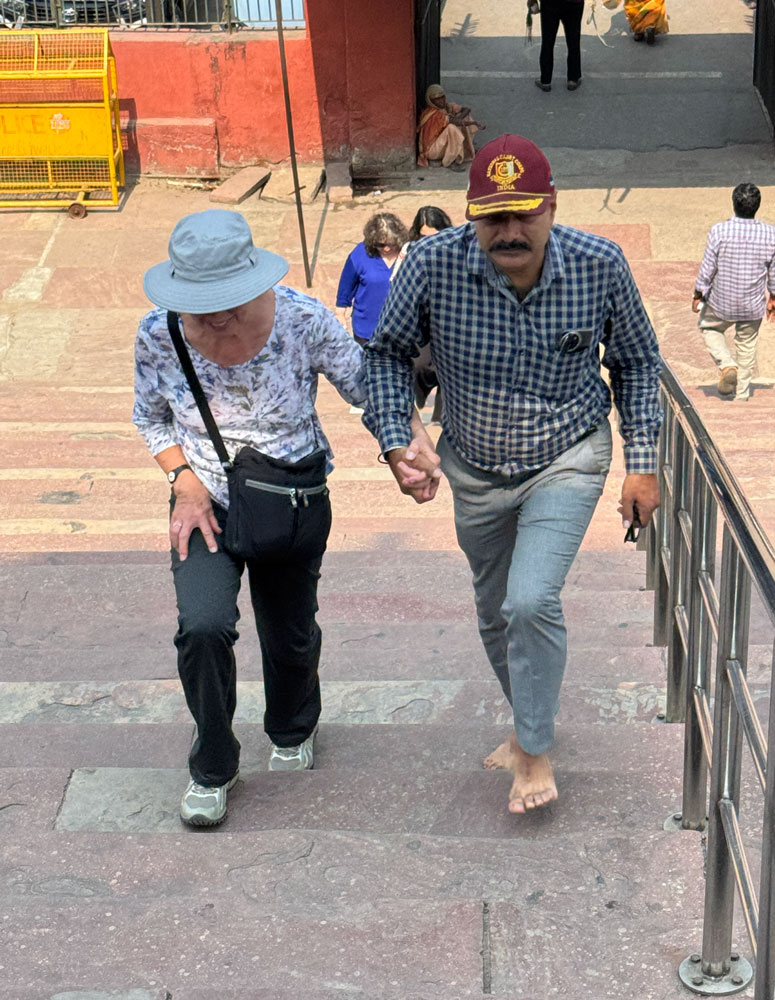
We removed our shoes and entered the area of the mosque. The building is actually very long and narrow. There are a number of mihrabs set into the back wall of the mosque. Almost all of the people praying at the mosque would be in the area outside the building, itself, but within the walls of the compound. Most people would bring their own rug to use during their prayers.
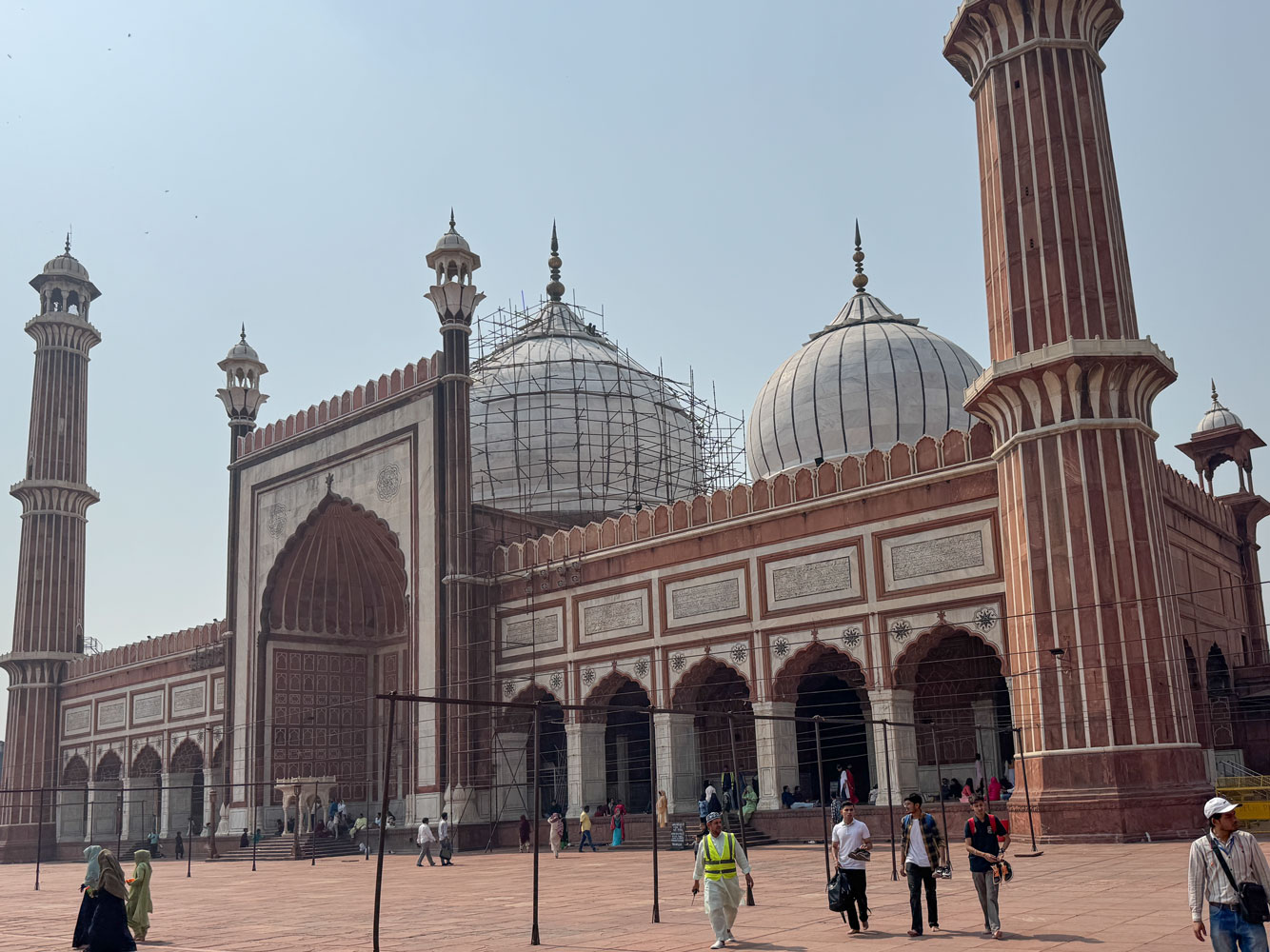
Here's a look along the mosque building. The mihrabs (and there were several) are to the left in this picture.
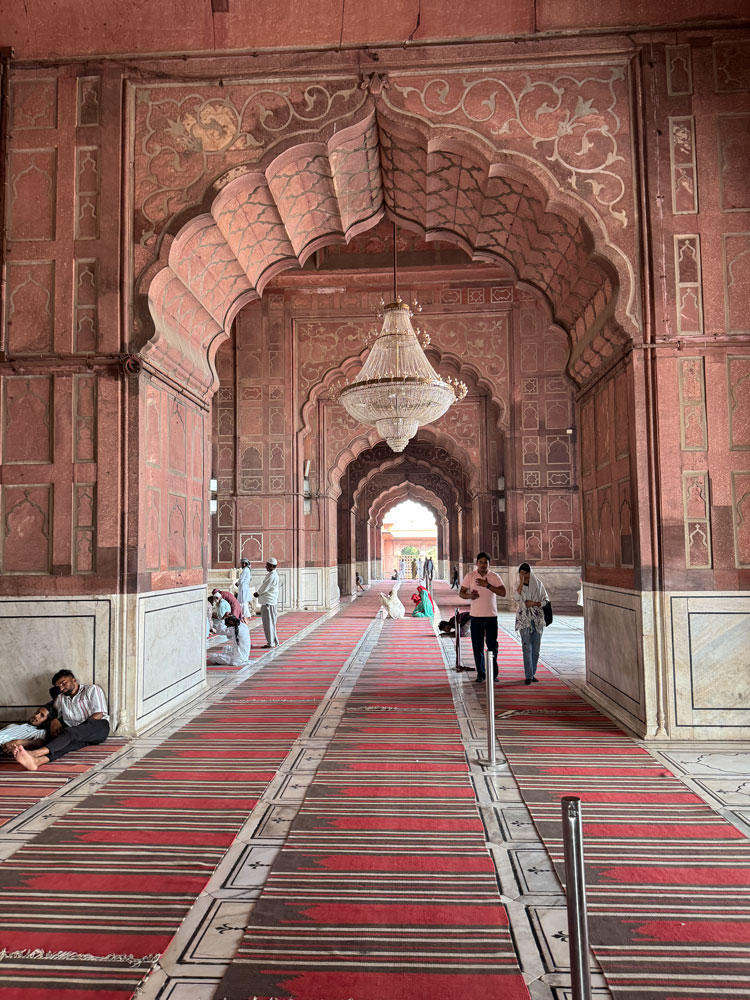
A view from the mosque building. The water feature in this picture is the wudu area where people wash before praying.
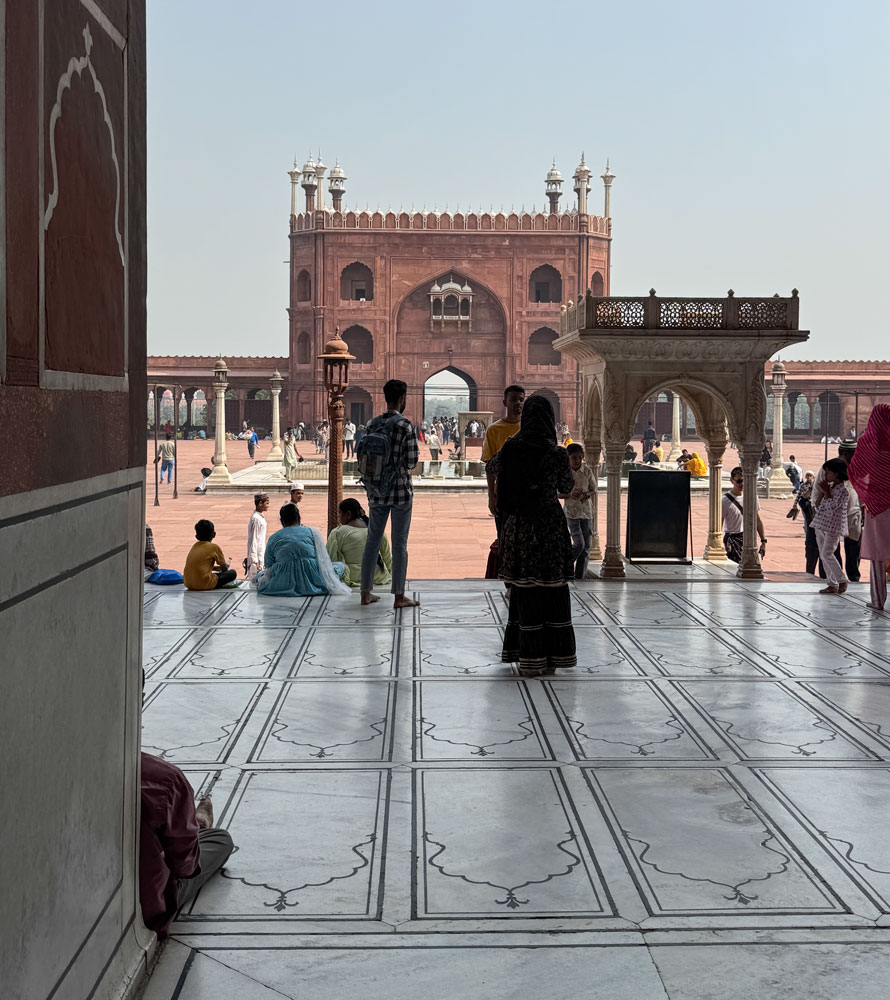
We left the mosque and went to where Pardeep was parked. Jitendra paid the rickshaw drivers and we headed to Raj Ghat, where a portion of Mahatma Gandhi's ashes are located.
When we got there, we discovered it was an educational outing day for school children. There were a LOT of kids there, of all ages.

The kids were very friendly and waved to us. Many of them wanted to shake our hand.
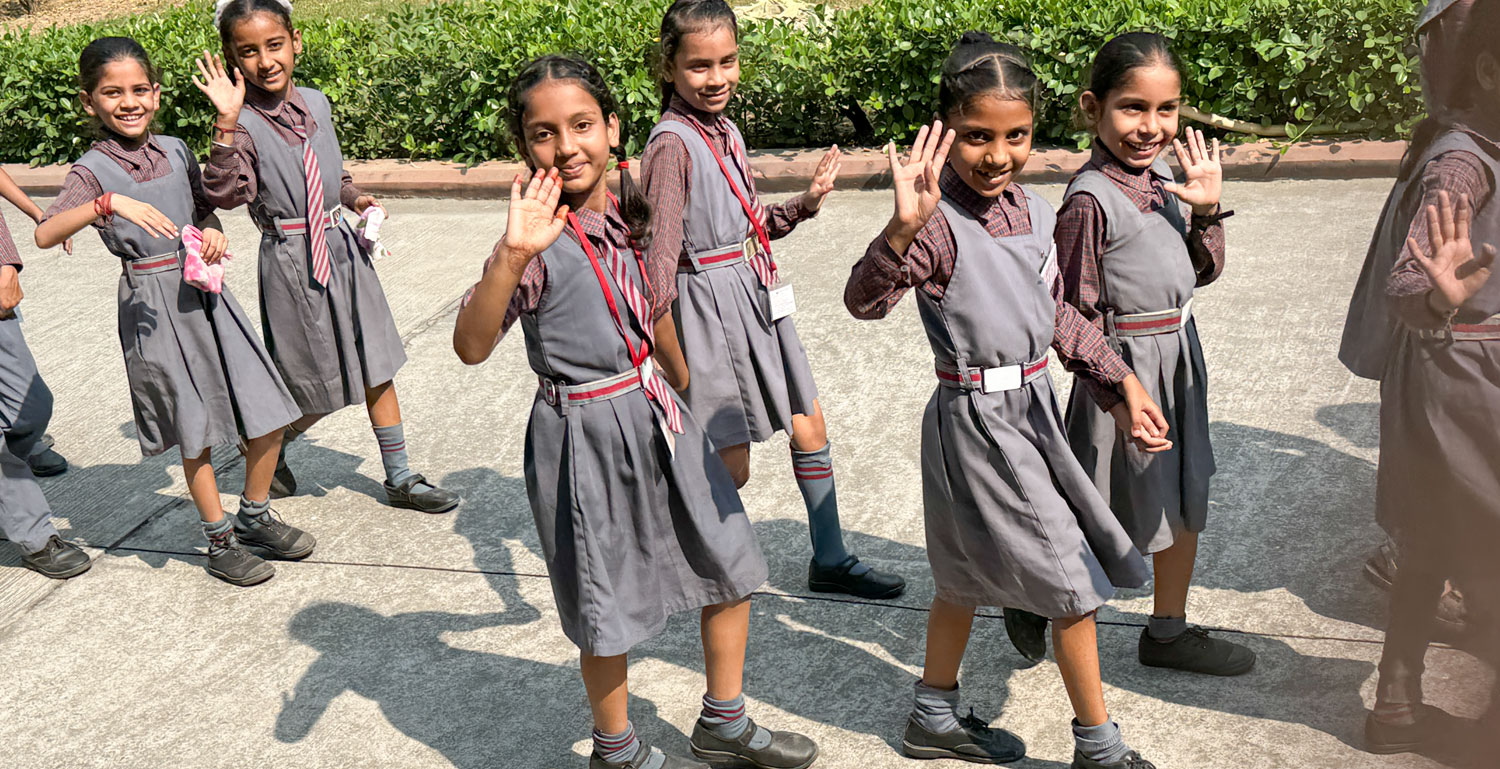
We viewed Gandhi's memorial. To go to the memorial, you need to remove your shoes so we just observed it from the wall.

Jitendra insisted on taking our picture at the memorial.
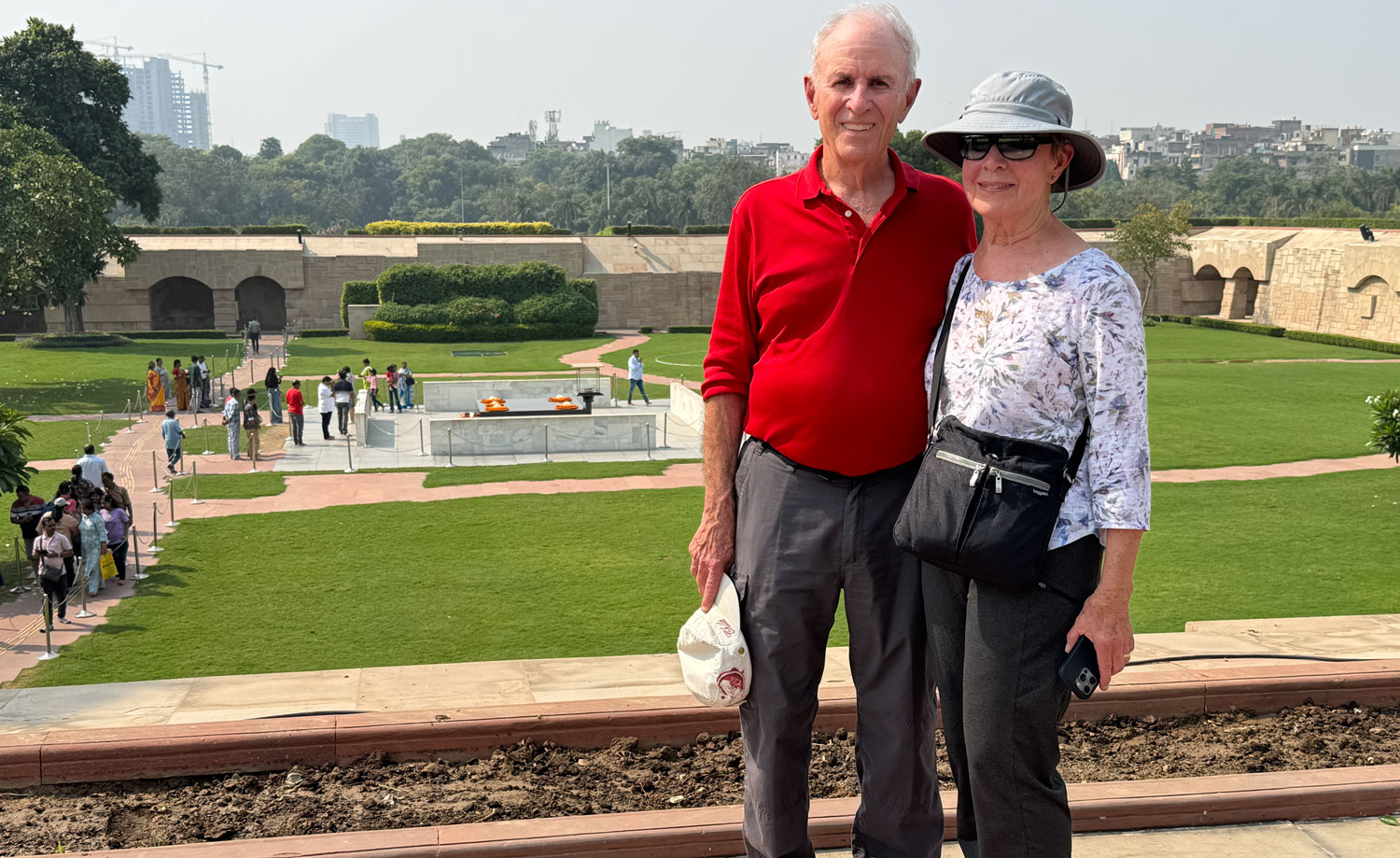
It was getting fairly hot now, and it was 2:30pm, so we went to an Indian restaurant for lunch. As usual for Indian meals, there was too much food, but we enjoyed it and the time with Jitendra.
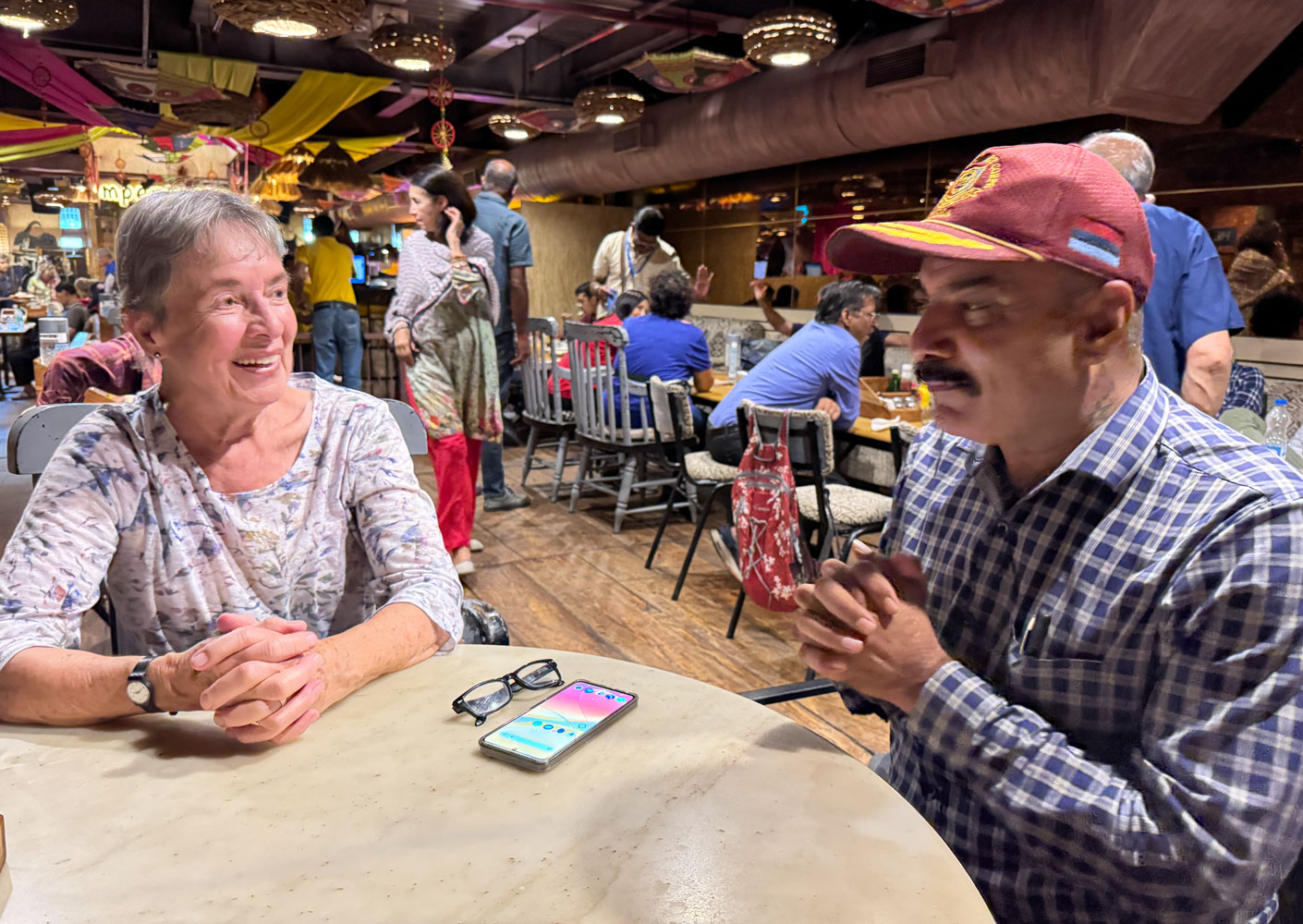
After lunch, he took us to two shopping places, but the last thing we need is more "stuff". Judy did purchase an inexpensive pendant at the second place, just as a souvenir of our trip.
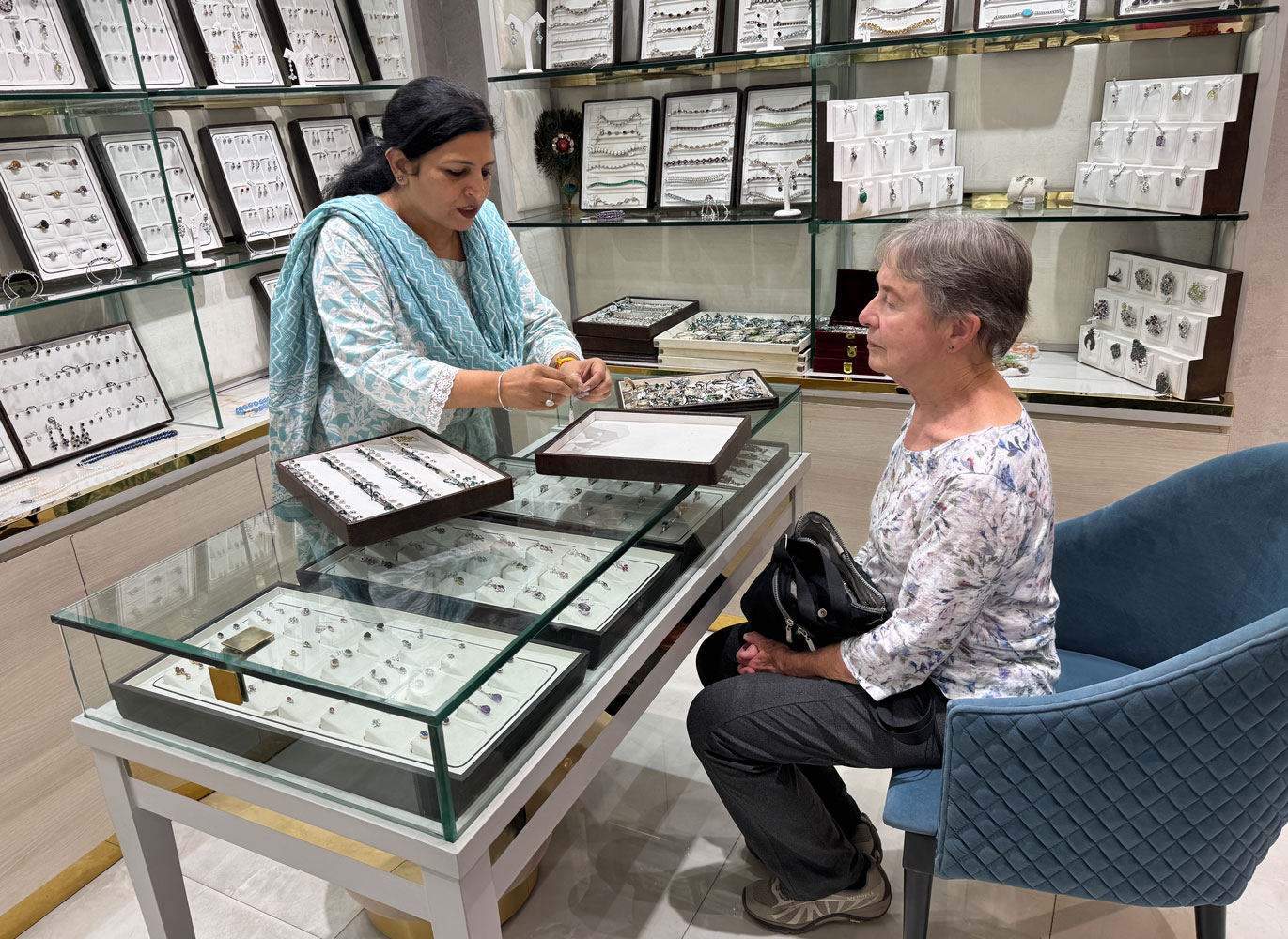
With that, the car took us back to the hotel about 5pm, and we settled up with Jitendra.
I was really exhausted by that time and fell asleep. Judy took a shower and eventually I woke up. About 10pm we went to bed with the hope that we'd sleep all night.
+++++++++++++++++++++++++++++++++++++++
10/20/2024 (Sunday, Delhi) We did manage to sleep almost all night - we woke up about 5:30am. The Tauck part of the tour officially starts today with a meeting at 1:30pm in the ballroom.
After breakfast, we took it easy in the room, with Judy reading and me working on this blog.
A bit before 1:30pm we went down to the ballroom and met our tour guide, Annie Dowling. (This picture was taken later in the evening)
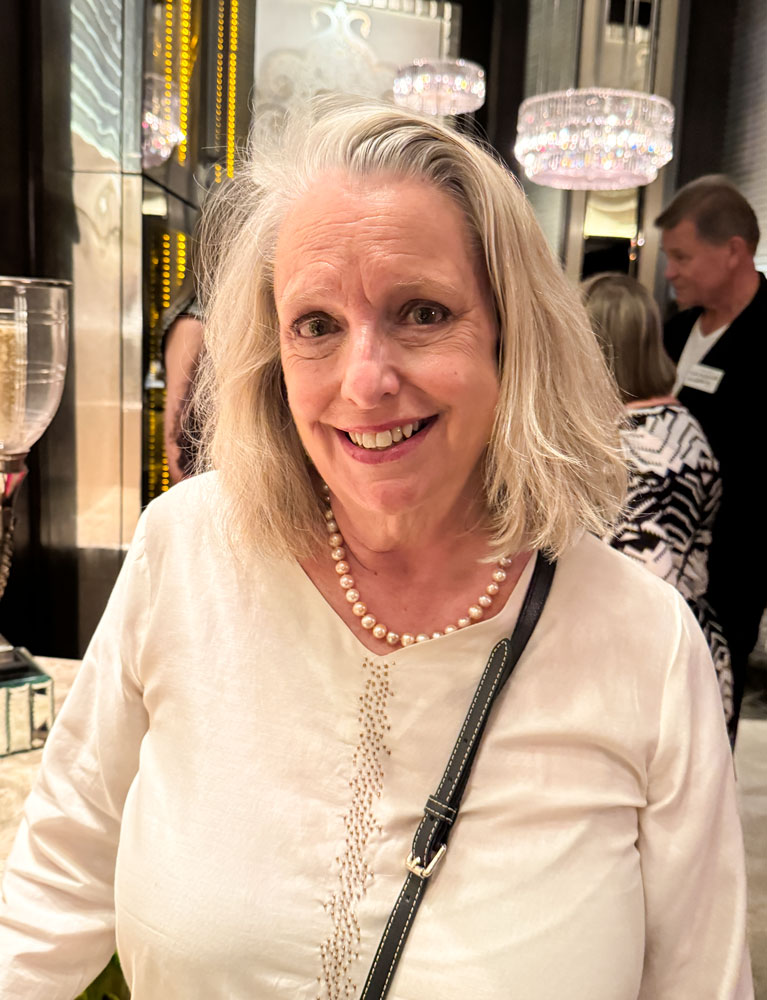
Annie introduced herself, gave us a briefing on the tour, and handed out the Vox units.
++++++++++++++++++++++++++++++++++++++++++++++++
[Update: I have repeatedly complained to Tauck about the Vox units for people who wear over-the-ear hearing aids. The earpieces provided with the Vox units either fit into your ear, or over your ear. Obviously, the earpieces that fit into your ear won't work for people who wear hearing aids - of any type. We'd have to remove our hearing aid to use the earpiece. The second type goes over your ear, but the "speaker" is aligned with your ear canal. Over-the-ear hearing aids have the microphone above the ear so these earpieces do not work for us.
Annie said that Tauck is planning to begin using Vox units next year that implement Bluetooth. That sounds like an improvement, but hearing aids do not implement full Bluetooth - they implement Bluetooth LE (Low Energy). Hearing aids don't have big batteries and regular Bluetooth takes a lot of power. An AirPod will only last about 6 hours on a charge.
The Bluetooth standards group defined Bluetooth LE specifically for hearing aids. But Bluetooth LE will NOT interoperate with regular Bluetooth.
In conversation with Tauck, I learned that the upcoming Vox units will not implement Bluetooth LE - just standard Bluetooth. So these new Vox units will not provide any advantage for hearing impaired people.
I'm really disappointed with Tauck that they won't give more consideration for their hearing impaired customers. Bluetooth LE is a standard and should not be any more difficult to implement than standard Bluetooth - the iPhone and Android phones implement both. It's just not a priority to Tauck to provide this feature.]
+++++++++++++++++++++++++++++++++++++++++++++++++++
Then we introduced ourselves - standard Tauck procedure, and had a short break before meeting again at 2:40pm to board the bus for a (mostly) driving tour of Delhi.
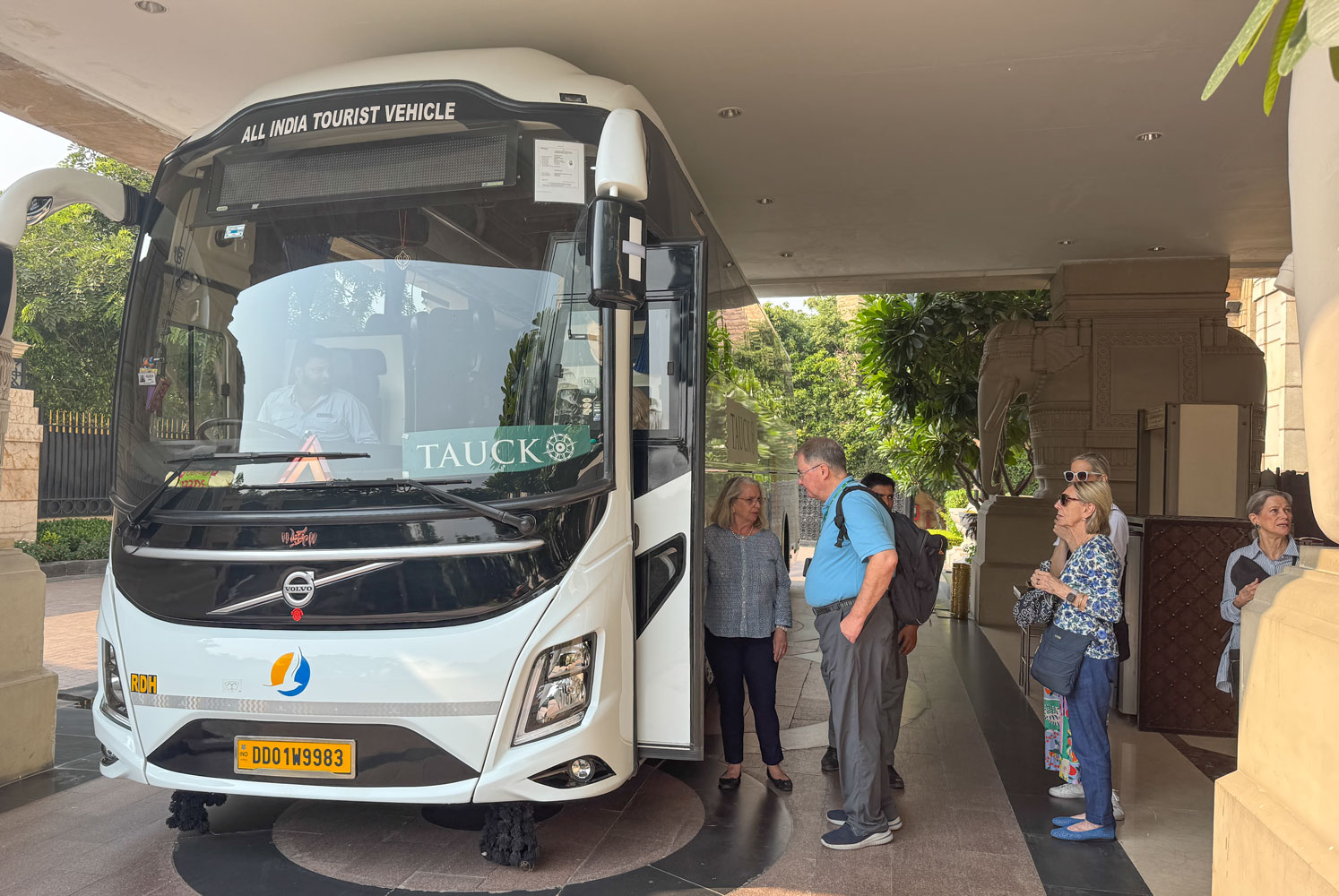
We also met our local guide, Samidha Singh.
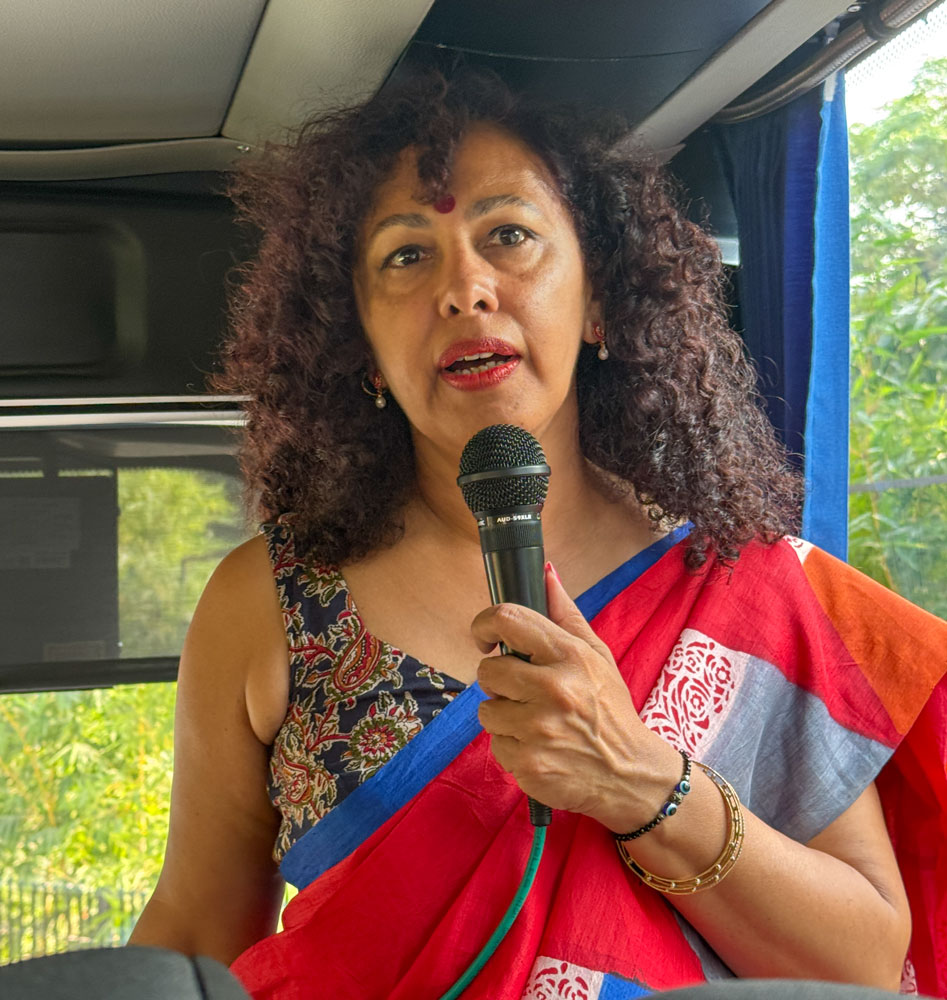
The first part of the drive was just looking at buildings, mostly government buildings in New Delhi, not too interesting. No pictures - it's very difficult to get pictures from a moving bus, and through the windows. And, half of the time I was on the wrong side of the bus.
Then we went to the place where Mathma Gandhi was assassinated on January 30, 1948, the Birla House, now called the Gandhi Smriti. I have only slight knowledge of Gandhi's life and death so this was interesting. Here's an article on Gandhi's life.
On entering the property, the house on our left was where Gandhi was staying that day. It's now a museum.
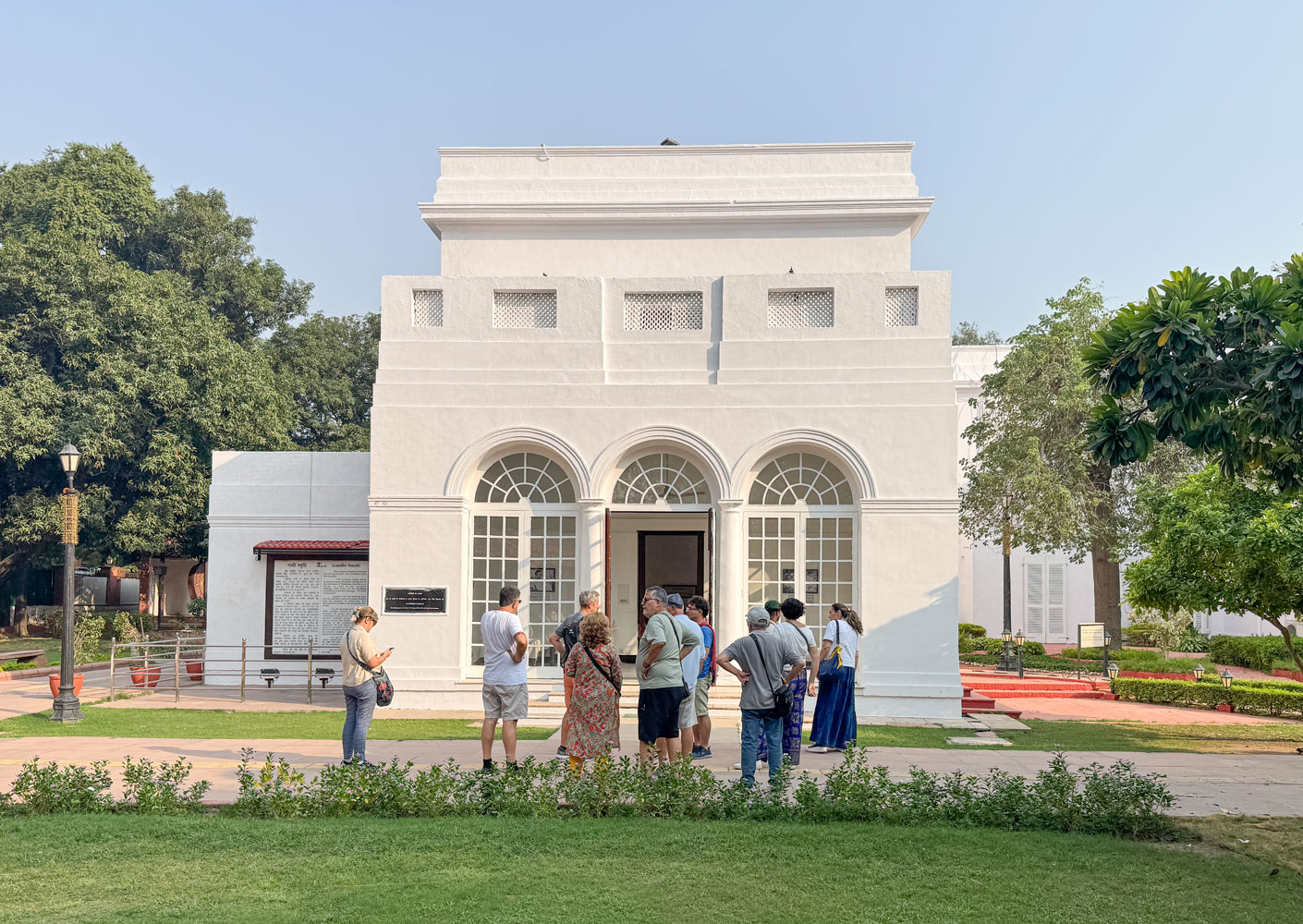
Around 5pm, Gandhi walked from the house to a raised section of the lawn where he held a multi-faith prayer meeting every day. They have the path from the house to the prayer area marked with Gandhi's steps
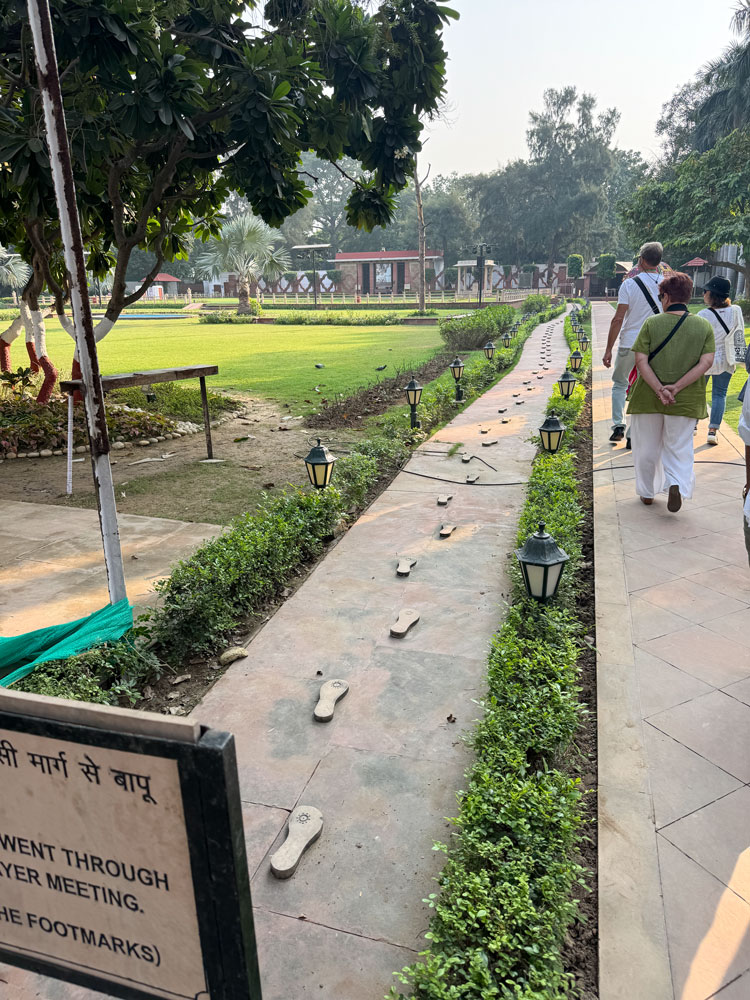
As he reached the dais, a Hindu radical, Nathuram Godse, stepped from the waiting crowd and shot Gandhi three times (Godse was captured and executed on November 15, 1949). Gandhi probably died immediately.
This memorial was erected where Gandhi fell.
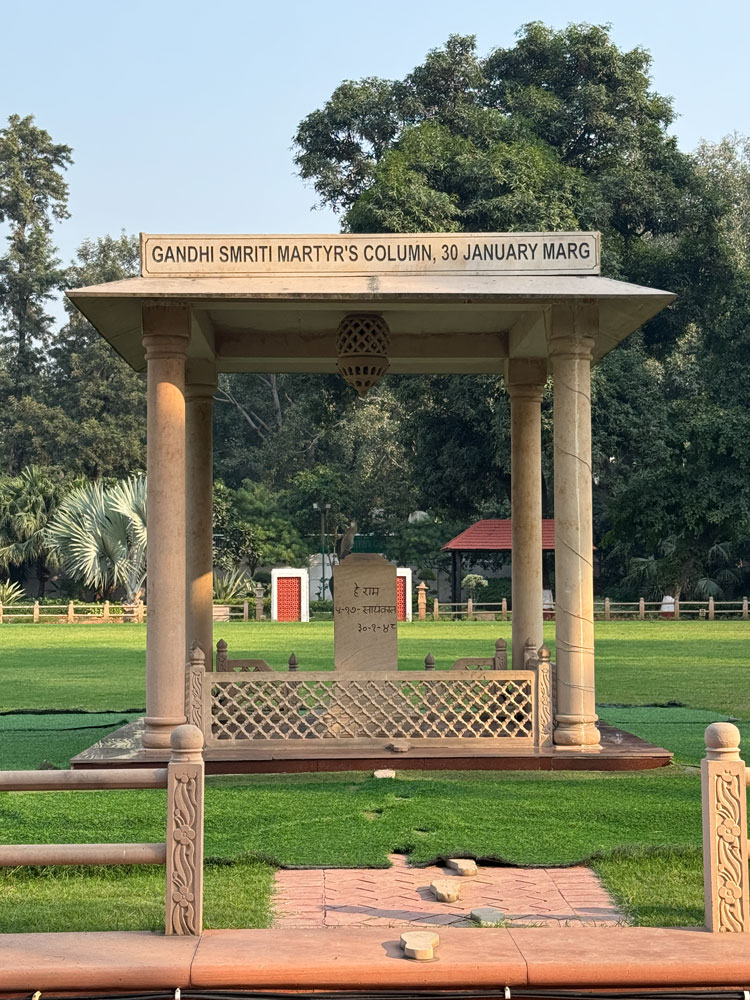
To understand Gandhi's efforts to achieve independence for India, you have to understand a bit of the British occupation of India. There's too much for me to write here but I'll give a very short description based on the research I've done so far.
The British East India Company first came to India in the 1600's, primarily for a base for their ships, and to trade with India. The East India Company was quite powerful back then and they eventually controlled much of India.
The goal of the East India Company was economic. India had natural resources and a large population. To be fair, Britain made significant contributions to India, especially in the development of the infrastructure.
But the British went too far in taking from India. For example, there was a British company that produced salt in India. The people of India needed salt, but the British levied a significant tax on salt, which affected poor people the most, since the tax was a large percentage of their income.
Gandhi led a "Salt March" in March of 1930 to the ocean, and proceeded to make salt from the seawater. The British arrested about 60,000 people, including Gandhi. But the salt protest led to protests against other British goods and weakened the hold of Britain on India.
In 1947 the British finally gave up and announced the partition of India into two countries, India and Pakistan. India to be Hindu and Pakistan, Muslim. This led to perhaps the largest movement of people in history as the Muslims of India went to Pakistan and the Hindus of Pakistan moved to India. The total number of people who moved is between 14 and 18 million. As you can imagine, there was significant loss of life in that movement, and social upheaval.
Originally, Pakistan was to the west and east of India. East Pakistan eventually became Bangladesh.
These notes are based on some very short research, so check the sources for more information.
There is this statue of Gandhi on the grounds, purported to be of Gandhi spinning cotton into thread.
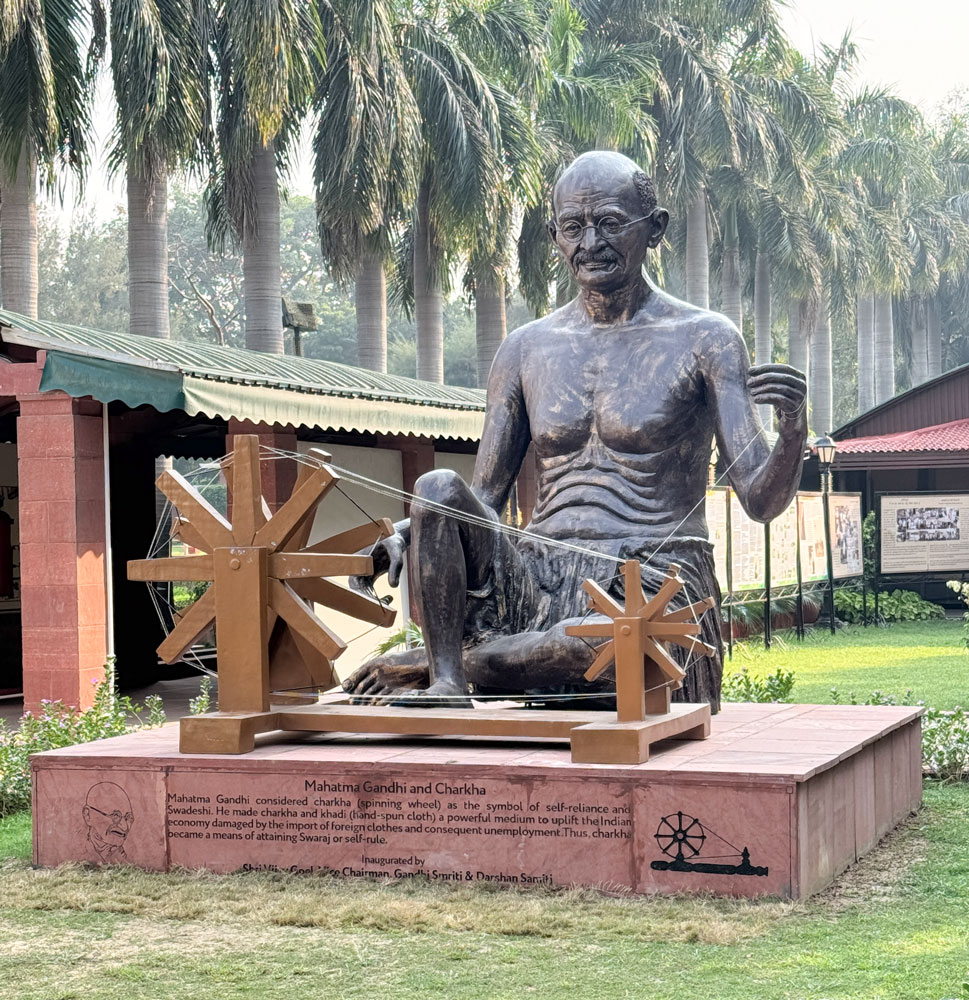
Britain purchased raw cotton from India at cheap prices and shipped it to England, where it was processed into cloth and clothes, both of which were shipped back to India. [Note: Britain tried the same thing with the American colonies and it didn't work there, either.]
Gandhi believed that Indians should process the cotton themselves and make it into cloth and clothes, called Khadi, and the pictures of Gandhi using a spinning wheel (called a charkha) and this statue are supposed to represent his drive to have India break free of British cloth products.
The pictures and this statue are not accurate. A spinning wheel is used to spin raw cotton into thread, so Gandhi should have raw cotton in his left hand, or cotton fibers on a distaff.
But the idea of processing raw cotton into cloth and clothes by hand was not very practical. It is an extremely labor intensive process. Picking the cotton by hand is no fun, then the fibers have to be separated from the seeds. Processing it into thread on a spinning wheel was slow. Prior to the Industrial Revolution this task was mainly done by women.
Then the thread has to be woven into cloth on a loom, another very labor intensive process which generally fell to women. The resulting cloth had to be finished, and then made into clothes.
The first product of the Industrial Revolution was probably cloth. It produced cloth at a fraction of the cost (and effort) that was required for hand processing.
But back to our visit.
We then went to the museum to see the exhibits representing the life of Gandhi.
Here's his bedroom.

Some exhibits.

Dioramas of Gandhi's life.
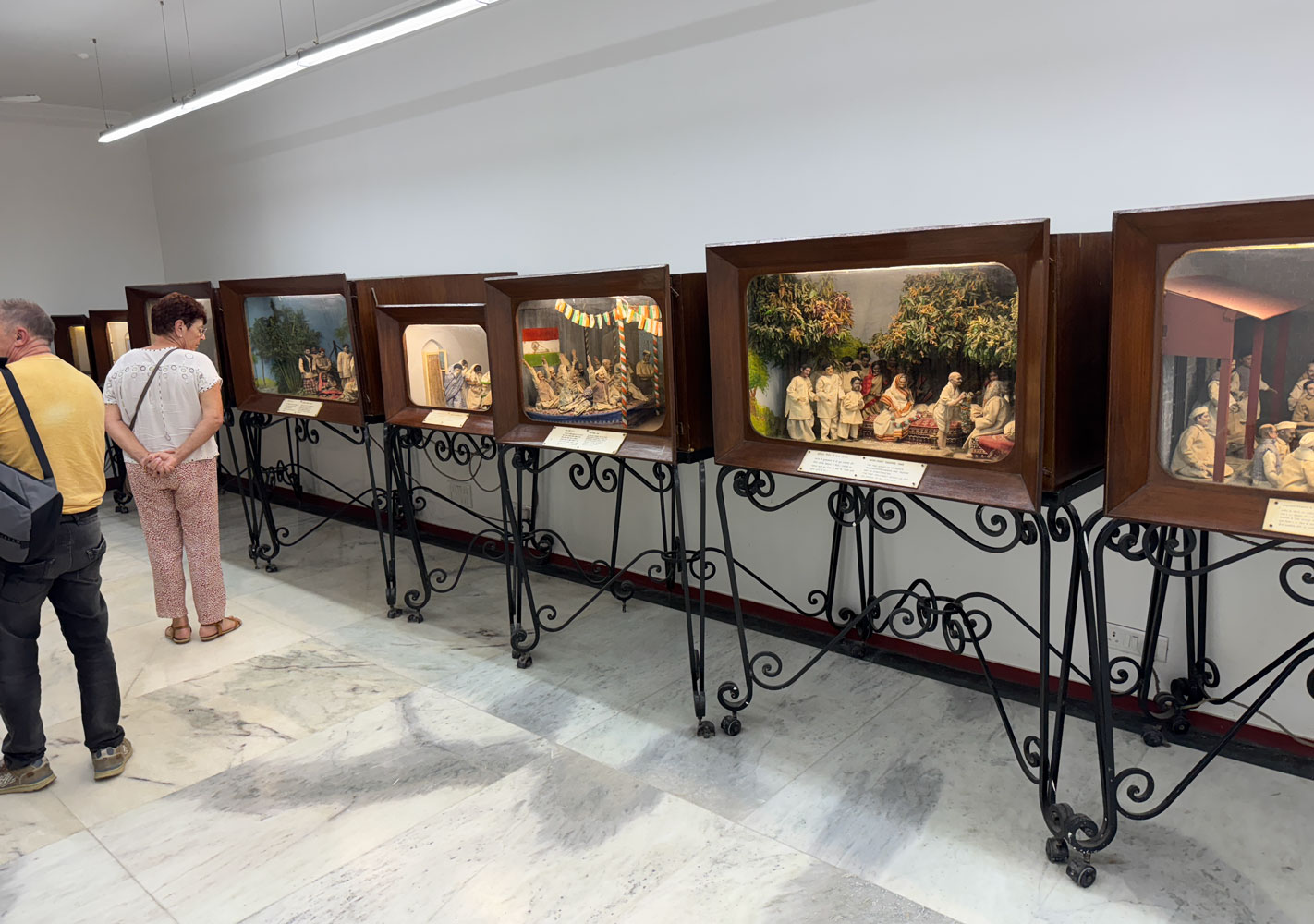
Then we re-boarded the bus and returned to the hotel. When we got to the hotel there were a number of military buses on the road alongside the hotel. We had to enter the hotel a different way. Never did find out why the soldiers were there, but Annie thought it might have been the presence of an important official.
We were free until 6:45pm, when we met for dinner. We shared a table with Linda and Kris from New Jersey.

The food was Indian, and featured a tasting menu of many different items.
After dinner, it was to bed to be ready for tomorrow's adventures.
+++++++++++++++++++++++++++++++++++++++
10/21/2024 (Monday) We slept the whole night through. I got up about 5:30am and we went to breakfast about 7. We met the group at 8:45 this morning.
As we drove to our first destination, we passed the Feroz Shah Kotla fort that was built in 1354.
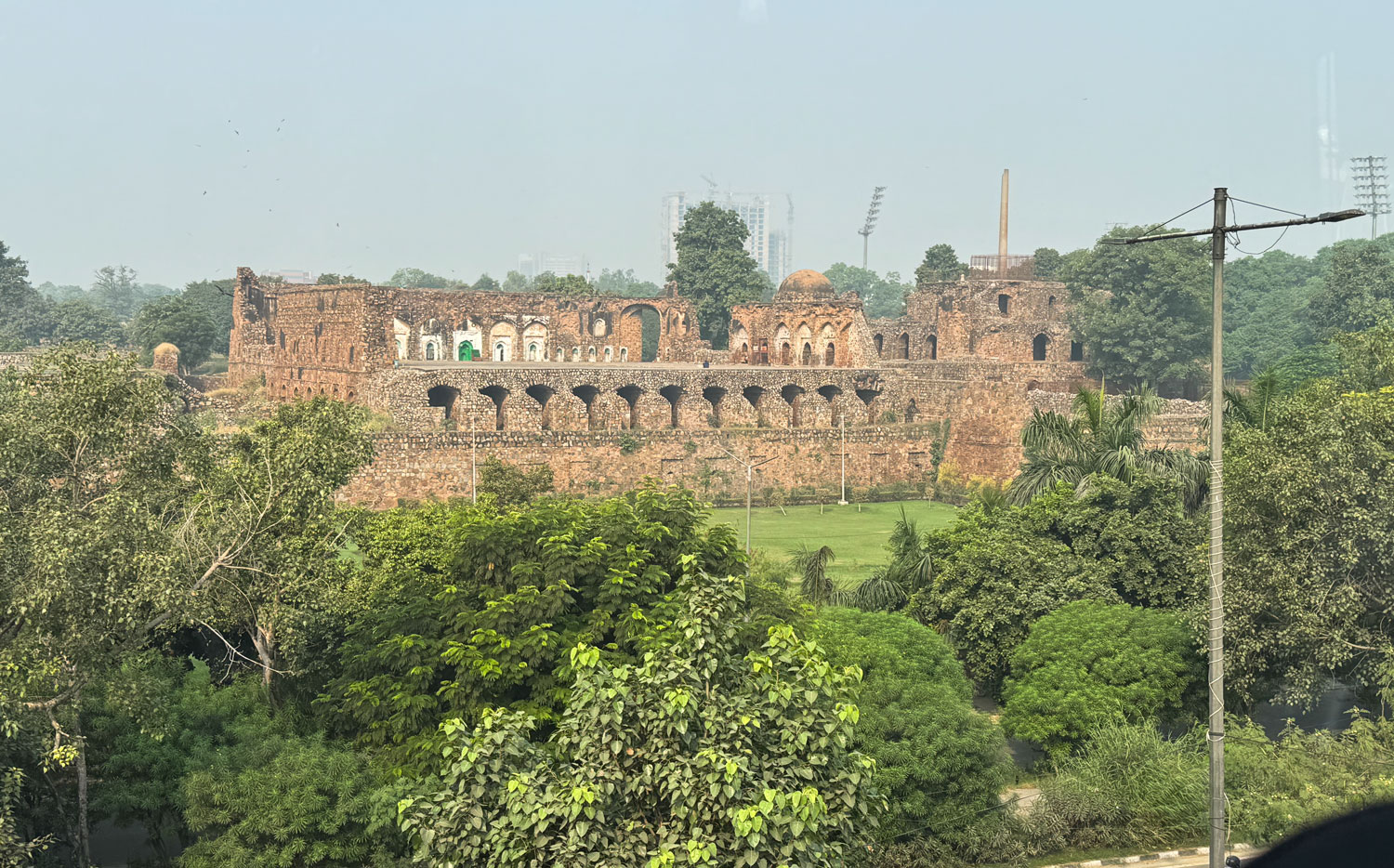
We entered Old Delhi and drove the same route as we did on October 19. We passed the Lahore Gate of the Red Fort. We eventually arrived at Humayun's Tomb.
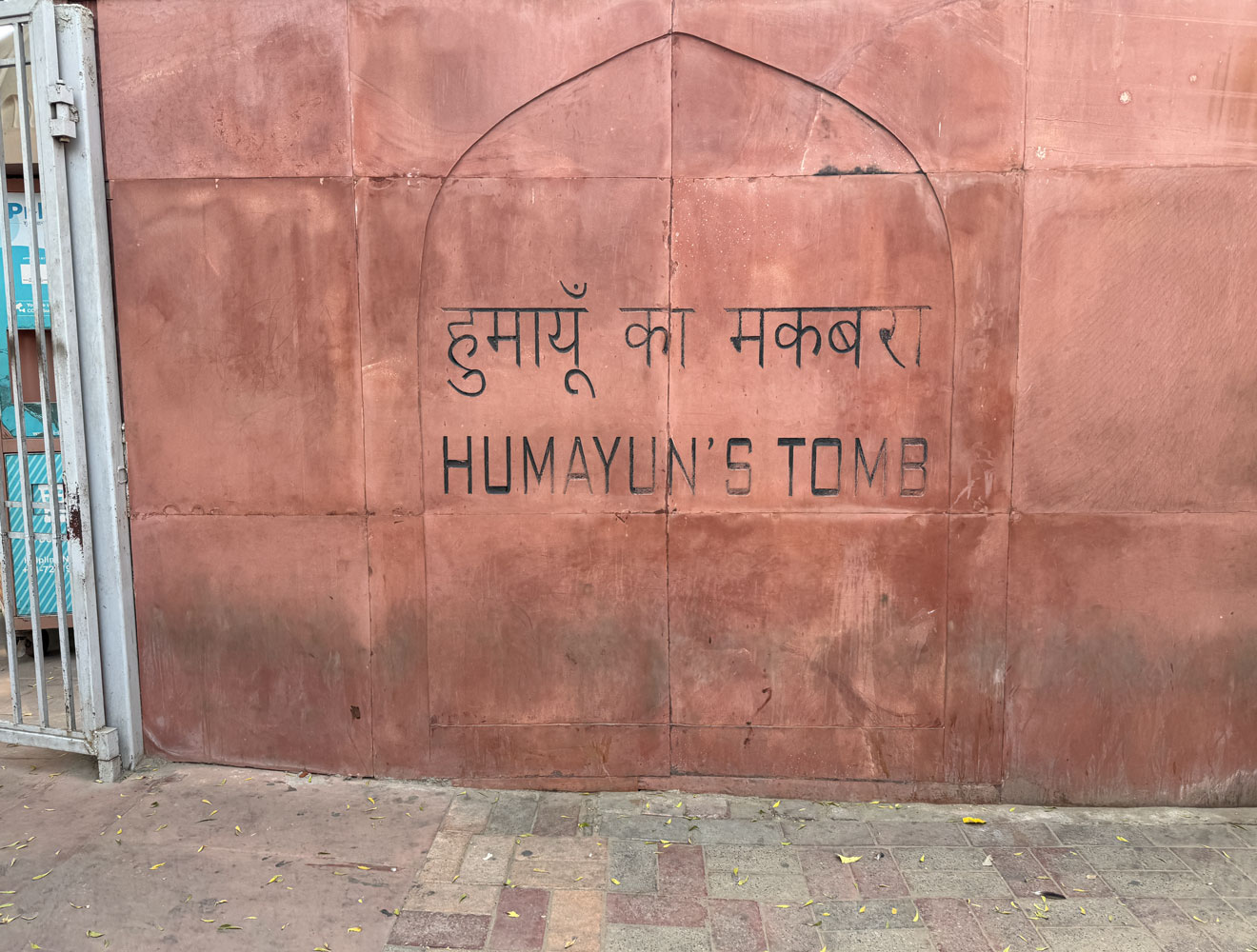
Humayun was a Mughal emperor who died in 1540. The tomb was constructed under the direction his first wife, Empress Bega Begum in 1558. The land that the tomb is built on is quite large and several tombs for other emperors were also built on it. I'll mostly only have pictures of Humayun's tomb. The air was cloudy with a lot of smoke and water vapor during our visit, so the pictures are not as clear as they should be.
As we walked into the complex, we could see the tomb of Isa Khan Niyazi, which predates Humayun's tomb by twenty years.
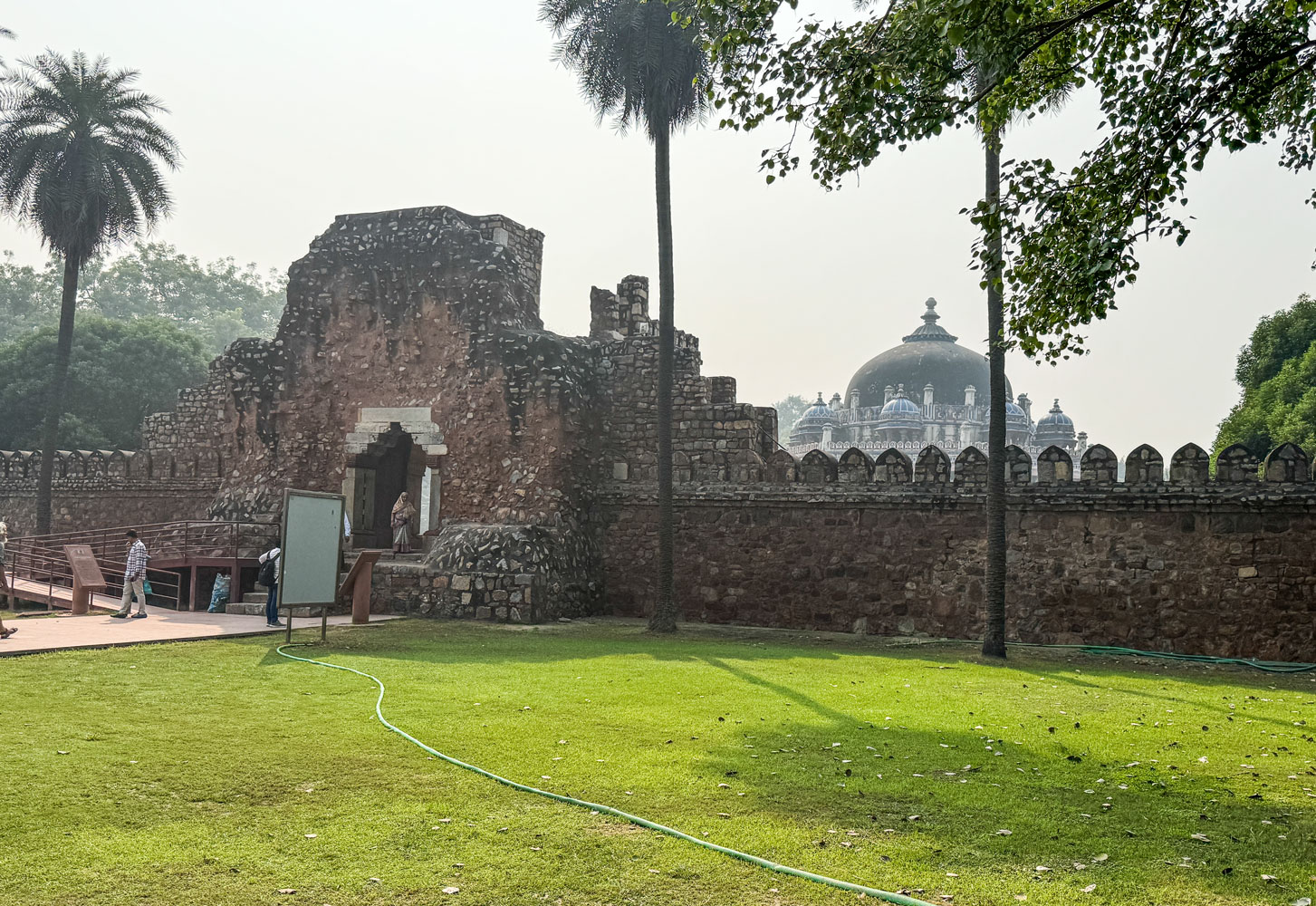
Here's a closer picture of that tomb.
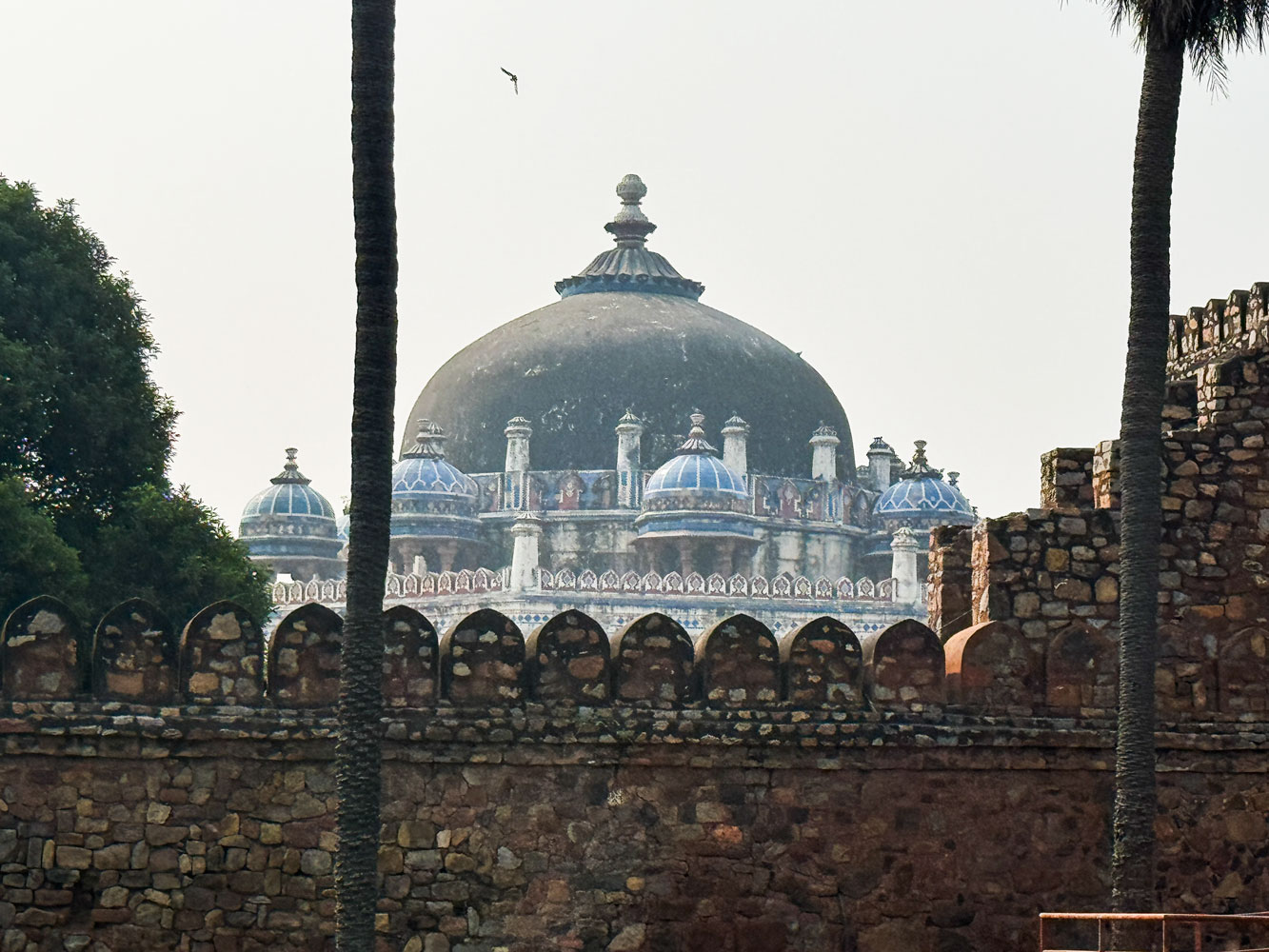
As we walked towards Humayun's tomb we passed through several gates. Here's the first.
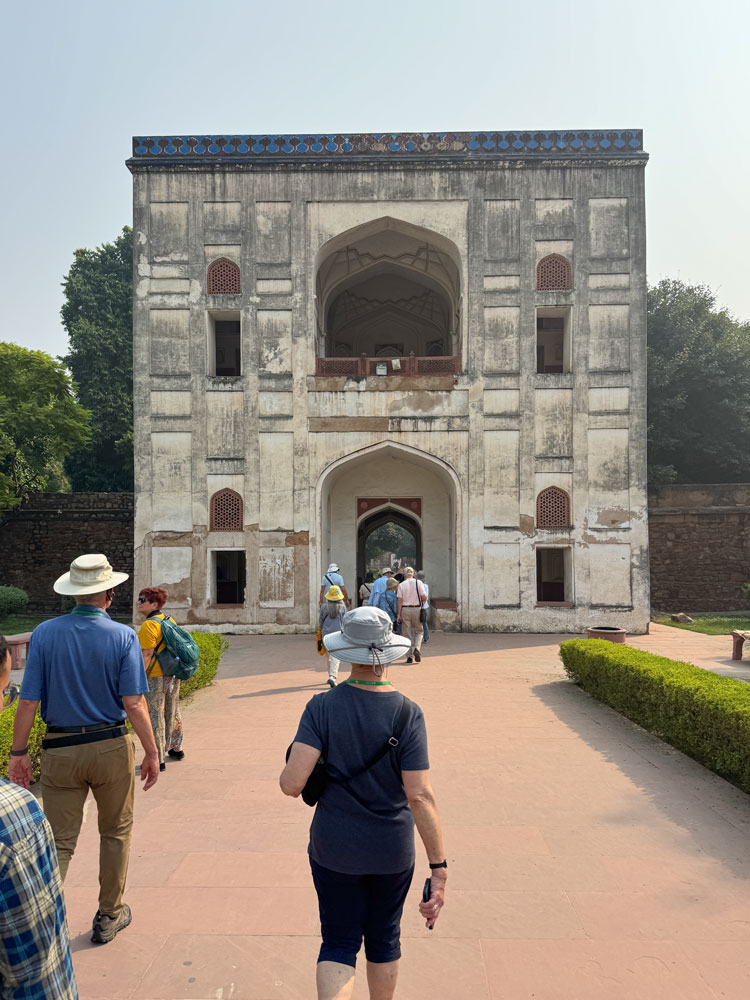
And the next gate, the Western Gate.

After we went through this gate we had a full view of Humayun's tomb.
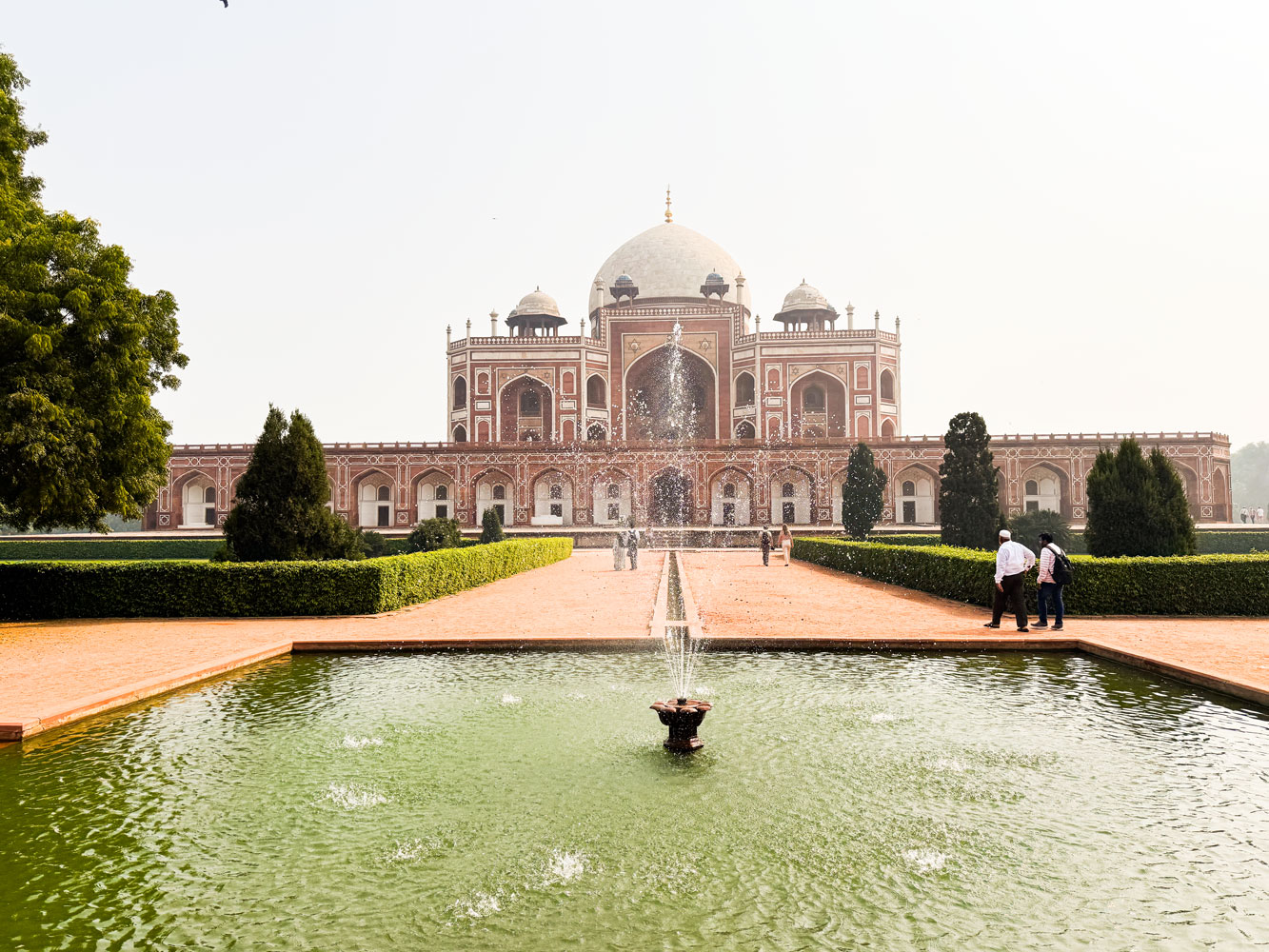
My picture does not do the building justice. Here's a picture from the web, specifically Wikipedia.
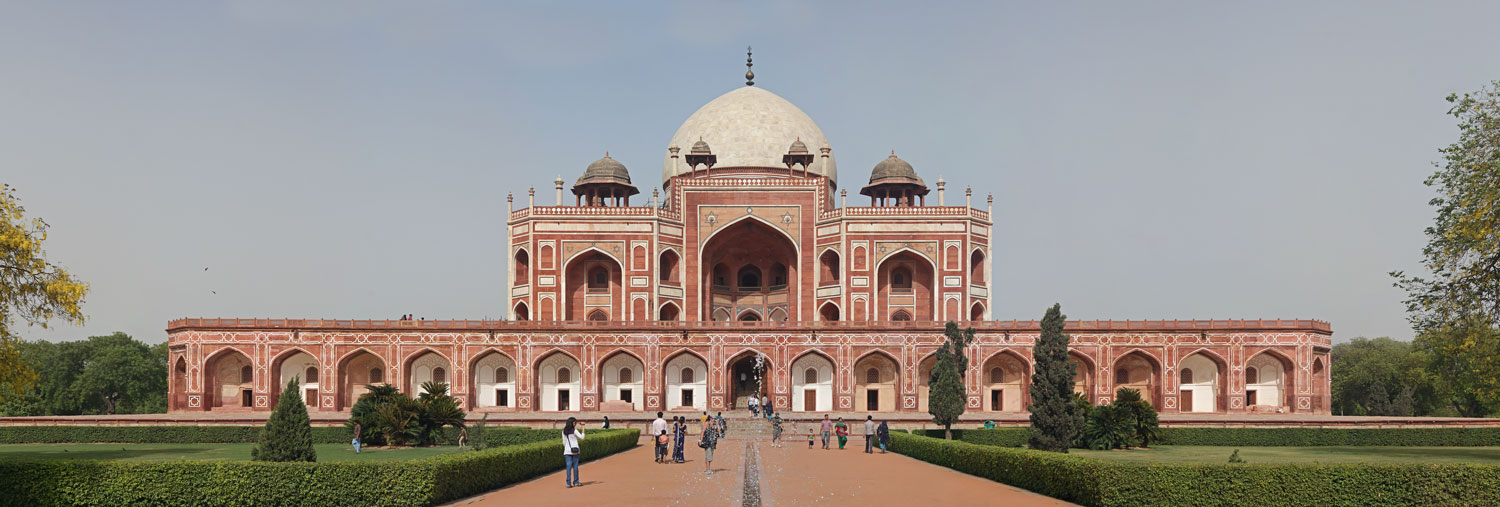
The structure is square and symmetrical - it looks the same from each side.
We entered the structure - the steps were steep.
A view of the interior.
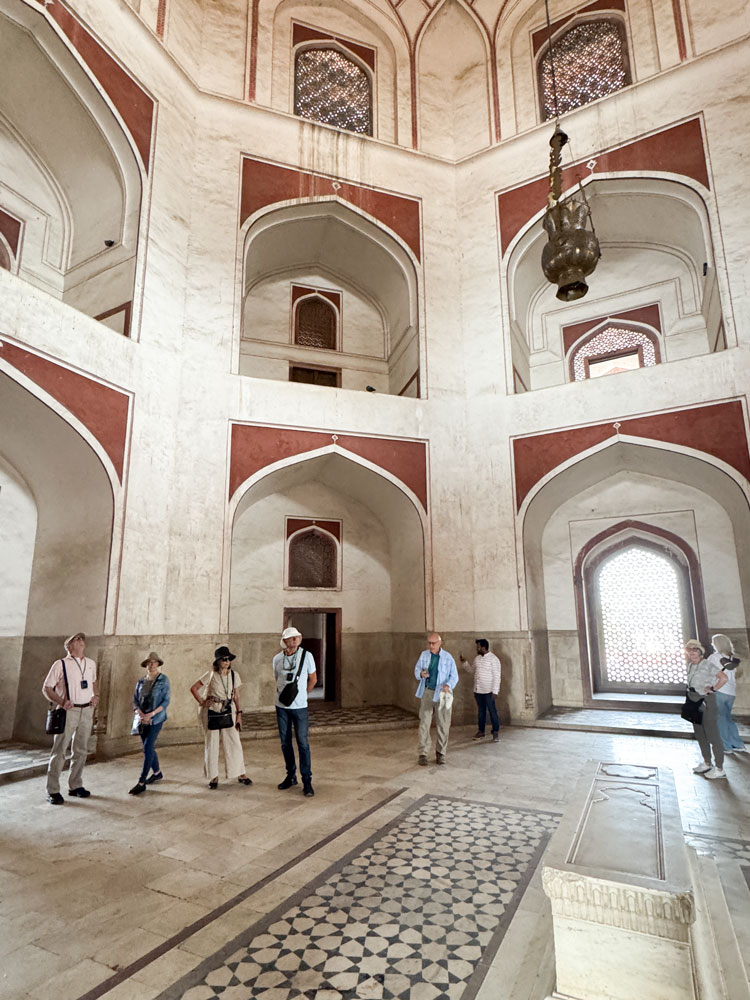
The ceiling of one of the lesser domes

The ceiling of the main dome.
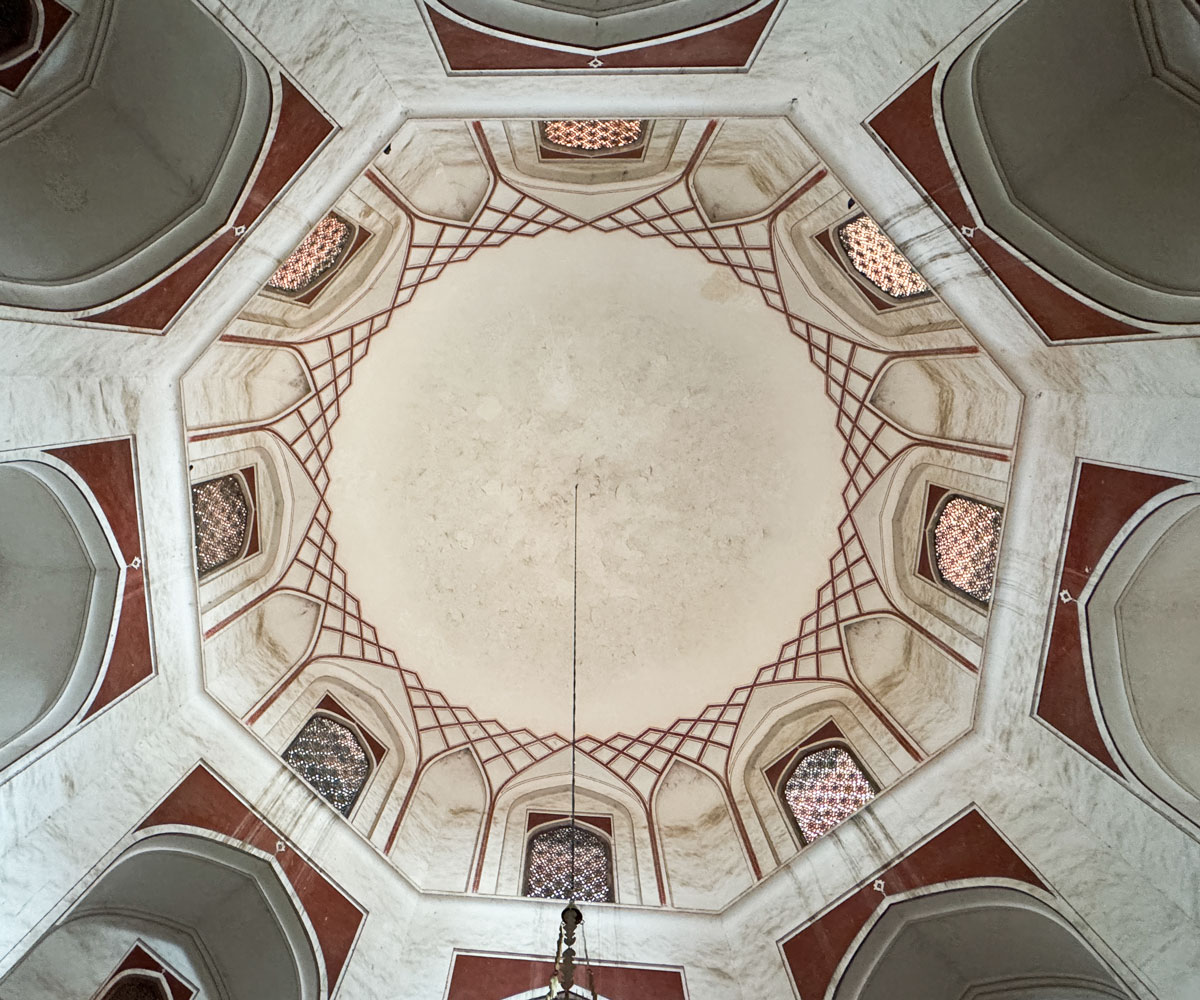
A platform under the main dome. The guide said that this side faces Mecca. Since in Islam the body of the deceased is placed on its side with the face towards Mecca, this is probably Humayun's Sarcophagus (could be a Cenotaph if his body was laid to rest elsewhere).
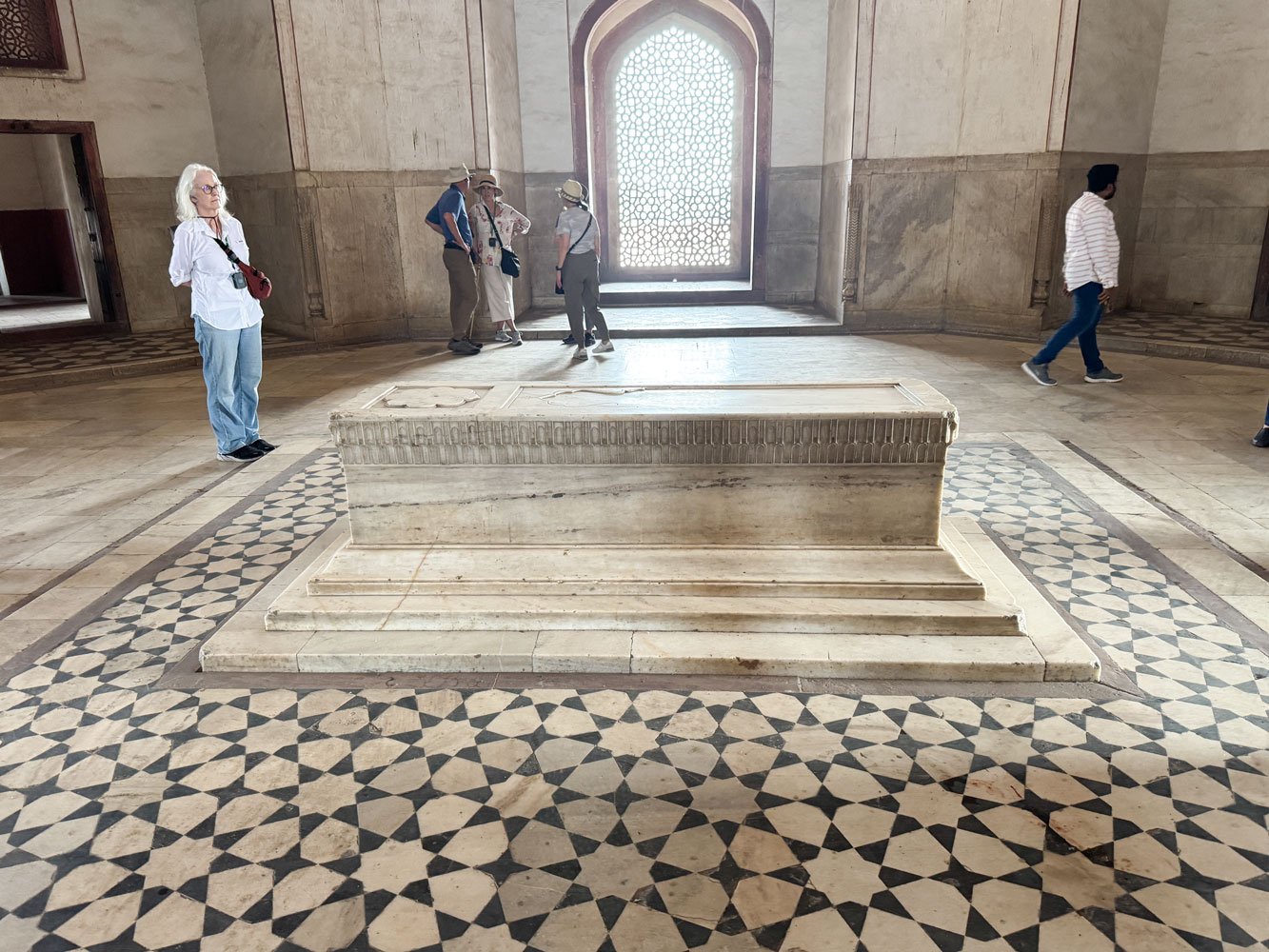
The main part of the tomb structure has a flat gallery. This is a view of the structure from that gallery. The opening in the foreground of the picture is one of the sets of steps.
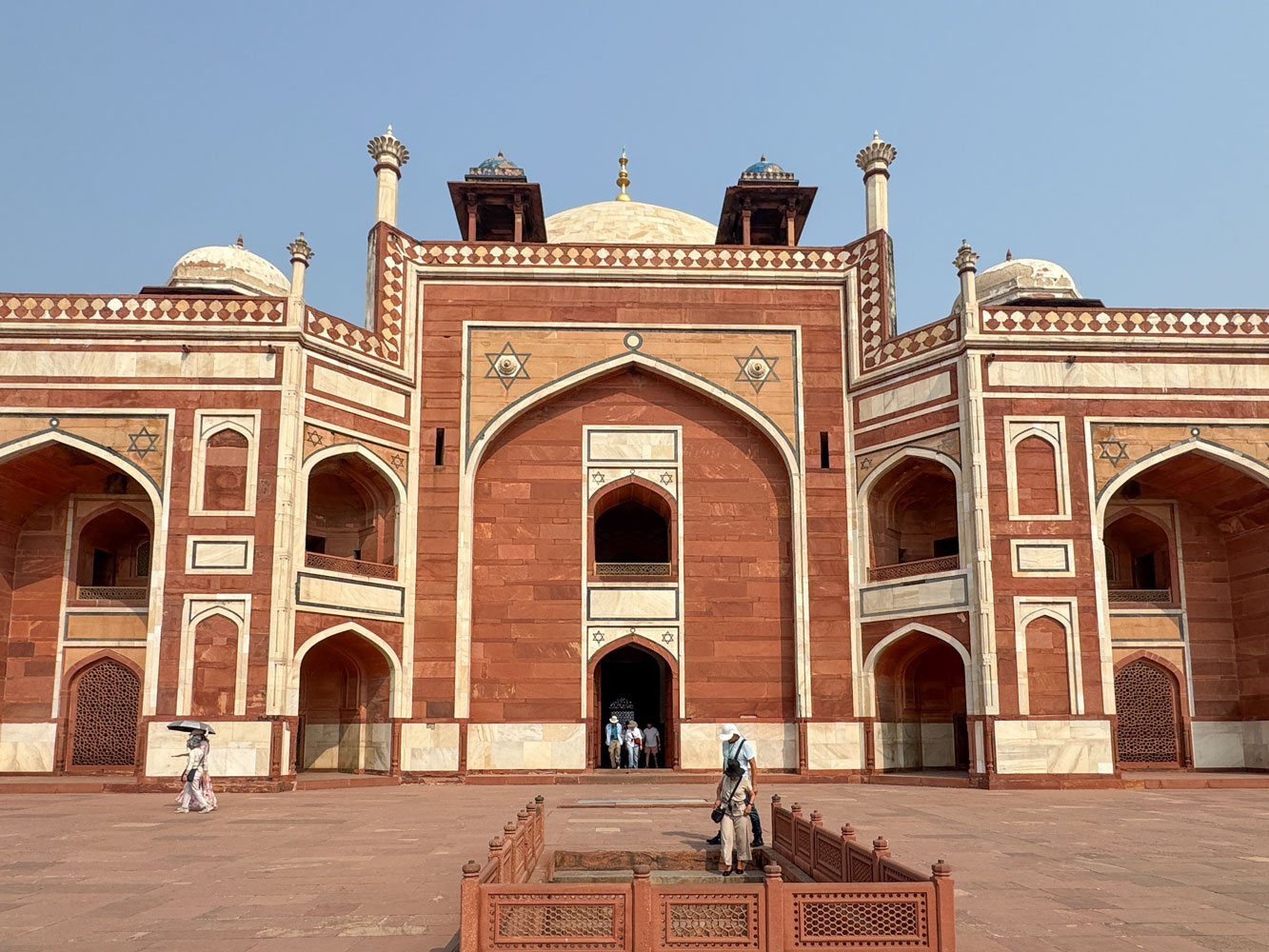
This is the royal barber's tomb (Nai Ka Gumbad) seen from the main tomb.
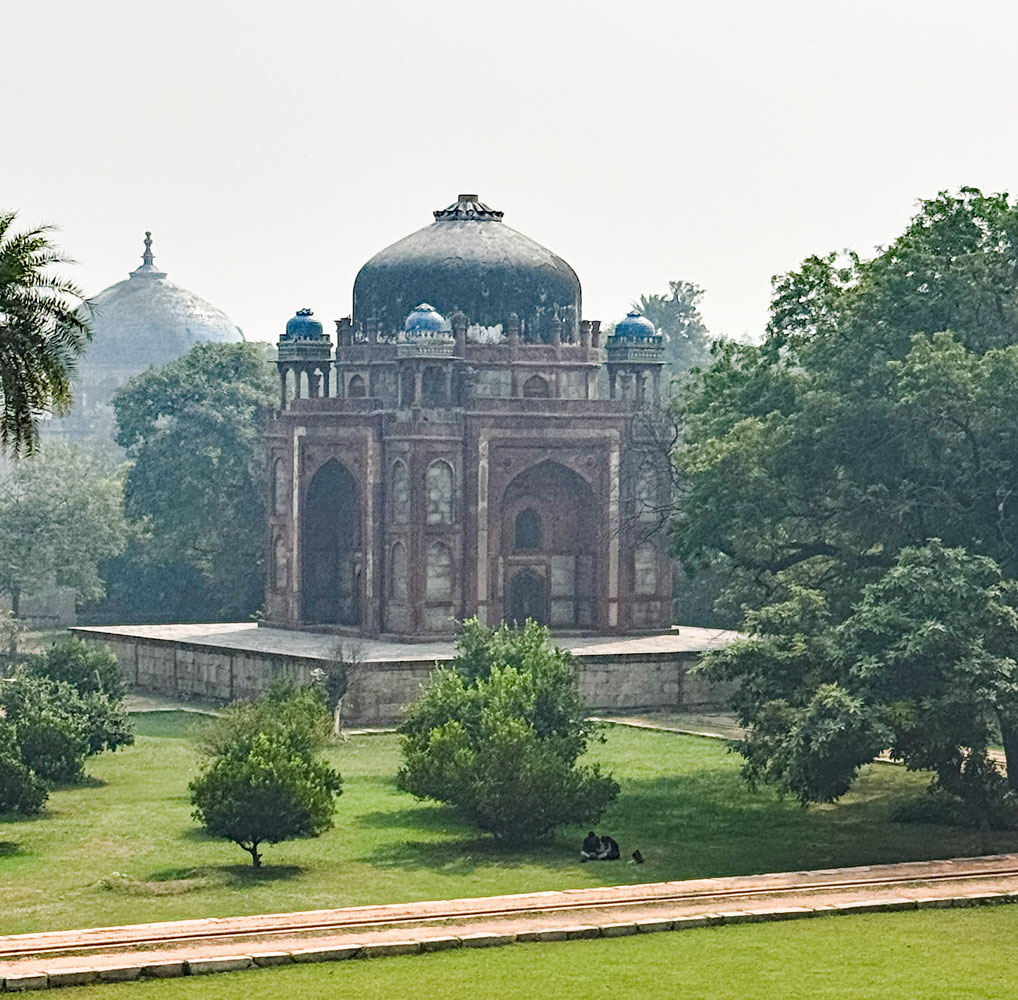
Looking toward the entrance gate from the tomb.
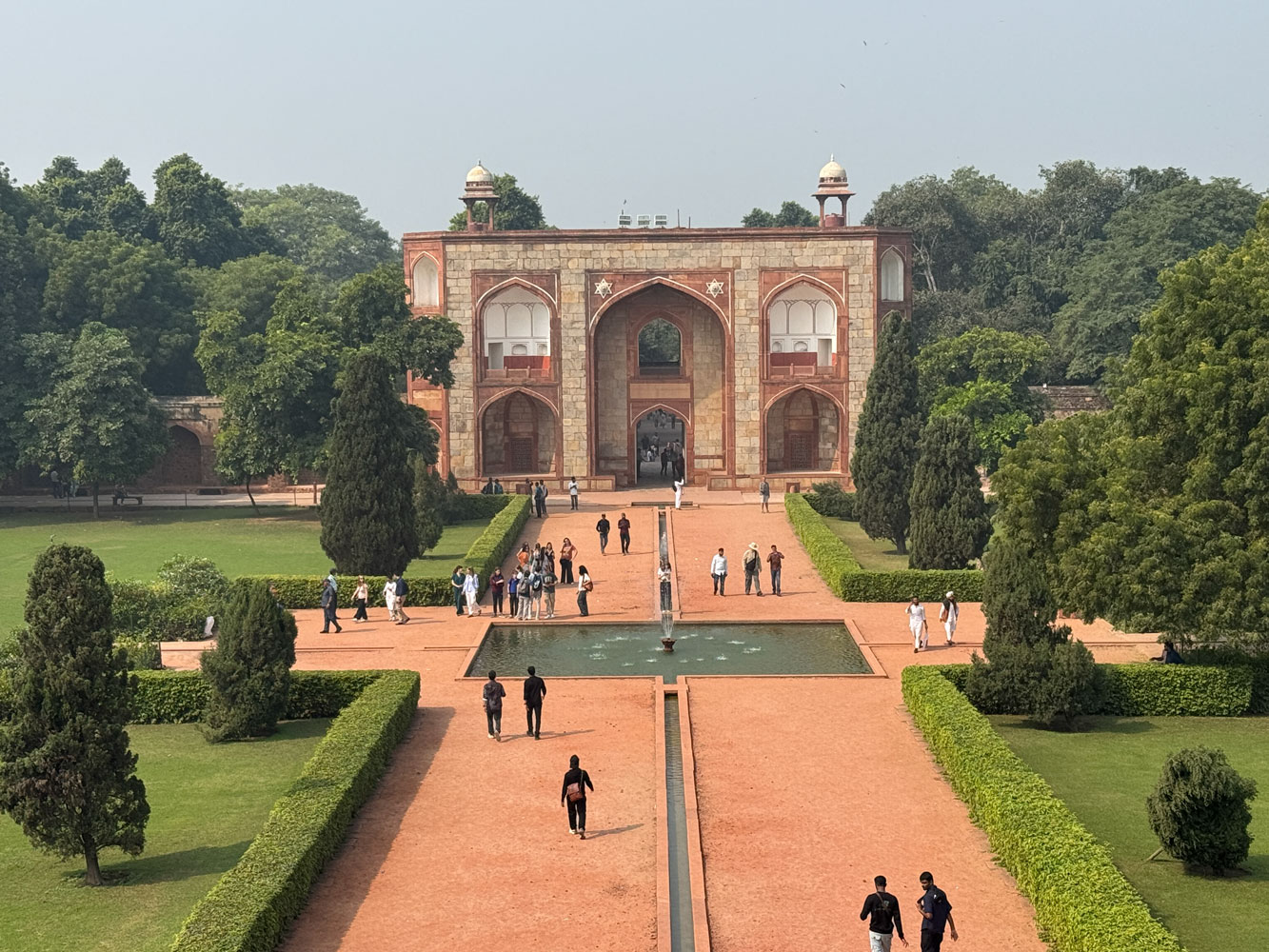
We left Humayun's tomb and drove to the Qutb Minar Complex, which has the huge Qutub Minar. The tower is used as a minaret.
Here's a view of the tower.
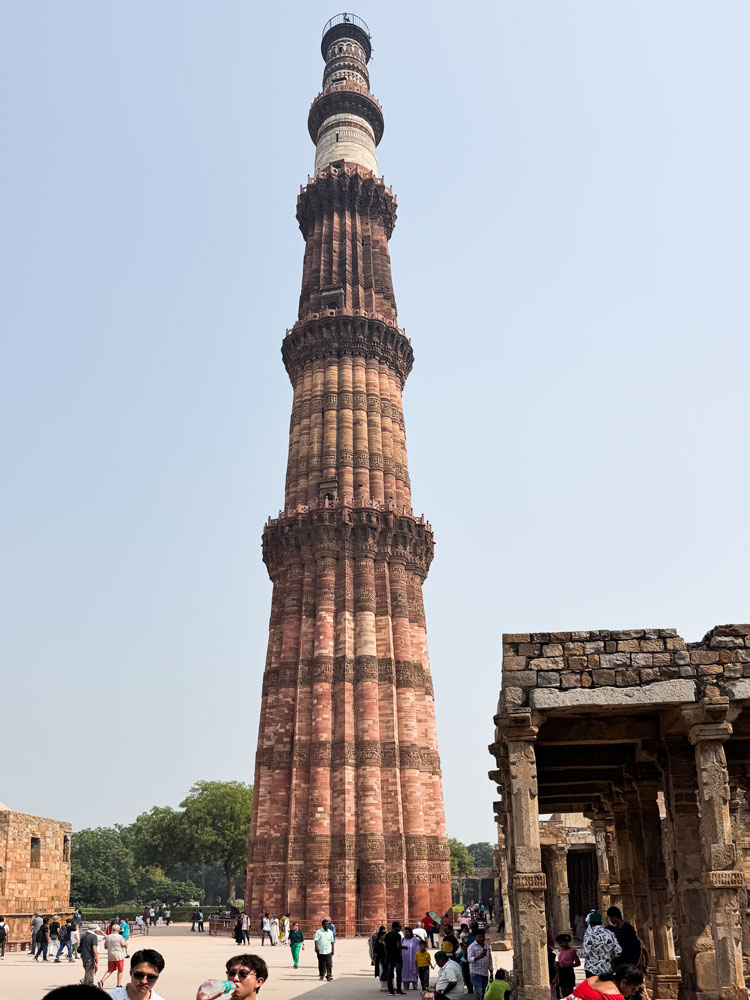
The tower is 72.5 meters high (238 feet) and contains 399 steps. It was built between 1199 and 1220. No, they wouldn't allow us to climb to the top:-)
A closer view of a portion of the tower, showing some of the detail work.
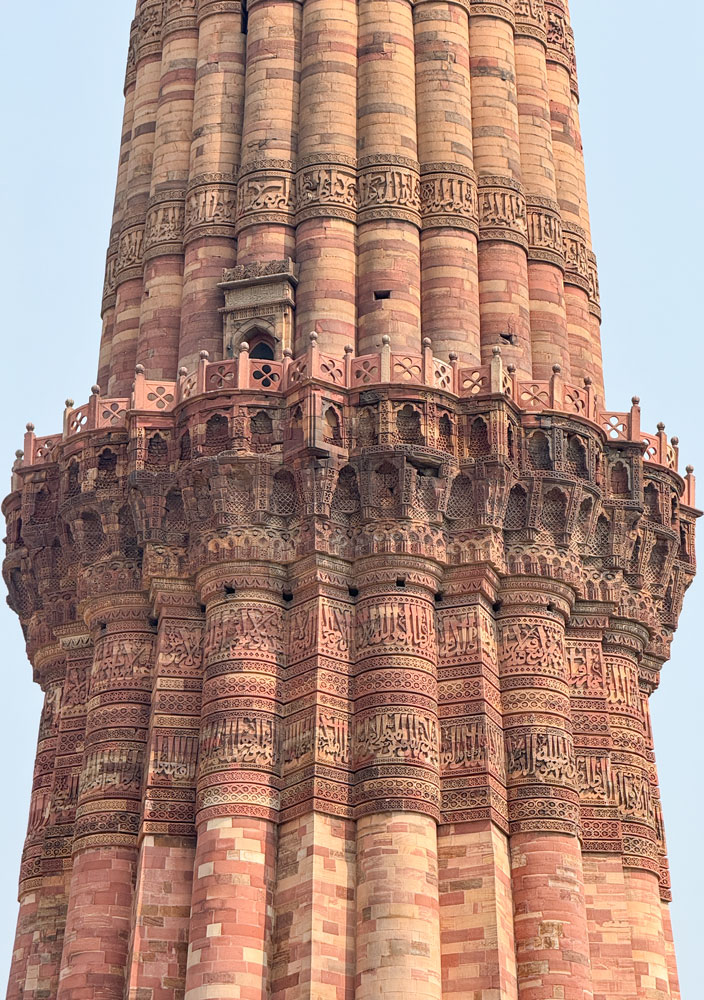
After our visit to the Qutb Minar Complex we went to lunch at Olive Restaurant for Italian-style Indian food, and shared a table with Lauri and Lori.
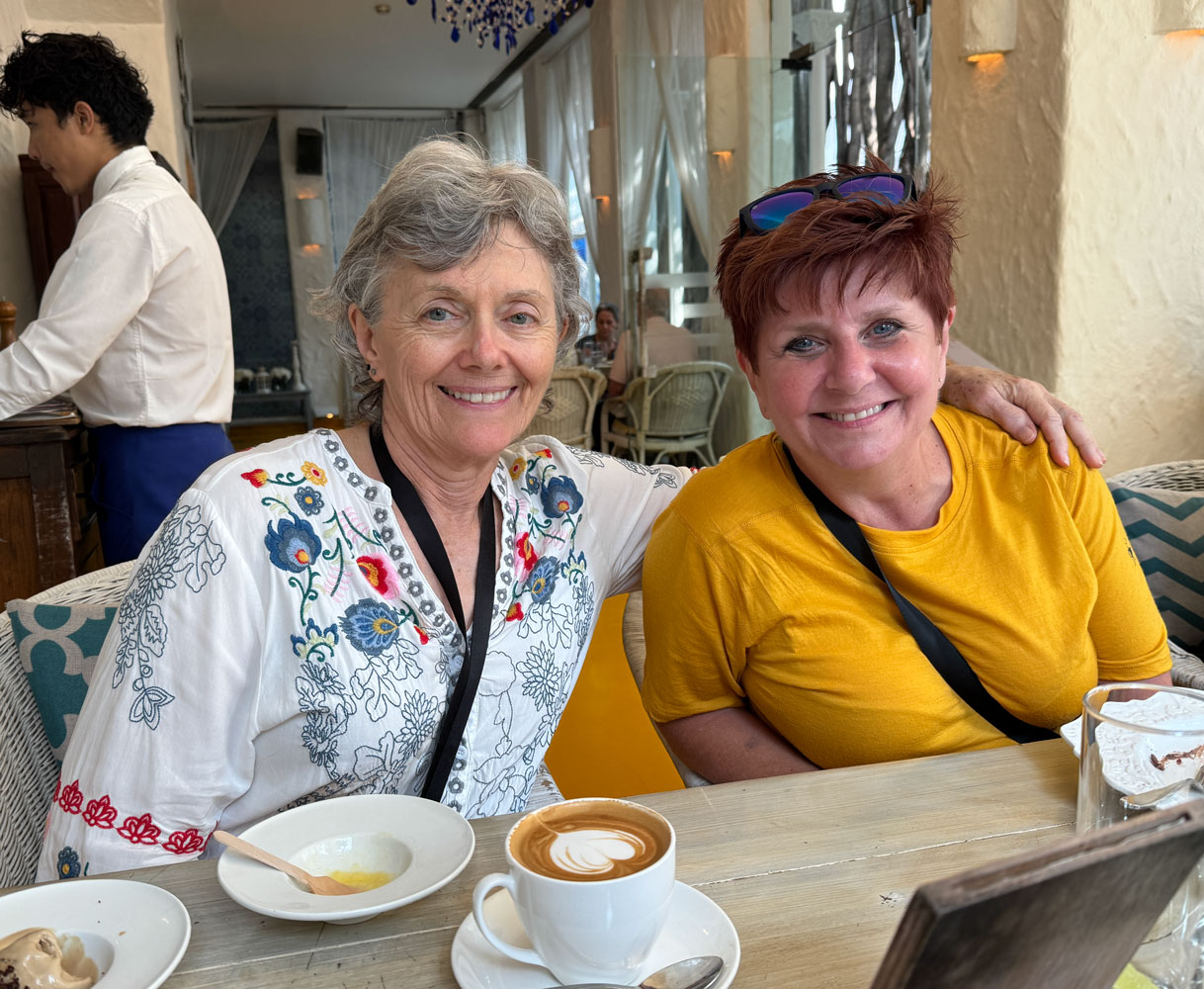
After lunch we all went back to the hotel. Judy and I went to bed early and skipped dinner. We have an early departure for Varanasi tomorrow.